Burning Empires by Traveller
Invasion of the Power Armored Body Snatchers
Original SA post Burning EmpiresInvasion of the Power Armored Body Snatchers
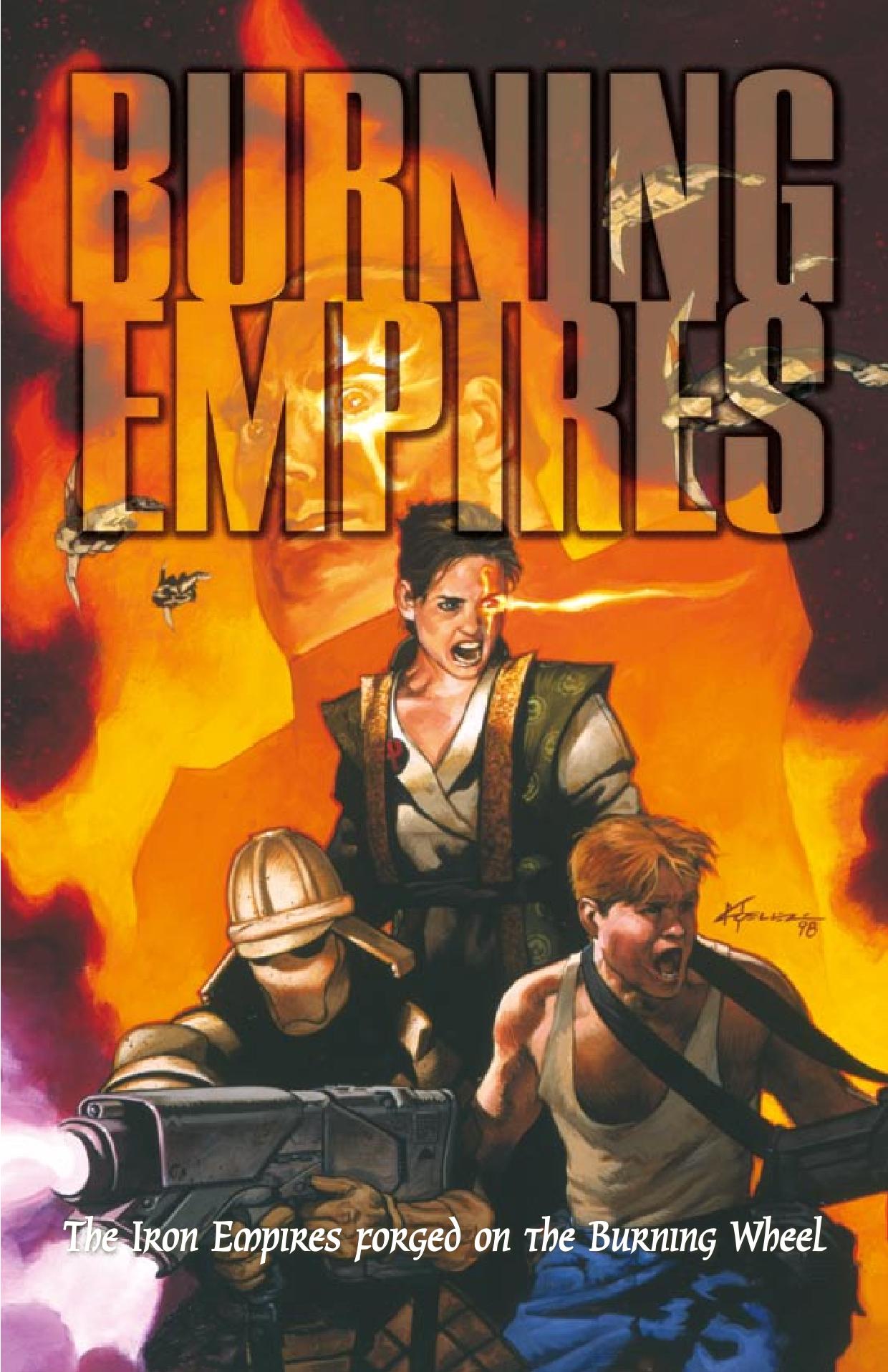
Note the Bright Mark in her face: it glows like that when she uses her powers.
Welcome to a new FnF! This time, we're going with a game that's not awful and probably doesn't qualify as obscure, since it has won a number of awards. Burning Empires is a 2006 RPG by Luke Crane, he of Burning Empires and Mouse Guard. It is based in the Iron Empires comics by Christopher Moeller, which portray diverse stories of people living in the aforementioned Iron Empires and their struggles - particularly against the dreaded Vaylen. Before we dive into the game, we get a foreword from Moeller himself detailing the influences of his setting: JRR Tolkien, Barbara Tuchman ( A Distant Mirror ) and Marc Miller's Traveller foremost among them, also including the work of Moebius, Enki Bilal, Robert Heinlein and others. And then we're on!
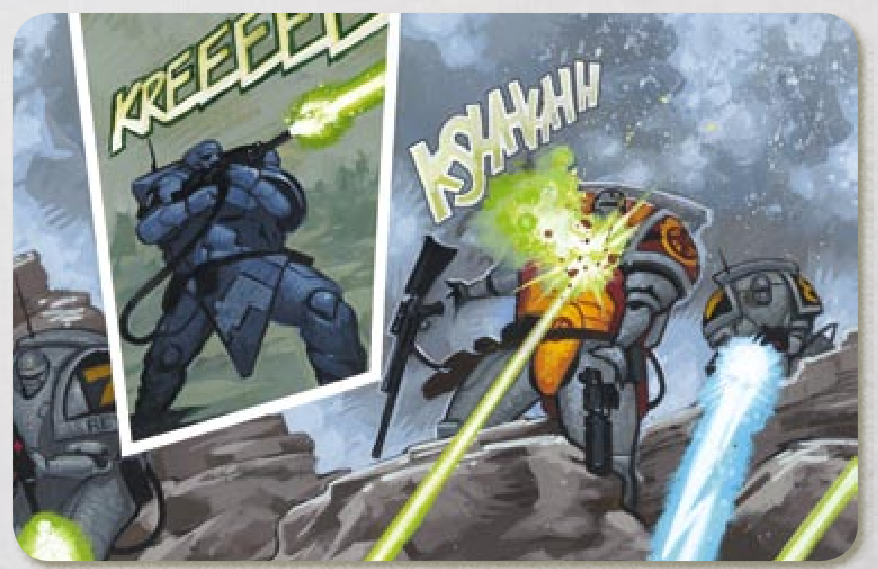
I know, the power armor is very 40Kish. Art is mostly taken from the comics, with some original sketches by Moeller to fill things out.
The Iron Empires are far-future nations, remnants of a once great star empire that is now long gone. Humanity is on the decline, frontiers contracting rather than expanding, and the world is ending even if the masses do not realize it. From afar, maddened survivors race to the central systems, bringing dire warnings of the horror beyond the void that hungers for humanity, but those warnings go unheeded. The Vaylen , however, are no mere fiction - they're all too real. Alien worms surgically implanted into human bodies, they want us because only by possessing humans can Vaylen truly be sentient. They want to be us, and so they infiltrate and subvert the outlying worlds, or outright wage war upon them if that's what it takes to capture humans for their own uses. A Burning Empires campaign chronicles a single world under Vaylen attack, and the movers and shakers within it. Normally players will be on the human side, while the GM runs the Vaylen, but this isn't set in stone. Mechanics ensure that the GM doesn't abuse their power, but ultimately both sides are playing to win , and by the end of the story either the planet will drive the Vaylen off or fall to the worm, with no middle ground.
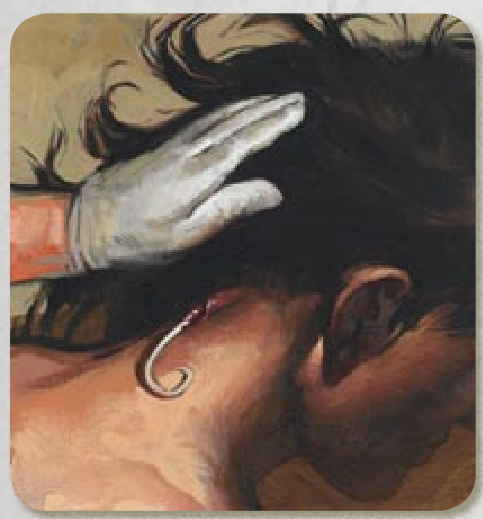
Getting a worm implanted into you sucks - and there's no way back once it happens.
The campaign itself is pretty structured. A full campaign lasts around 18 sessions of play and is divided in three parts called Phases . Infiltration is when the Vaylen are just arriving into the planet and making inroads, Usurpation is when the Vaylen have an established power base and focus on hulling key individuals to secure their position, and Invasion is when the Vaylen force the issue with a full-scale military invasion. Each session is divided into a number of maneuvers, which are the goals and adventures that players set for themselves, and are also moves within the greater strategic game; and within each maneuver there is a number of scenes , which are the least unit of gameplay and where the characters actually get things done. Each character gets in at least one major scene per maneuver. Like in other Burning games, BE uses only six-sided dice, which are usually gathered in pools and rolled. Each die that comes up 4+ is a success. An exponent is just the value of a stat, skill, or what have you - the dice to be rolled when the ability in question is called on in a conflict. Rolling dice is called a test , and no character can affect another character without a rolled test backing the action up. An obstacle is the number to be matched or beaten with your successes to win a test. We even get a handy probability chart to gauge how hard a given obstacle is for a particular dice pool, which is neat. Then we have a glossary of some terms used in the setting, but we'll see those as we go through the book. Notes: iron is the setting's name for its signature power armor. Also, psychologists are how psychics are called in the game, so I guess Scientology was right to fear them

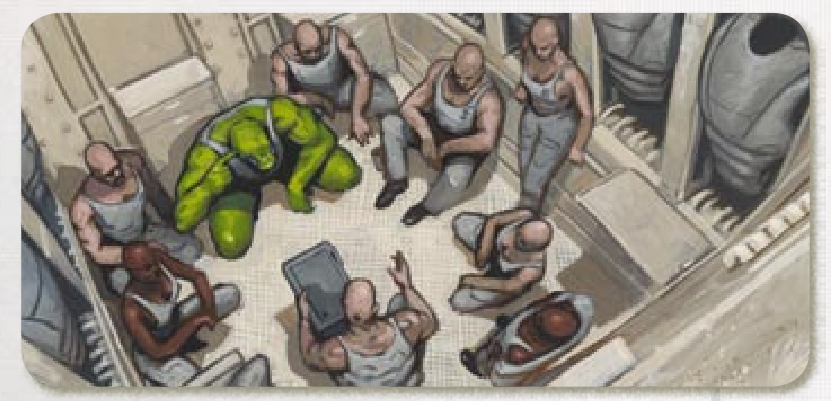
Green dude there is a Kerrn. Kerrn are plant/frog people and they own.
First of all (the very first session, in fact) players will gather around the table and create (or, in BE terms, burn ) the world to be fought for. The GM is also counted as a player for this. How this session plays out determines how hard each side will have it to succeed in each phase and what characters can be generated for the campaign. Players decide which side to play, then it's on to the world! First, we get a broad overview of the different Iron Empires, and it bears noting that there isn't a defined "setting" section in the book: you are supposed to piece out how the setting works from these sparse descriptions or things like the skill lists for each lifepath (no, seriously), which shouldn't be a complete surprise to those who have read Burning Wheel before; all the same, you should probably read Faith Conquers and Sheva's War, the two major trades for the comics, before diving into BE.
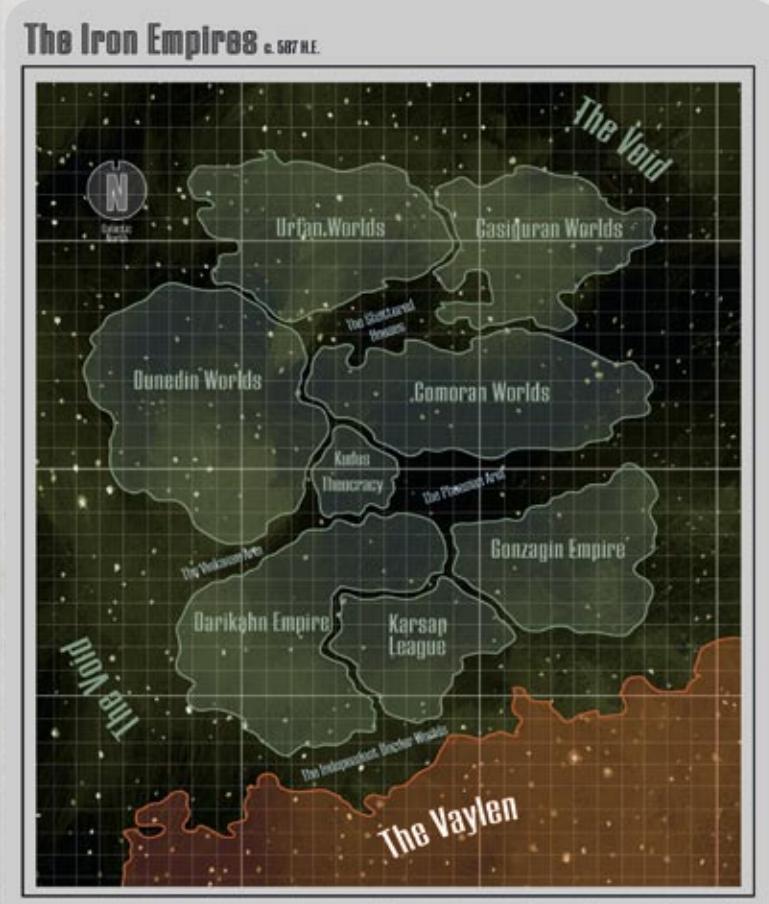
Map!
Actual world generation begins by selecting the location of the world. Is it an old core world, an interior world distant from the borders, an outworld on the frontier or a void world lost in the fringes? We don't see how the Infection (i.e., strategic level play) rules work just yet, but each of these options adds a number called Disposition to each phase for each side - a core world gets less points for the human side in Usurpation than the Vaylen, but it gives the humans a lot points for Invasion, that sort of thing. Then, atmospheric conditions - the world can be alien life supporting (i.e., hostile both to human and Vaylen mutants), human life supporting, non-life supporting and partial life supporting. Hydrology is next: the world can be predominantly liquid, or predominantly land. Topography - artificially created environs (for alien or non-life supporting atmospheres), naturally rugged/broken terrain, naturally habitable/tame terrain, or a broad range of conditions (Earth-like, basically). Tech Index is where the setting shows its Traveller chops: the measure of the planet's technological development. Sub-index worlds have 20th-century technology, and crucially cannot project power into space. Zero-index worlds have 21st or near future tech, and are considered "quaintly insular" by galactic powers. Low-index worlds have access to the setting's signature tech, and this is where most of the worlds of the Iron Empires fall into. High-index worlds are rare, perhaps only a handful of worlds in the entire setting are high-index, but their tech is truly wonderful - transhuman modification, matter converters, ansibles, the works. Dominant form of government : a civilian commune (democracy! a real rarity), imperial stewardship, lawless/anarchic, merchant league, military dictatorship, noble fief, theocracy. Then, players must decide if the world has factions : a yes/no decision, and one that only gives Vaylen points at first
 Factions are special in that their points aren't added to the initial dispositions: they must be persuaded or subverted to work for your side in play. There are twelve distinct factions to choose from, and one can be added for each player if they so desire. Some choices are mandatory depending on certain previous choices (an alien-supporting atmosphere world must have Indigenous Life Forms) and two, Freemen and Spacefarers, can be removed by group agreement. The factions are Civilian Communes, Cult Churches, Imperial Bureaucracy, Indigenous Life Forms, Kerrn Diazspherah, Merchant Leagues/Corporate Entities, Military Junta, Organized Crime, Psychologist Foundations, Rebel Line/Loyalists, Slaves and Serfs, and Theocratic Institutions.
Factions are special in that their points aren't added to the initial dispositions: they must be persuaded or subverted to work for your side in play. There are twelve distinct factions to choose from, and one can be added for each player if they so desire. Some choices are mandatory depending on certain previous choices (an alien-supporting atmosphere world must have Indigenous Life Forms) and two, Freemen and Spacefarers, can be removed by group agreement. The factions are Civilian Communes, Cult Churches, Imperial Bureaucracy, Indigenous Life Forms, Kerrn Diazspherah, Merchant Leagues/Corporate Entities, Military Junta, Organized Crime, Psychologist Foundations, Rebel Line/Loyalists, Slaves and Serfs, and Theocratic Institutions.
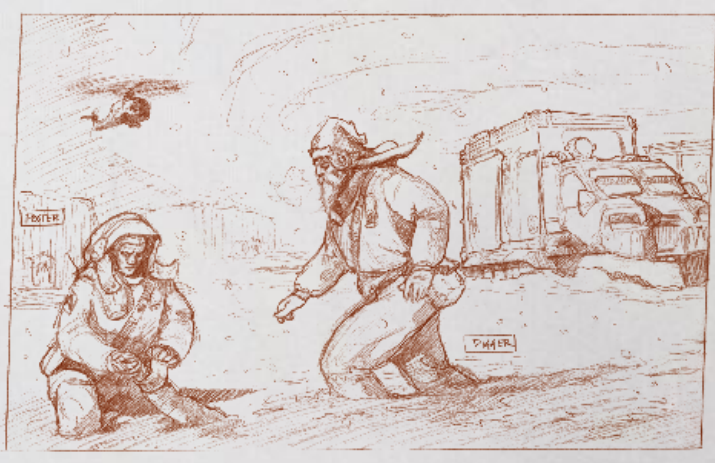
One of those sketches I mentioned.
After this, the group selects the world's dominant military : a levy (conscripts), the Lords-Pilot (the nobles of the Iron Empires, commanding Hammer [spacecraft] and Anvil [infantry/iron]), a professional volunteer force, or a religious order or orders. Then it's time to decide the world's attitude towards the Vaylen : educated/informed (outworlds/void worlds only), hysterical fear, ignorant, indifferent, paranoid or having suffered personal experience of the worm (again, outworlds/void worlds only). The world's primary export or industry : agriculture, industrial capital, military capital, raw materials, refined goods, services/skilled labor, unskilled labor. Level of planetary quarantine: no quarantine, standard quarantine, advanced quarantine and strict quarantine. Level of economic restrictions : unregulated, loosely regulated, moderately regulated or tightly regulated. Then, the Figures of Note : these are important movers and shakers for each side in each phase, so six in total. These posts will more often than not be filled by PCs for their side. Note that a Vaylen Figure of Note doesn't have to be Vaylen, or even collaborating with the Vaylen - they only need to not be actively helping the human cause. Whichever side comes up with a name for the world gets one point for their disposition in a phase where they're at a disadvantage.
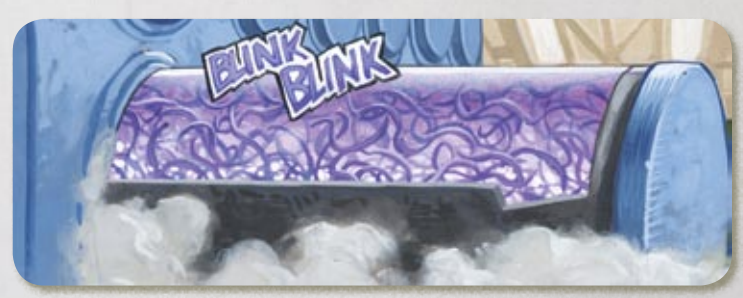
Economic regulations and quarantines might seem like overkill detail until you remember that Vaylen infiltrators can literally import worms from space if allowed.
Whew, that was long! Something that bothers me is that the system can be gamed to give one side or the other big advantages, by min-maxing choices for best disposition, and given the somewhat adversarial nature of the game this feels a bit iffy. It even comes up in the world burning sample when Luke complains to his players that they're selecting "all the best stuff"
 In actual play, however (I've only gotten as far as character burning in BE, I'm afraid
In actual play, however (I've only gotten as far as character burning in BE, I'm afraid
 ) I've seen that people select stuff for flavor rather than minmaxing, but that's just my experience. Now, If anyone has ideas for a world to burn so that we can make characters later, I'd like to hear them.
) I've seen that people select stuff for flavor rather than minmaxing, but that's just my experience. Now, If anyone has ideas for a world to burn so that we can make characters later, I'd like to hear them.
Blood under the snow
Original SA post Burning EmpiresBlood under the snow
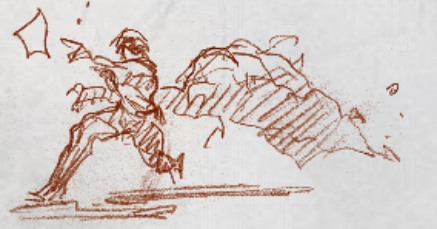
That's just a napkin doodle Moeller come on
I liked Nessus idea the best, so let's go with that.
quote:
Packer's World, a forest planet settled by Twin Peaks fans. (Merchant/lumber-export based.)
Tundra+Muslim theocracy.
A tweak and a run through the World Burner later...
code:
[*]Name: Packer's World
[*]Location: Outworld
[*]Atmosphere: Human Life Supporting
[*]Hydrology: Predominantly Land
[*]Topography: Naturally Broken/Rugged Terrain
[*]Tech Index: Zero Index
[*]Dominant Government: Theocracy
[*]Factions: Yes. Civilian Commune (0/3/3), Cult Churches (0/1/5), Merchant League (2/0/4), Theocratic Institutions (3/1/2)
[*]Predominant Military: Religious Order
[*]Quarantine: Basic Quarantine
[*]Economic Regulations: Moderate
Native Settings: Human Freeman, Human Outcast and Criminal, Mukhadish Underworld, Vaylen Vaylen.
Mukhadish Wild, Human Theocracy, Human Commune, Human Merchant League.
Restricted Goods and Services: Weaponry, Sex Trade, Military Manufacturing, Psychology
Starting Disposition:
Vaylen: Infiltration 23, Usurpation 28, Invasion 27
Human: Infiltration 21, Usurpation 25, Invasion 25
Figures of Note: ???
I can see it now: a cold world, continents of hardy forests and tundra. Cold, bleak, stark. Life is gray and full of duty, as the Mundus Humanitas preaches it - but under a thin layer of snow there is a vibrant black market, an underworld of schemers within the church, cults that wish to replace it as the primary power, disaffected intellectuals and workers that want a say in the ruling of their world, and the constant push of the merchant/corporate clade for greater freedoms and the lifting of any restrictions that keep them from filling their purses. And then the worms come. Slight advantage to the Vaylen side, but it could be tipped one way or another fairly easily.
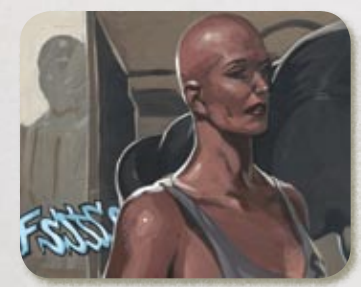
There's an actual reason for having bald characters all over the place in Burning Empires: the surgery used for the "crucis", the cross-shaped implant necessary to wear iron and pilot spaceships, has as side effect the loss of all hair in the head. There are illegal crucis that let you keep the hair but, well, they're illegal. Mostly because crucis is something reserved for the nobility and its closest servants. This also means that wigs are in high fashion among the nobility.
There are six stats in Burning Empires: the mental ones of Will , Perception , and the physical ones of Agility , Speed , Power and Forte . Pretty self explanatory. There are also certain attributes: Circles is the character's social influence and ability to call on people, Resources is the character's economic and financial viability, Steel is the character's nerve and poise, and Mortal Wound determines how much damage the character can take. Skills are, well, skills. Characters also have technology (that is to say, gear) and a select few can use capital-P Psychology.
The interesting ones here are Beliefs and Instincts . A Belief in BE is a fundamental idea important to the character. It combines the outlook of the character as well as the goal of the player. For instance, "Nothing matters to me anymore, so I might work with the enemy if it suits me" is a Belief. They're not vague "the world is doomed" things - they are springboards of action. "The world is doomed unless I step out of the shadows and command the court into action." It's important to think of them in a meta way: in that last Belief, you (as a player) are saying that you want issues of courtly intrigue in the game. A Belief should never be a passive thing - it must get the character into conflict and trouble. Instincts, on the other hand, are things that you want your character to do or not do, even if you don't explicitly say so. "If I'm travelling alone, carry a gun." "Always remain Inconspicuous in public." "Keep the Sergeant nearby.". Finally, Traits are stuff your character either has or doesn't have, like a particular character trait (bald, effeminate, aggressive, elitist and so on) that is there for color, or something that affects play like having the implants to handle power armor and ships, being fearless enough that it counts mechanically, or having noble blood. The latter include Call-On traits (once a session, the trait can grant rerolls for a certain skill's failed dice in a test) and Die traits (which modify an ability or grant new ones to the character)
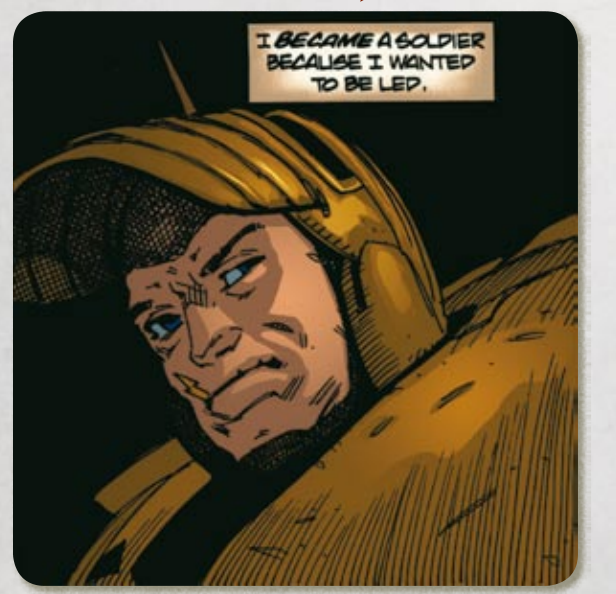
Soldier boy here doesn't look too happy.
To create a character, we start with a basic concept. Note that we're strongly to create a character at the top of the food chain: not just a soldier, but a general. Not a spy, but a planetary spymaster, and so on. Then we look at the settings available to the planet. A setting is a collection of related lifepaths for a character to follow during chargen. As we create a world for play, we open or close settings for characters, which is why the world has to be created before the characters. Depending on these choices, a setting can be native , non-native or simply be unavailable. Following a lifepath takes a number of years of your character's life; when changing settings to a native one, the character must spend a year, and two if it's to a non-native setting. These settings are grouped into four stocks (races): Human, Vaylen, Kerrn and Mukhtadish. Vaylen settings are always considered to be native.

Poor Faith. Faith is the bald guy there, incidentally.
A lifepath comprises the time it takes to follow, resource points (totalled at the end of this step to purchase many different things), circle points (used to purchase reputations, affiliations and relationships), stat points (added to the character's starting pool) skill points and skills , and trait points and traits. Most characters should start play with 6-7 lifepaths. Eight lifepaths are permissible if they feel right, while anything above that should be scrutinized and have fat cut off until the core concept remains. A character's first lifepath should be a Born lifepath (for instance, Born Freeman), but it is recommended when starting to pick the last lifepath first and then work backwards to see how the character gets to their final form. A lifepath can be taken more than once, but from the third time onwards its benefits are diminished. After this step, the total age of the character is counted, which gives the starting stat pool for the character. Skill points can be regular (used to buy skills from the character's own lifepaths) or general (used to buy skills that the character's lifepaths don't have). The general points are set aside, then skills are bought, or opened. Opening a skill gives it at the exponent its base stat is at, or ([base stat 1 + base stat 2]/2 rounded down) if it's a skill with two different roots. The first skill in a lifepath is mandatory to open, but not to advance; unless the character already has it, then it's the second one, or the third and so on. After all normal skill points are spent, then general skill points can be used to open or advance skills in the character's list or the general list. By default, skills and stats are capped at 6, with a suggestion that stats should not start at less than 3. It's important to think how the character will fit in each phase, so there's a suggested list of skills to have to be useful as the game unfolds and the character enters into conflict with others. Trait points work in a similar manner (buying the lifepath's first trait first, etc.) Buying a trait from the character's list costs one point, while traits bought from the general lists have varying costs - so sometimes you'll want to get a lifepath just for a cheap trait you need. It's much easier to become a Hammer Lord if you are involved with Hammer forces, for instance. There's also a number of traits for each stock that come free. In the case of humans they have a number of cultural traits depending on their origin, one of which must be taken for free.
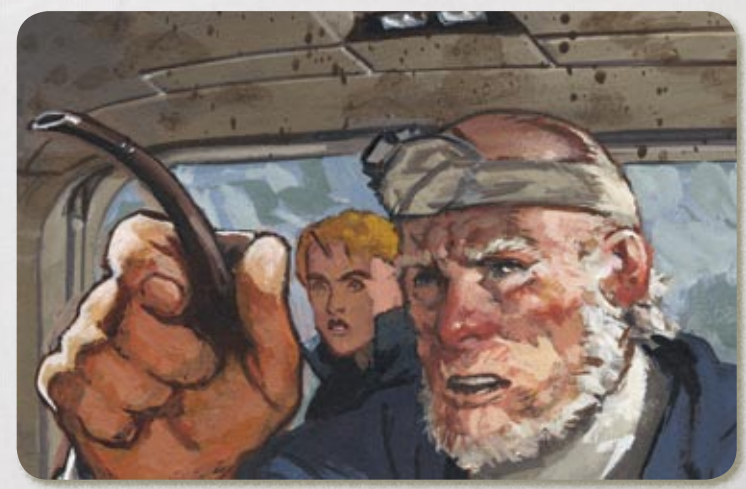
Back in my day, son, the body snatchers didn't muck around with this 'worm' business.
Resource points are more involved. First, determine what your character has depending on their rank and station. At this point, this is just color: you can say that you have a gun but until you actually buy it with resource points, it does nothing in play. One resource point buys a basic piece of gear or hard technology, while two points purchase an advanced or illegal piece of tech. One point can also be spent in modifying technology with new traits, but we'll see that in the Technology chapter. The more advanced the world is technologically, the more bang you get for your resource point. Some items require certain traits - you need to be Anvil Trained to purchase anvil armor, Iron Trained to purchase iron, and similar. The GM can also assign gear for free to the characters depending on the scenario - if all the characters are military in an Invasion, they can expect to get standard kit from their army. A resource point can also buy property - a fortress, a business, a safehouse. Each point spent in property also gives one trait to the property - security systems, defenses, etc. What resource points aren't spent on stuff become the character's Resource exponent. It is possible to start with a Resources of 0, which will require the character to get a loan in order to advance. The GM does not have to spend resource points right away for their characters, they can do that as the need arises.
The Circles exponent starts at half Will, rounded down. Its scope is determined by the character's lifepaths: anyone that they could have met as they lived through the lifepaths is a potential target for Circles. Three circles points increase the Circles exponent in one. One circles point gives one die of Affiliation (power or direct ties with an organization), and the character may have multiple affiliations. They are rated in dice, from one to three, with one being small or obscure groups up to three for planetary-scale groups. Some traits also grant free affiliations. Circles points can also buy Reputations , which are also rated from one to three dice and bought just like affiliations. 1 die tells the world you're the best shot in the King's Guard. 3 dice tells the world you're Osama Bin Laden. Some traits grant free reputations. Then Relationships : a relationship is a GM-controlled character that the player wants in the game no matter what. All characters start with a free relationship, and they must have two relationships at the start: one with a figure of note in the current world, and one with a friend, relative or ally in the other side of their struggle. These two can be combined into one: a friend that is a figure of note for the other side. Each additional relationship costs two circles points, but this cost can be reduced to one point if the relationship is made complicated : the relationship works for the bad guys, or is an enemy or rival of the character. Only really important people should count as relationships, everyone else is in the Circles. Fellow characters cannot be relationships, and it is assumed that all characters know each other prior to the start of the game. If you want a gang, crew or group of followers, then purchase an affiliation with the group, a reputation as its leader and a relationship with the second in command. A bodyguard or other close retainer costs two circles points even if the relationship is complicated, but they're burned as full player characters with two fewer lifepaths than the character and exponents limited to 4. These subordinates must also pay for a relationship with the original character as well as all of their gear in chargen. Circles points cannot be saved. The GM saves the circles points for later, and they don't have to buy relationships for their figures of note with player characters that have bought them already.
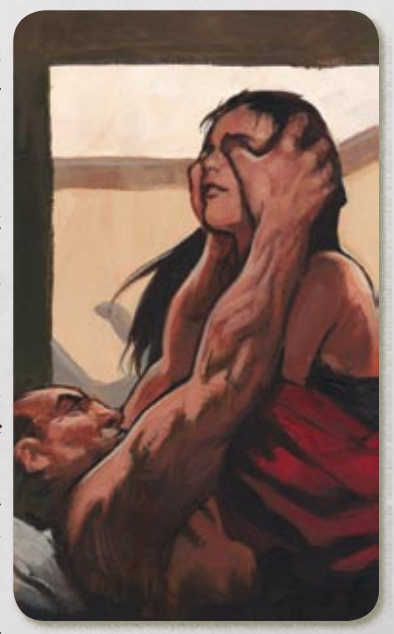
"Mmm, yes, squish my eyes out with your thumbs." Paraphrased from the comics.
Steel starts at 3 and increases or decreases based on a small questionnaire. Has the character taken a soldier-type lifepath? +1 Steel. Has the character killed by their own hand? +1 Steel. Has the character lived a sheltered life, free of violence and pain? -1 Steel. And so on. Hesitation , the base Steel obstacle, is 10-Steel. Mortal Wound is the average of Power and Forte rounded down, plus six. This is then marked on the Physical Tolerances scale, which we'll touch on later. Other derived stats are calculated here: Superficial Wound (from H1 in the scale, half Forte rounded down), Injured (Superficial + half Forte rounded down) and Maimed (Mortal minus two) Then think of a name, and you're done!
Artha comprises three pools of points that characters get by playing up their Beliefs and accomplishing their goals. Again, we'll see what they do later, but a 7 LP character will start with 2 Fate artha and 1 Persona artha. The GM gets general pools for all of their characters depending on the total number of lifepaths the opposition takes for all of their characters.
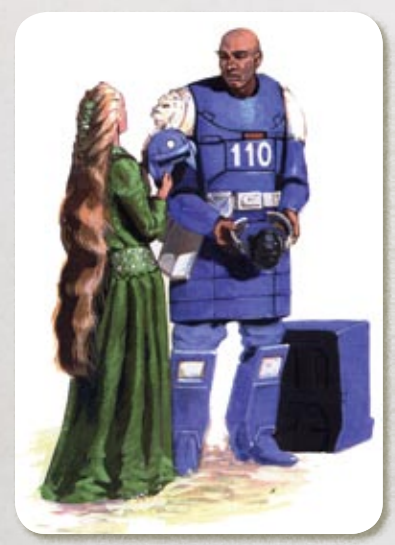
My lord, your operator gear.
And with that, it's on to settings! We'll start with the human ones first. For humanity, it is the year 597 of the Hanrilke Era. The Hanrilke Empire is long gone, replaced by the fractured, squabbling Iron Empires. Humans get a stock trait, which is uh, Human (stat maximum 6 for physical stats, 8 for mental stats). The eight Iron Empires with attendant cultural traits are the Casiguran Matriarchy, considered suspicious and even a cult by the Mundus Humanitas (Deferential, Matriarchal, Patriarchal, Private); the Comoran Worlds , not a nation as such but a collection of culturally related systems, highly religious but also home to the Cyrean splinter group of the church (Pious, Cyrean Heretic, World Weary); the Darikhan Empire , ruled by the most powerful noble house of the Empires and one with a claim to the Hanrilke throne (Darikhan Loyalist, Agnostic, Turncoat, Baroque); the Dunedin Worlds , zealots on a crusade against the Darikhans for religion and loot (Crusader, Crypto-Missionary, Opportunist); the Gonzagin Empire , rivals to the Darikhans for the throne, but less puissant (Austere, Cniht*); the Karsan League , tolerant of psychology, pursuing freedom of thought and on the frontlines in the galactic south against the Vaylen (Kunmai*, Technical, Formal); the Kudus Theocracy , under the direct control of the church (Devout, Atheist); and the Urfan , poor worlds in the north away from everything, conservative and constantly fighting off pirates and intruders (Inscrutable, Redoutable, Remote)
The human settings are:
-
Nobility
: the noble class of the Empires.
-
Stewardship and Court
: the imperial bureaucracy and government.
-
Hammer
: the noble space navies.
-
Anvil
: the ground forces.
-
Theocracy
: this represents the rulers of the Kudus Theocracy and their servants, as well as any other theocratic state or institution in the rest of the setting.
-
Merchant League
: oligarchs and corporates, and their staff.
-
Commune
: a state or organization that believes that the citizens are the ultimate root of legitimacy. These represent people actively interested in maintaining the Commune, regular joes are Freemen.
-
Psychologist Foundations
: Psychologists are mistrusted and envied in the empires, so they turn to secret cabals for support. In the Karsan League, they have an open foundation, the Circle of 10,000.
-
Spacefarer
: the crews and captains of civilian spacecraft.
-
Freeman
: the working class of the empires.
-
Servitude and Serfdom
: serfs, slaves and other unfree workers.
-
Outcast and Criminal
: the fringes of society.
Cniht are those who identify the Gonzagin old guard of the nobility and the house's claims to the throne. Kunmai are Karsan imperialists with their own claim to the Hanrilke throne.
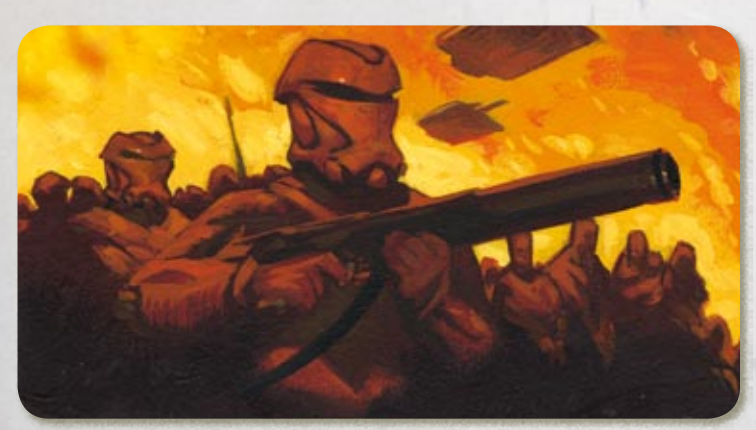
Totes the good guys.
The Vaylen are a lot more varied in body shape than humans, given that they have enslaved and created many organisms in their expansion from the galactic south. But they're not monolithic: they have clans and castes they belong to. The one thing where all Vaylen stand together is their desperate need for more host bodies: trillions of worms lie dormant, waiting for the surgery that will give them true life. The name 'Vaylen' itself refers technically only to a host infested by the worm; the worm itself is called a Naiven. A Naiven has as traits Alien Control (can break its link to the damage receptors of a host to better endure pain), Encoder (can record all of its memories and most of its mental skills during host possession in the worm itself, and bring them with it when changing bodies), Psycho-Endoparasitic (basically, they can do the whole body snatching deal) and Worm (they're worms, yo). And yes, as explained earlier, the first organisms they possessed were jellyfish that the Naiven could bore into easily, and whatever happened in the past it is certain that the first human/Naiven organism did not happen by chance. Someone, or something must have cut ( hulled in BE terms) that first human open.The Vaylen clans are Amedhyen (the unwashed masses), Annelida (who believe to descent from the greatest Vaylen warriors), Aadau (honorable industrialists widely believed to have taken the Vaylen from their dark ages), Meshhen (harkening back to the first Ksatriyen that led the Vaylen to conquest), Vibhuuten (who claim to be the discoverers of humanity) and Yaadasahm (the first to become Vaylen by usurping the Makara race). Each clan has a Born lifepath to start off, and they also decide what settings/castes are available: Amedhyen have to start as Shudren, for instance.
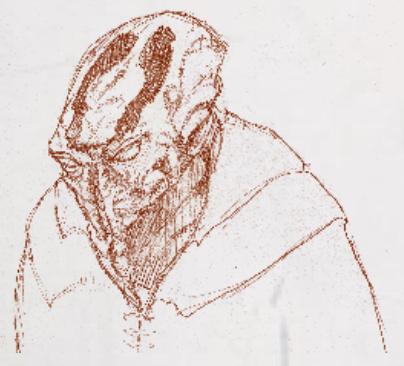
Some Vaylen don't have the time or patience for luxuries like 'having a nose.'
The Vaylen settings (their castes, really) are:
-
Human
: the Vaylen want to be human, desperately, but they just don't think like humans do. The Human caste represents what the Vaylen believe human society to be, and how they reenact it. Their lifepaths are very archetypal: the Child, the Ascetic, the Princess, the Philosopher King.
-
Ksatriyen
: the warriors. These don't take human bodies, but customized combat bodies. They're strong enough to become the ruling caste by force, but they're just as obsessed with humanity as anyone else.
-
Vaishyen
: the administrators of the Vaylen farm worlds, and the geneticists that breed the bodies for the various castes.
-
Shudren
: the laborers and workers of the Vaylen. Kerrn and Mukhadish started off as Shudren bodies.
-
Vaylen
: this setting works as both the source of Vaylen infiltrators and spies, as well as their outcast and exile setting. An unwanted Vaylen is given a human host, a ship and sent north. Either they succeed, or they vanish - either way, they're away from clan politics.
A Vaylen starts play with a body determined by the caste of the last lifepath they followed. It is necessary to change bodies when changing from caste to caste. These bodies cannot be retained, they're recycled - unless the change is from Human to Vaylen or viceversa, in which case the body is kept. The Vaylen stat pool is determined by the body, rather than the character's age. Note that Naiven usually only live until around 80 years, so no Vaylen can be more than 70 years old in chargen. This has nothing to do with the body's age, of course. The possible bodies are human , child (Vaylen really get a kick out of being kids), Ksatriyen (a customized combat body), Makara (the original jellyfish that the Vaylen first took over, Yaadasahm clan only), Shudren (generic workers, may be replaced by a Mukhadish body) or Vaishyen (insectile, arachnid or cephalopodal, always decidedly inhuman). The non-human bodies can be customized using the Alien Life Form Burner, but that's gonna take a while. Meshhen, Vibhuuten or Yaadasahm clans can purchase extra bodies with resource points, with human bodies the most expensive. Vaylen characters can purchase relationships like everyone else, but they can't get relationships with human or Kerrn assistants unless they have Vaylen setting lifepaths. And trying to game the system by buying a relationship with the intent of hulling them in-game is a no-no.
 Vaylen can purchase a few million Naiven from their clan or lesser clans with one resource point, and they always start play with one low-index piece of technology no matter the world's tech index.
Vaylen can purchase a few million Naiven from their clan or lesser clans with one resource point, and they always start play with one low-index piece of technology no matter the world's tech index.
We also get the rules for hulling here for some reason. There are three ways to hull a person: the optic nerve method (insert worm along the optic nerve, hard to do and slow in recovery but very hard to detect), a field hull (drill hole in base of skull and insert worm, easy to do but also detectable if you know what to look for) and the foramen magnum process (slip the Naiven through the spinal column, hard to perform but easier on the host than a field hull) If a PC gets hulled, well, the player can leave the game (Luke doesn't blame them!
 ) or they can become the bad guy, replacing Beliefs and Instincts, in which case they get 1 fate and 1 persona artha immediately. If a PC hulled another PC, however, that player is out of the game until the next phase where they can generate a new character, unless they have an assistant or bodyguard to use. A psychologist that gets hulled instantly loses access to its psychology powers, but the actual Psychology skill remains to read people and use in maneuvers. A Naiven that jumps bodies takes on the stats of the new body, but can keep character traits from the old one if it so desires, or discard them. Call-On and Die traits remain with the host. Mental skills are transferred in full, but physical skills count as being opened from scratch with the new body's stats and no advancements. A Naiven is not injured by damage to its host unless the host is vaporized by artillery or something, and they can chew their way out of the skull through their entry point to escape.
) or they can become the bad guy, replacing Beliefs and Instincts, in which case they get 1 fate and 1 persona artha immediately. If a PC hulled another PC, however, that player is out of the game until the next phase where they can generate a new character, unless they have an assistant or bodyguard to use. A psychologist that gets hulled instantly loses access to its psychology powers, but the actual Psychology skill remains to read people and use in maneuvers. A Naiven that jumps bodies takes on the stats of the new body, but can keep character traits from the old one if it so desires, or discard them. Call-On and Die traits remain with the host. Mental skills are transferred in full, but physical skills count as being opened from scratch with the new body's stats and no advancements. A Naiven is not injured by damage to its host unless the host is vaporized by artillery or something, and they can chew their way out of the skull through their entry point to escape.
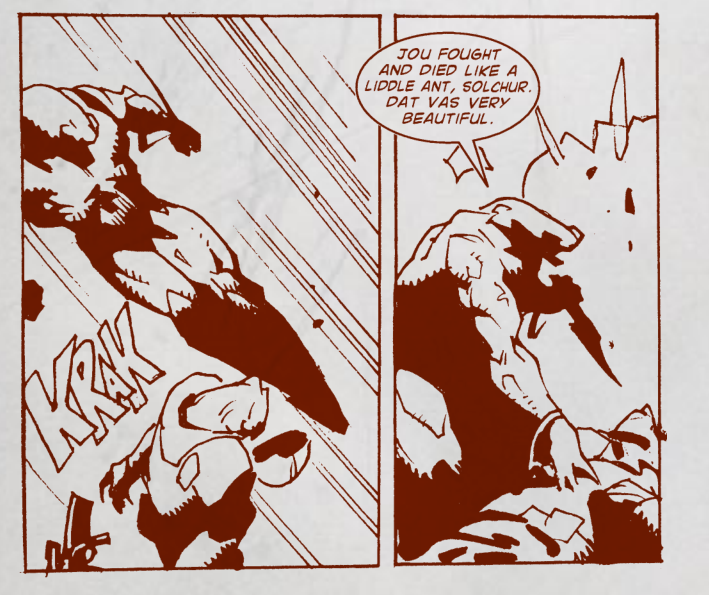

The Kerrn were designed by the Vaylen for intelligence and adaptability, starting from a plant-like species and then built up by their geneticists. Unfortunately for the worms, they were too successful: the Kerrn rejected their implanted Naiven within three generations, revolted against their masters and fled to human space. There, they live among humans, as well as in a cluster of crippled ships from the rebellion era they call the Omshiip, whose exact location is a secret. Kerrn characters start with the common traits of Bioengineered Organism (they can take a scene's worth of actions in vacuum before taking injuries), Kerrn Accent (they speak weirdly - 'rarely have I seen such lovely water' becomes 'Vvrarely ‘ahf I zeen zuch luvely vahter'), Massive Stature (they're huge, giving them a Power, Forte and Speed cap of 7 and their Agility and Speed cannot be bigger than their Power and Forte), Not Easy Being Green (they're green, yup) Super Mutated IgE (their antibodies reject all parasites, giving them +3D to Forte rolls against them and a chance to overcome hulling by killing the Naiven with antibodies - note that this roll can take place even if the Kerrn isn't in control of their body) and Unbridled Hatred (they hate all Vaylen and their creatures, particularly the Mukhadish that were created to replace them)
The Kerrn settings are:
-
Vreck
: creches where Kerrn are first raised, made from wrecks of ships and derelicts.
-
Oprvraeta
: the technical class that keeps the Omshiip running.
-
Solzjah
: the soldiers and warriors of the Kerrn. All Kerrn are trained since childhood to fight, but these are dedicated to the cause, or are career soldiers for the human empires.
-
Omshec
: security and intelligence, the spies and counter-spies that keep the location of Omshiip hidden from the Vaylen.
-
Omshiip
: the Kerrn government, and being the master of Omshiip is a possible lifepath.
-
Piilosihver
: philosophers and scholars, because as former slaves the Kerrn believe in education and the search of knowledge.
-
Diazspherah
: the Kerrn that live in ghettos in the human polities. Sometimes feted, most of the time discriminated against.
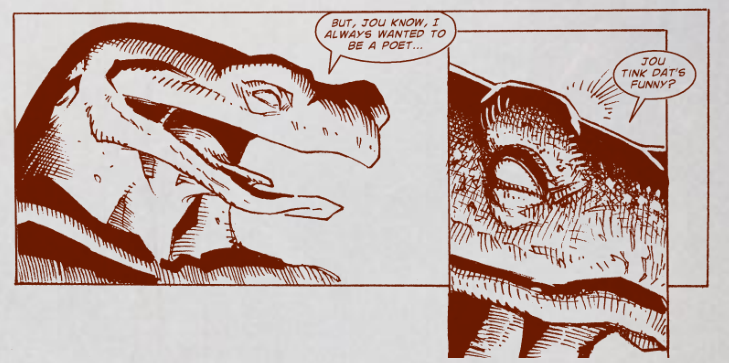
I don't, since that guy probably knows Krav Magah. No, seriously, Krav Magah training is a thing Kerrn can get.
Finally, the Mukhadish . After the Kerrn fiasco, the Vaylen developed a new race that was more pliable and docile, even if they weren't as good as the Kerrn. The result was the Mukhadish, a patchwork of different species. They kind of look like ogres with bat faces. They're dim-witted, hermaphroditic, and accept Naiven implantation easily. They don't make the best leaders because of this, and the game warns that they work best as supporting characters Mukhadish traits are Bred for Slavery (stat caps of Per 5, Will 3, Agi 4, Spd 5, Pow 8, Fort 8), Gigantic Stature (they must have a minimum Power and Forte of 6) Naiven Tube (they have a small tube leading to their brain covered by a flap of skin that lets Naiven simply slide into the Mukhadish), Pug (they have a pug-like face), Rending Claws (can deal damage simultaneously with a successful Overbearing action in close combat) and Tough (rounds up when calculating Mortal Wound).
The Mukhadish settings are:
-
Wild
: Wild Mukhadish are fairly rare, usually what happens when great battles are lost and Mukhadish cows end up stranded and without direction, so they raise herds that live free without hulling. They're generally docile and peaceful.
-
Underworld
: the criminal element in many worlds raise Mukhadish as pets and thugs.
-
Slave
: some cultures breed Mukhadish as slaves.
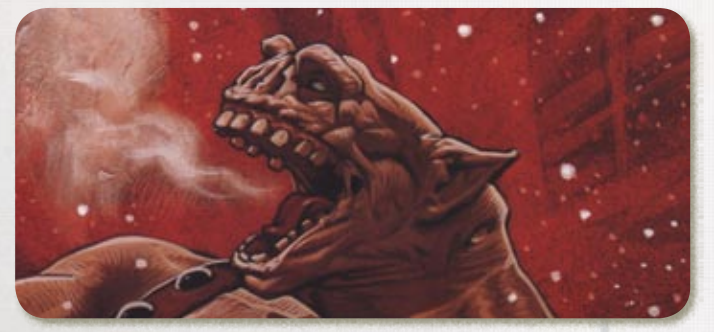
His breath must be awful.
Also, can anyone give me character ideas? Thanks.
Next: the game itself.
The adventures of Wyrdboy McBurnface
Original SA post Burning EmpiresThe
And we have a character! The Kerrn warrior-poet will have to wait, eventually - but don't worry, he'll get done.
code:
Inquisitor Peter Togoro. Age: 46. Homeworld: Packer's World.
Lifepaths: Born to Freemen > (non-native setting) > Foundation Student > Psychologist > (native setting) > Devoted to Fire >
Cotar > Adjutant Inquisitor > Inquisitor
Beliefs:
The worm will not take this world. I will expose the infestation within the church and let fire cleanse it.
The Bright Mark must be protected. I will take young Masbeth under my wing.
Work within the shadows; let none realize I pulled their strings.
Instincts:
Always carry my gun.
When meeting an unknown person, read them.
Never use the same meeting point twice.
Stats:
Will 6, Perception 5
Agility 4, Speed 4, Power 4, Forte 5
Resources 5, Circles 3, Mortal Wound H10, Steel 6, Hesitation 1
Skills: Interrogation 5, Church Law 2, Divination 4, Doctrine 2, Psychohistory 4, Psychologist-wise 2, Rhetoric 6, Psychology 6, Investigative Logic 6,
Heresy-wise 2, Mundus Humanitas-wise 2, Inconspicuous 6, Close Combat 2, Demonology 2, Disguise 2
Traits: Paranoid, Fearless, Bleak, Austere, Skeptical, Order of the Seeking Fire, Keeper of the Fire, Devoted to Fire,
The Psychologist's Code, Bright Mark, Working Class
Affiliations and Reputations:
3D The Church/Government of Packer's World
Devoted to Fire - 1D affiliation with other devotees
Keeper of the Flame - 1D The Temple of Coruscating Flames, in the Packer's World capital of Halessin, run by Arch-cotare Solvalou
Order of the Seeking Fire - 1D affiliation to the Inquisition
1D reputation "the man that can get the truth out of anyone"
Relationships:
Archcotar Solvalou, mentor to him, now a hull for an alien worm (Vaylen Figure of Note)
Masbeth Firebrand, budding psychologist that wants nothing to do with the Church (complicated)
Technology
An office with datafeeds from all over the world (specialized workshop for Psychohistory)
A small, concealable handgun
A signal-proofed safehouse
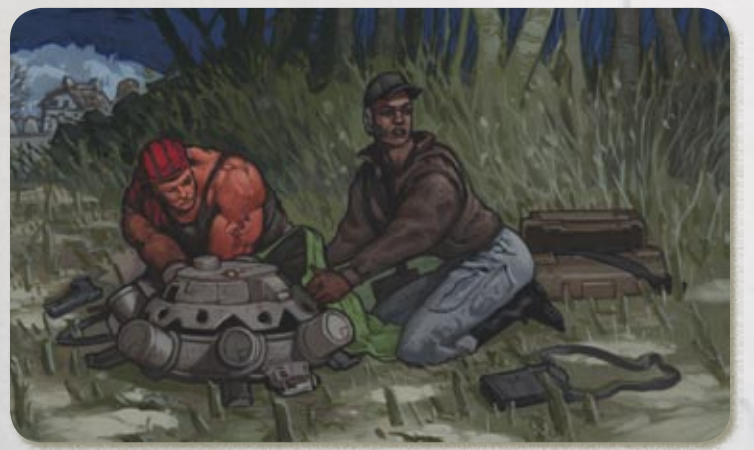
Nice hat.
There's that "let the lifepaths do the talking" thing I mentioned before. What is a 'cotar'? You can surmise what it is from the church context and the 'arch-cotar' term (yes, it's a priest) but it's not made clear. You'll find many other lifepaths with even less explanation, like 'coeptir', 'ravilar' and 'stentor'.* Skills are also oddly specific in some cases: while "close combat" covers everything from fists and knives to pistols and sawn-off shotguns, you'll find a skill like Amercement that is, quote unquote:
quote:
[...] the knowledge of fees and criminal fines given as judicial punishment. Such amercements are almost always offered in place of corporal punishment, e.g. “You may take 30 days in the solitary cells or you may pay the court a fee.” Using this skill, the character may accurately set the Resources obstacle for a fine. The skill test obstacles indicate how accurate and just the amount is according to the law.
On to the game itself! We'll start by talking about scenes. Like we talked about before, they're the least unit of gameplay, and where Shit Gets Done. Scenes are played one at a time, going around the table, and in each scene one character is in the spotlight. Which doesn't mean that other characters can't join in, of course. There are four types of scenes in Burning Empires.
Conflict scenes are where the meat of the game's action takes place. The fights, the blown-out arguments, the psychic duels, the construction of spacecraft and fortresses - there's a lot of shouting and a lot of dice rolling in conflicts. These happen when the character wants something and is willing to go all-out for it. Two to four or five conflicts happen per game session, more or less. Building scenes happen when the characters are setting up stuff that will lead to the larger conflicts. This is where characters hack into systems, write propaganda, repair ships, file paperwork and other important stuff that doesn't need to be blown up to a full conflict. Most of the game's skill rolls will take place within building scenes. Each building scene lets the character perform up to three different dice rolls, and they must be made by the character in the spotlight - others may help, but they can't resolve the scene themselves. It's kosher for two characters to take building scenes simultaneously and pass help and dice back and forth, however, as well as dividing the rolls across the session in larger games where there's a lot of stuff going on. Color scenes are pure roleplaying and narration. One character takes the spotlight and just states what happens. No rolls are made in these scenes: they merely establish stuff about characters and the setting of the game. They serve to introduce color technology, and to lay the groundwork for future conflict or building scenes. Imagine a dastardly noble character narrates how she's enjoying herself watching gladiators die from her VIP seat - later, she can have a scene where she surreptitiously hires a gladiator as a deniable asset. Interstitial scenes happen when two characters talk. Like color, but they are focused in the interaction between characters. These are done to patch the narrative together, to share what characters know so that others may act on that knowledge and so on. Occasionally, scenes will blend in naturally: an interstitial may escalate to a full argument, a bit of color just seems to be a natural fit for a roll and so on. This is okay, but as we'll see in the Infection mechanics, scenes are a limited commodity.
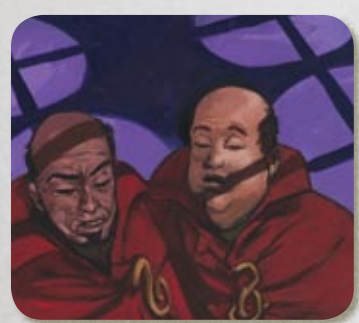
Getting high with your bros counts as an interstitial. I mean, it's not like you'll get anything DONE.
Now we talk about tests . BE doesn't believe in that rollplayer vs roleplayer crap: you are meant to roll for stuff. If it's important, if it matters to the game, then yes, roll. But before you pick your dice, you have to state your intent . The intent is what you, as the player, want out of that conflict. So you're scouting out shipping lanes - what for? What do you want? This is in contrast to the task : what the character is actually trying to do, and how they attempt to accomplish the player's intent. "I kill him!" is your intent. "I shoot him in the face with my pistol" is your task. (And an opportunity to break out the combat rules.
 ) Once task, intent and the actual ability needed are made clear, only then does rolling happen. In independent tests, the obstacle is set by the skill itself, the maneuver/action or the GM. In versus tests, two characters are in opposition. Any time two characters are opposing each other, a versus is called for. For instance, Character A decides to build some fortifications in a color scene. No rolls are made here. Then another character wants to blow them up - bam, time to roll Fortification vs Explosives. It's natural to make intents opposed ("I want to blow up your fort" vs "I want to stop you") but characters can set up goals of their own: ("I want to blow up your fort" vs "I want to know who did it") Note how the fortifications are going down either way in the latter case. But players must agree on their intents before the dice fly: if they don't, no rolls are made, and that's not a good thing because it means conflict did not happen. Ties are binding: neither side gets what they want, unless both sides agree for a tiebreaker roll made at the bare root stat of the skills involved.
) Once task, intent and the actual ability needed are made clear, only then does rolling happen. In independent tests, the obstacle is set by the skill itself, the maneuver/action or the GM. In versus tests, two characters are in opposition. Any time two characters are opposing each other, a versus is called for. For instance, Character A decides to build some fortifications in a color scene. No rolls are made here. Then another character wants to blow them up - bam, time to roll Fortification vs Explosives. It's natural to make intents opposed ("I want to blow up your fort" vs "I want to stop you") but characters can set up goals of their own: ("I want to blow up your fort" vs "I want to know who did it") Note how the fortifications are going down either way in the latter case. But players must agree on their intents before the dice fly: if they don't, no rolls are made, and that's not a good thing because it means conflict did not happen. Ties are binding: neither side gets what they want, unless both sides agree for a tiebreaker roll made at the bare root stat of the skills involved.
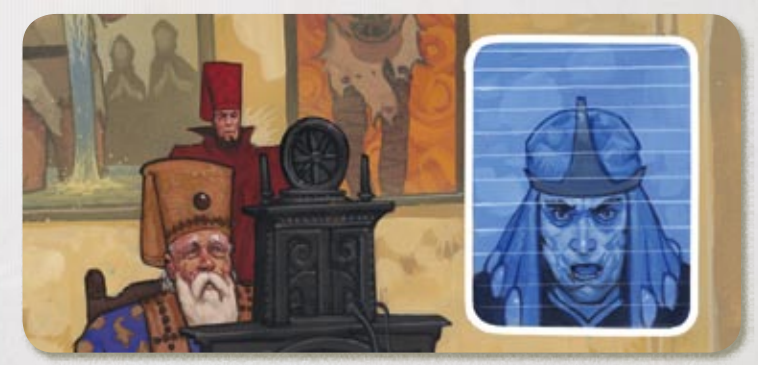
"Your hat is not good enough, liege."
In open tests, there is no fixed obstacle: you just want to know how well you did. This is typical for research-type rolls. Generally, one success reveals obvious stuff, five reveal expert knowledge and ten reveal everything. Sometimes a character engages in a long term operation that benefits from other skills or abilities: in this case, a linked test is called for. If a link can be established between two tests ("my research of local shipping lanes will help my Smuggling-wise roll to determine probable routes for bandits") then they are linked, and if the first roll meets or exceeds the obstacle it grants +1D to the second one. If it fails, however, the second roll gets +1 Obstacle. It is encouraged to set up tests and conflicts to open up the possibility of linking tests. If a player can state a clear advantage for a test ("the ground is slippery so I can push you down with more ease") they get a +1D. Only one per test, though. Any time the GM feels there is a disadvantage to a test, they can add +1 Obstacle to it. Disadvantages are cumulative. Both advantage and disadvantages can affect a test at the same time.
Players may have their characters help each other in play. There's an actual ritual for this in physical games - the helping player must actually give a die to the player being helped, "just so we know if [they're] being helpful or not." Whatever, Luke. The helping player then declares how they're helping. Skills may help skills and stats, but stats may not help skills. Furthermore, the abilities must be related in some way, no helping a Sensors skill roll with Heavy Weapons. When helping, skills of exponent 4 or lower give +1D to the roll, while those that are 5 or better give +2D. If a character is helping their own rolls, that is called a FoRK (from Field of Related Knowledge), in which case the character can get +1D from a skill and another +1D from a -wise type skill, like Heresy-wise or Psychologist-wise. It's up to the player to suggest FoRKs, and to the GM to accept them or not. FoRKs also color a test: if you're FoRKing Conspicuous into a Command roll, you're yelling a lot and drawing attention to yourself so that your people hear your orders.
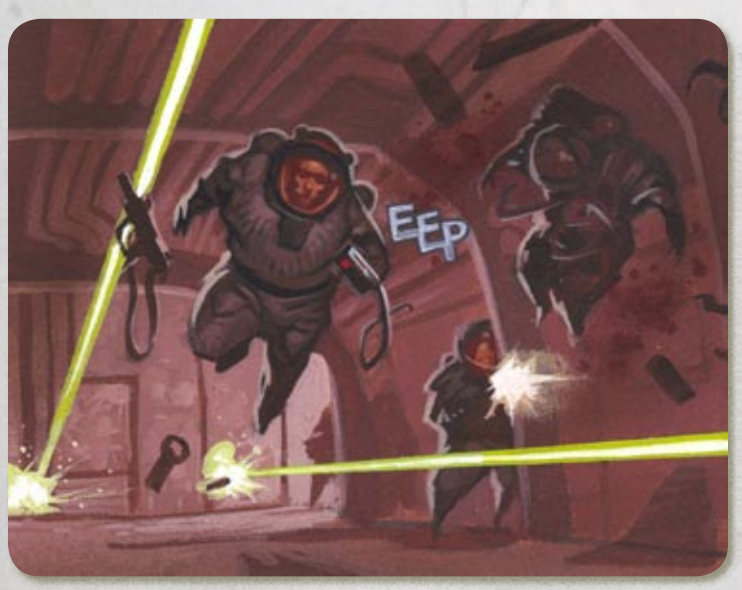
"Eep"? Terrible sound effect for a raygun.
Note that when you succeed in a test, your intent goes through, and when you fail it your intent gets squashed. A roll is sacrosanct: neither player nor GM can ignore a successful or failed roll. So if you blow up a Security roll to open a door "before guards come," then it is very possible that the character succeeds in opening the door but they get spotted by the guards. This means that the GM is also in charge of stating the consequences of failure upfront before the dice roll. A corollary of all of this is the Let it Ride rule, that is hard and fast: a player tests an ability for their intent once a maneuver. After that, neither GM nor player can call for a retest for the same intent in the same maneuver by the same character. The successes from that initial roll count for all applicable scenes and conflicts for the rest of the maneuver. No rolling Infiltration over and over when approaching an enemy compound: you roll it once , and that result stands. This rule is hard and fast, and is only set aside for the big conflict minisystems: Firefight and Duel of Wits. Some other tidbits: If you don't have a skill for a particular roll, you can test the stat to which the skill is rooted, but the obstacle is doubled. This is called Beginner's Luck. In the case of certain knowledge skills, it's kosher for a player with a successful roll to simply state that a given fact for the world is true.
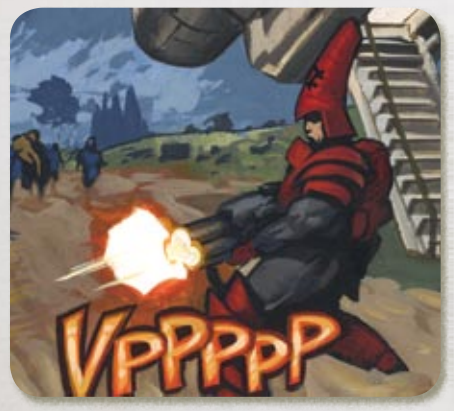
"Vpppp"? Now you're just taking the piss, Moeller.
Each test falls into one of three levels of difficulty for advancement purposes, depending on the number of dice rolled. They are routine , difficult and challenging. There is a table, but basically routine tests have obstacles that are smaller than the number of dice rolled, difficult tests have obstacles that are close or up to the number of dice rolled, and challenging tests have obstacles larger than the number of dice rolled. To advance a skill, you need a number of Routine, Difficult and Challenging tests for that roll. To advance a stat, only Difficult and Challenging rolls with suffice. You can't trade the tests around - you roll what you have, and it's up to you to, say, refuse help because you need a Routine check to become Difficult. Note that, with the exception of Resources, you don't have to actually succeed on the roll to earn the test for advancement. If you roll the same skill many times in short succession (a combat skill in a fight, for instance) only the hardest check counts for advancement. Once you get all the tests necessary to bump up an ability, it happens instantly - even if you're right in the middle of something. Open tests always count as Routine tests, and the difficulty of versus tests is determined by the number of successes rolled by the opponent. If there is downtime during a phase (which happens during certain maneuver actions), characters can engage in practice , which automatically gives them tests depending on the time they spend polishing up their skills. The exact amount of time depends on the skill itself and the test that you want to get for it. To learn a new skill, you determine your aptitude for it (10 - root stat) then roll as many Beginner's Luck tests against it as your aptitude. Then it gets opened at half the root stat of the skill rounded down, just like chargen. An instructor character that passes an Ob 2 Instruction test can teach other characters, giving them free tests with obstacles up to the exponent of the skill being taught. It takes (10 - instructor's Will) + (10 - student's Will) + (practice cycle time) days to award a test for instruction.
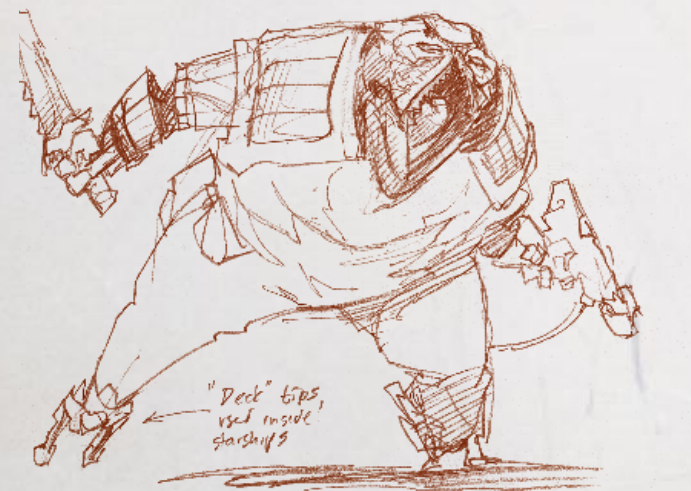
BWAAK
About those beliefs, instincts and traits! Beliefs can be changed in game. If the character achieves a goal set in a belief or just doesn't care about it anymore, they're free to change it. It's up to the GM to say when a Belief might be changed, and they're free to veto such a change if they feel the player is just trying to wriggle out of a difficult situation. Same for Instincts. Traits, however, change during play. A Belief that is fulfilled can be elevated to a trait: if you had a Belief about getting your father into the throne and it happens, you can get a trait that says something like "Loyal to your House." This is subject to a vote, and all players must agree in order for this to happen. Likewise, at the end of a phase players and GM discuss and nominate characters for new traits depending on how they feel their experiences have changed them in play. Again, an unanimous decision is required. They can also nominate a trait to be voted off, in which case the vote has to be unanimous unless the character's player wants it off, then just a simple majority will suffice.
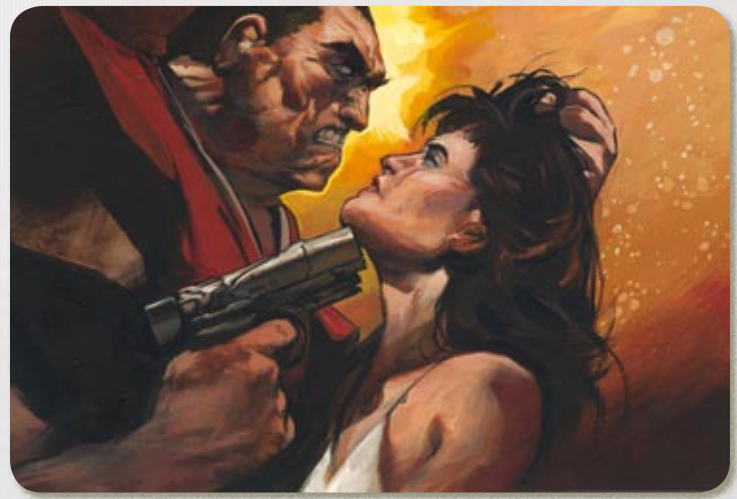
"I change my belief from 'Fat Bro is fat and bro' to 'I'm so murdering this asshole when I get the chance.'" Success!
But wait, you might be thinking now. How do you actually succeed in Challenging tests? Can't roll more successes than you have dice! This is why we have artha. Artha is basically BE's "hero point" mechanic. Playing to your beliefs, instincts and traits rewards you with artha, which you can use later to help your character in many ways. The three types of artha are Fate , Persona and Deeds.
Fate is the easiest type of artha to obtain. You get a point of Fate when playing a Belief serves a purpose and drives the game forward, when you decide to ignore an instinct and get in trouble because of it, when a trait alters the direction of the story in a way that makes things more difficult for the character (you are Clumsy and fumble the macguffin at the worst possible moment), to a GM's character if a player feels engaged with a color or interstitial scene in which that character is involved, and if a player has the right skill at the right time when no one else does to keep the story flowing. Fate points are spent in Luck : after dice are rolled, make the roll open-ended (6s are rerolled), and if the roll is already open-ended the player may reroll a single failure.
Persona points are obtained by embodying the mood of the table perfectly with a rousing speech, a desperate decision or so on (the group decides who deserves this at the end of the maneuver); by believably playing out a moment of inner turmoil when Beliefs enter into conflict with a decision, traditionally awarded when a character goes against one of their Beliefs; when a character achieves a personal goal written into one of their Beliefs; when a player character is the "workhorse" of the team, the one that is the most relied on in a single maneuver by group vote; and when a player character becomes the MVP by group vote at the end of the maneuver, the one that shines in the last moments and that everyone agrees they couldn't have made it without them. Persona points are spent in Boon (1-3 persona points are spent in extra dice, +1D per point), Grit Your Teeth (if a player is incapacitated by non-Mortal wounds, spend a point to alleviate 1D of wound penalties) and Will to Live (a character that suffers a Mortal Wound must spend a point to hang on to life and have a chance of recovery - if the character is out of persona points, they're a goner)
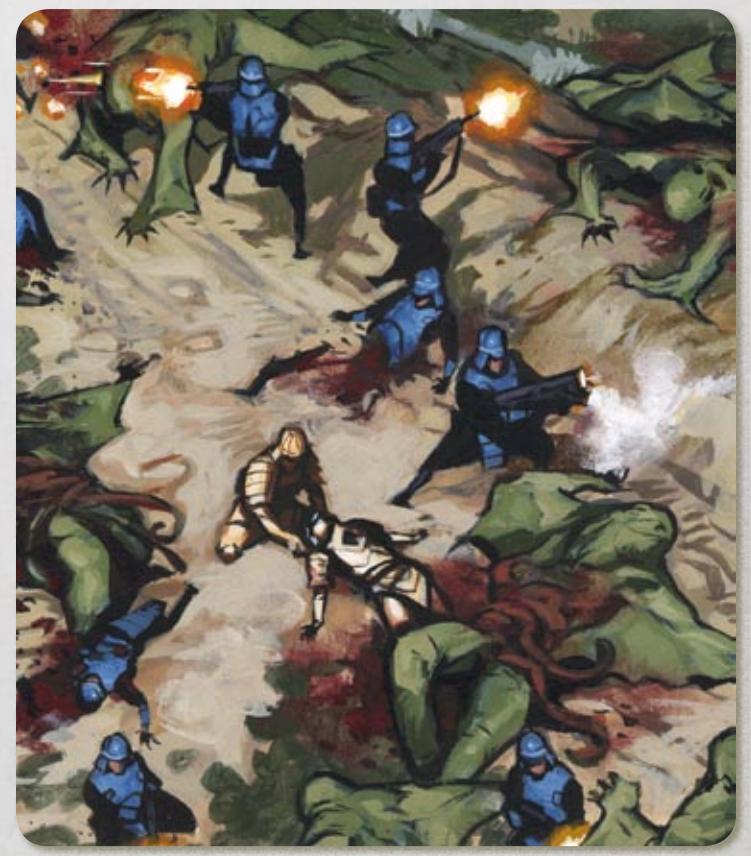
Better have that Will to Live handy.
Deeds points are the rarest, and only obtained by going above and beyond the character's personal agenda. Each character in the winning side of a phase gets a deeds point. Deeds points are spent in Divine Inspiration (before dice are rolled, double the exponent of a single stat or skill) and Personal Demons (all failed dice are rerolled, but the player must state what cost the character's personal demons exact from them, and why they still want them alive and active - it's gonna be bad and costly for them) If artha is spent in a scene involving Beliefs and Instincts, note if Persona or Deeds points were used - during the trait vote, these beliefs and instincts can be nominated to become call-on and die traits.
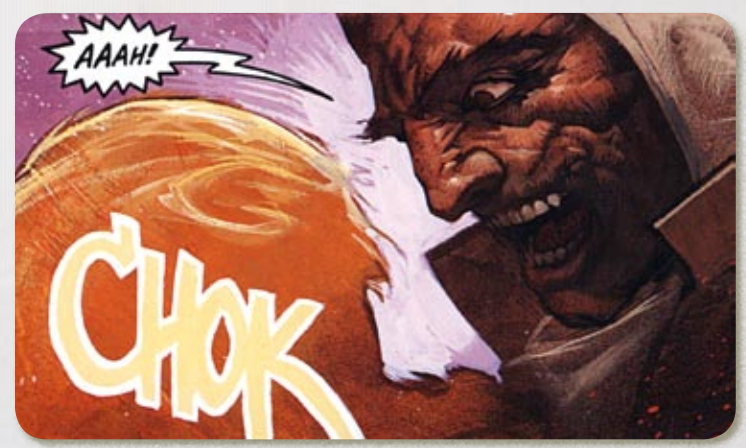
Whatever CHOK is, it must've been painful.
Next: we're not even close to the combat rules.
A coeptir, by the way, is close to a page or shield-bearer. A ravilar is a cross between a bard and a journalist. A stentor is a mechanic, particularly one that maintains iron for a VIP.
My buddies, my gear
Original SA post Burning EmpiresMy buddies, my gear
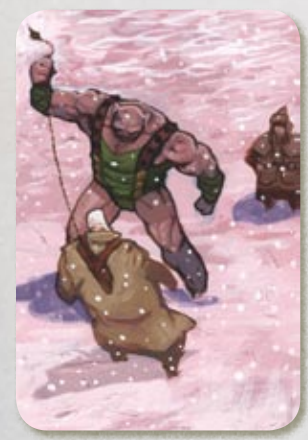
GIVE DOLLY BACK
So what's the deal with relationships , anyway? Relationships are NPCs that are important to a player and their character. They have their own goals, Beliefs, backstories, stats and whatnot. There is no roll necessary to meet with a relationship - it's assumed that details of contact are worked out. They may help PCs at the GM's discretion, but they're not just a source of free dice. Other PCs, as mentioned before, cannot be relationships. Circles is an abstract measure of the people the character may contact within the game world. Circles is rolled as part of a building scene where the character is trying to get information, services or favors. In effect, the player creates a minor NPC out of thin air: they don't have to exist beforehand to be called on with Circles. It might take roleplay and mechanical persuasion to get the NPC to actually be useful, but Circles determines their existence and the character's knowledge of them. The scope of Circles is deliberately vague and broad: it encompasses people with similar lifepaths as the character as a rule of thumb. Affiliations and reputations may be added to a Circles roll, but only within their scope - a local reputation does nothing if your character is abroad, and affiliations only help when seeking people within the same affiliation or organization. Other players may help with Circles, but only using their base Circles exponent, not their own reputations and affiliations, and only if they have a lifepath within the setting the character is trying to tap. Certain tests may be linked to Circles, like Resources or -wise type skills. The obstacle of the Circles tests starts at 1 for a perfectly ordinary specimen of the kind the character looks for (ambivalent, doesn't know much, Exp 3 skills, is available within the building scene) and can be increased or reduced by several factors: do you need a more skilled NPC? Are they too high (or too low) in station compared to you? Do you need them to be really loyal to your position? Do you need them in times of peace or in the middle of a conflict? And so on.
Reputation dice from a target may be used as advantage dice by someone rolling Circles for them. If the player meets the obstacle, that's it - they get an ally of convenience that will be gone in the next scene. If they exceed the obstacle, however, they can name the NPC for an extra +1D to Circles when calling on them again. If the Circles test is failed, then either the character didn't find who they were looking for or (at GM's decision) the Enmity Clause may be called: the NPC exists and is found, but is ill-disposed to the character for whatever reason. Such disposition may change within play, of course. Infamous reputations add their dice in obstacles to the CIrcles roll (try rolling up a soldier when you're a known deserter!) but may also open new circles, enemy of my enemy is my friend and all. A character being sought using Circles may roll their own Circles to determine who's been asking around, with an obstacle of (10 - original obstacle), but the seeker may also add obstacle points willingly to conceal movement within the circles, or roll the Inconspicuous skill beforehand. Optionally, a recurrent contact may become a Relationship by succeeding in (10 - number of dice used to contact the NPC ) Circles rolls. Circles advances as a skill.
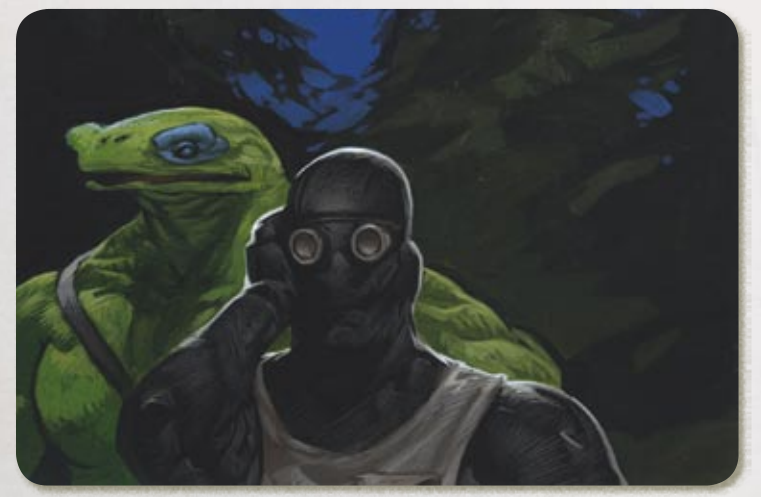
Command, the Frog is Behind. Repeat, the Frog is behind---urk!
Reputations change during play. If a character uses reputation dice in a Circles test that gets them into a bad situation (loses a battle, blows a Resources test, etc.) the reputation is reduced in 1D. The player may opt to exult in infamy , however, and then the lost die is added to a new reputation, inimical to the previous one. A character that gives up their identity and goes into hiding loses all reputation dice, and if they retake their old mantle they are restored at one less die than before. At the end of a phase, players and the GM may nominate characters for new reputations and increases in existing ones, just like trait voting. Affiliations may also change: a Duel of Wits may have as a statement of purpose stripping the character of their rank. New affiliations may be obtained in play, but they require a Resources test with an obstacle of 2 + 2 more for each extra die to pay for parties, gifts, bribes and so on.
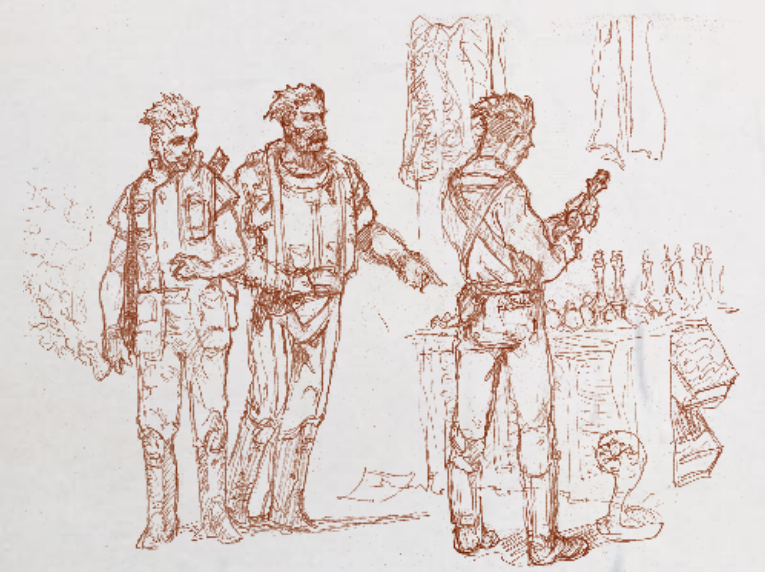
Dig the cobra

The GM doesn't have to muck around with Circles rolls - instead, they may set aside Circles points and outright spend them in new relationships. It costs 2 points for a standard relationship, 1 for a complicated one.
Resources is the measure of a character's material wealth, credit, and the value of their word in transactions. It's very abstract, you can't say that one point of Resources is worth this or that many credits. You roll Resources when there's something you need to purchase or acquire. Characters may not FoRK skills into Resources, but they can link tests from Accounting, relevant -wises and so on. If the player meets or exceeds the obstacle, bam, the character gets the thing. If the test fails, however, Resources are Taxed : they lose 1D on a Routine test, 2D on a Difficult test and (margin of failure) on a Challenging test. And if the character was getting help from other characters, everyone is Taxed on a failure. Getting Taxed to 0D permanently loses one die of Resources. However, the GM may offer the Gift of Kindness on a failed test: the Tax remains, but the character gets what they were looking for. If the player refuses the Gift of Kindness when offered, though, the Tax is reduced to 1D no matter the difficulty of the roll. If the Resources roll was done for a piece of technology, Gift of Kindness also lets the GM add traits of their own choosing to the technology in question. The GM may always grant the Gift of Kindness to characters they control, but for technology it is the players who assign limitations to the gear the GM wanted. Resources suffer +1 to Obstacle if the roll is made outside of the character's "turf", and if you're buying stuff in bulk just increase obstacle in one or two and multiply the item by ten or a hundred - it's all abstract, see. The primary export of the planet gets +1D to Resources rolls, and quarantined stuff gets +1 Obstacle. Regulated stuff goes from +1 to +3 extra obstacle depending on the tightness of the planet's economic regulations. And of course, there's the black market - no big deal in times of peace other than the possibility of getting caught, but once war breaks out obstacles are going to rise substantially and characters will be forced to Circle up sellers before even reaching for those Resource dice.
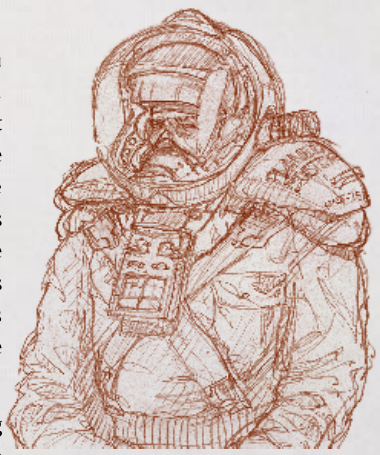
Being an astronaut is boring as FUCK, worms or not.
To recover Taxed Resources, the character must do something to replenish them. Basically, they get a job , picking an appropriate skill and testing it against an obstacle of 1 + number of Taxed dice. FoRKs are appropriate. If they meet the obstacle, they recover 1D of Resources, and if they beat it they get all dice back. However, they only have the time to do so when the maneuver grants them downtime (for next update!). Only a single job roll per period of downtime, and the test counts as advancement for the job skill. Resources also advances as a skill, but only successful tests count for it (better spend some artha, captain of industry). If for some reason you start with a Resources of 0, a single successful roll pushes you to Exp 1. Which probably means you need someone to give you a hand. If a character runs across a substantial amount of cash , they can gain bonus dice from it, but these cash dice are only good for one roll, and after that they're gone. Funds are more substantial stores of money and value, and these bonuses can be used for more than one roll, but if the character is Taxed dice are first lost from the funds and then gone for good. Characters may loan money to one another: loaning cash is a Resources test for the lender with an obstacle equal to the number of dice granted, and setting up a fund doubles this obstacle. If this roll is failed, the lender may opt to cut their losses or suck up the tax and dole out the dice. The main difference between loaning and helping is that the lender is shielded from tax if the debtor blows their own Resources roll. As for the GM, they don't need to muck with Resources tests: they can simply reduce the Resources exponent of their characters to get stuff, like in character generation. These dice are gone, and getting a job won't bring them back, but the Resources exponent may be advanced as normal.
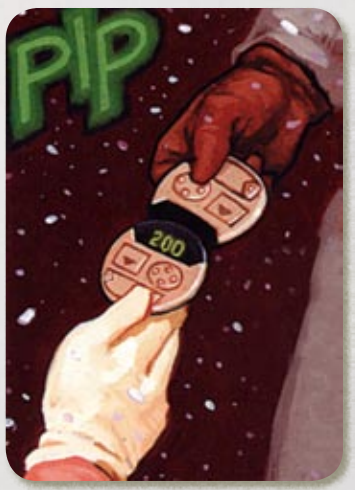
Moeller, I like your comics but those credit discs are goofy as fuck.
Technology! We get some talk on how technology colors the game and serves as an extension of the characters, and then it describes the tech index. It is a measure of the old Federated Hanrilke Empire for the technological development of its component worlds, going from 1 to 10. Only problem is, it is a measure of the old Empire, meaning it hasn't kept up with recent developments (like say, the disappearance of the Hanrilkes
 ). Currently, there's only a handful of worlds that hit index 8, and some have fallen off the index completely. Then it repeats the descriptions of tech levels we saw in the world burner rules, including
primitive
worlds that can't harness electricity and aren't included in the rules because there's fuckall they can do to stop the Vaylen. Anyway!
). Currently, there's only a handful of worlds that hit index 8, and some have fallen off the index completely. Then it repeats the descriptions of tech levels we saw in the world burner rules, including
primitive
worlds that can't harness electricity and aren't included in the rules because there's fuckall they can do to stop the Vaylen. Anyway!
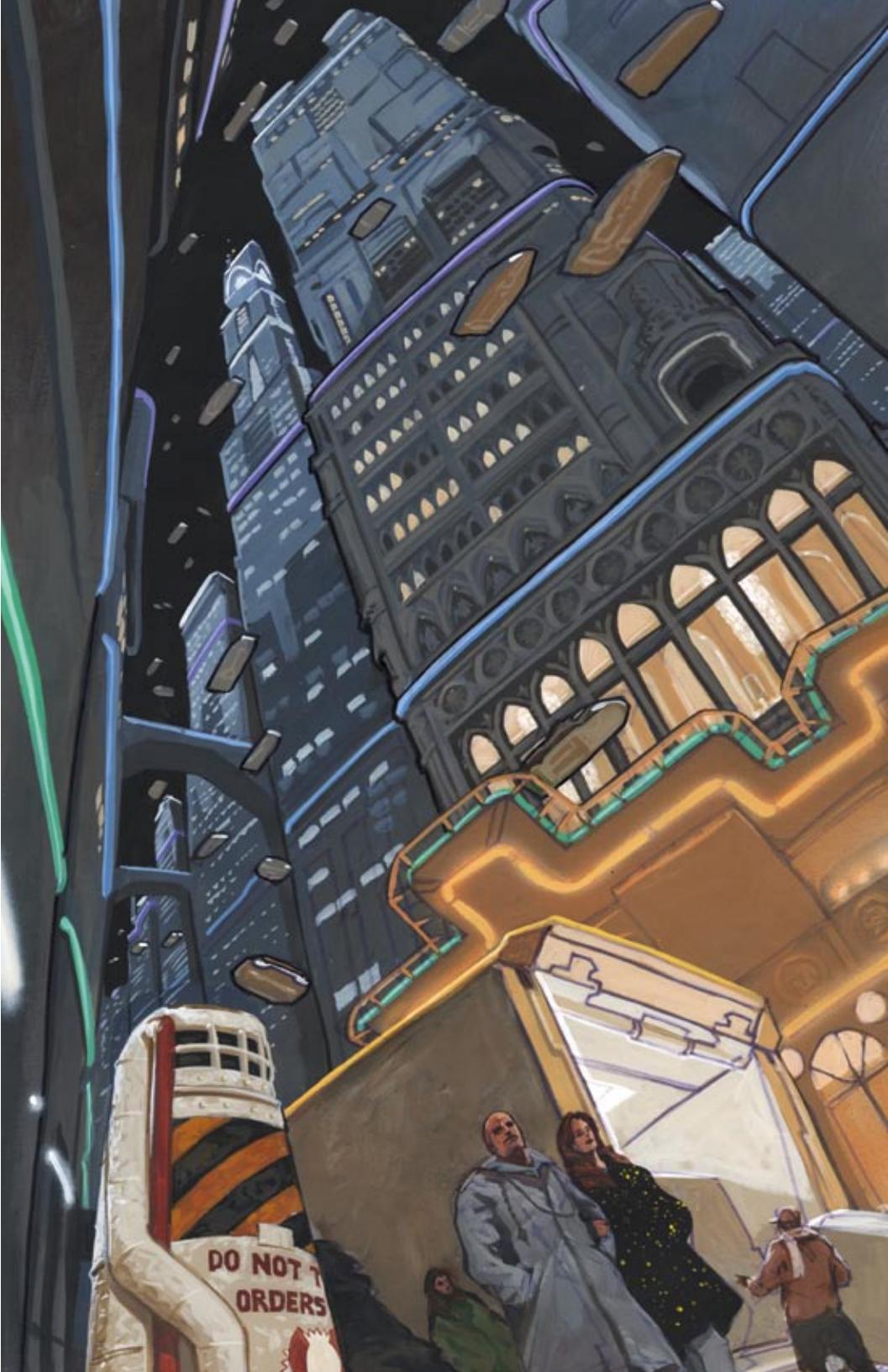
This is the Iron Empires' idea of a 'low' tech world, incidentally.
Technology in the game is generated on the fly during play. First of all, you need to bring it in as color technology. Color is used to, well, color gameplay, and introduce details that help the group imagine how the world works. Color must be appropriate to the world's tech index and most importantly, it does not and cannot have mechanical effect. Imagine if our psych-Inquisitor didn't pay for his gun at chargen and just said he had it - that's perfectly fine. Now, imagine if he is jumped by an assassin and tries to pull his gun on him: the GM is well within their rights to narrate how the assassin simply knocks the gun away. Tech color must be added in a color or interstitial scene and must exist as such for the whole first scene before it can be upgraded. Hard technology in BE is that tech that has an actual mechanical effect within the rules. Say your shipping magnate has an entire shipping fleet - that's cool, that's just color. Now say that you need to send a message from one of your ships to a nearby planet and the GM attempts to block it with the Signals skill of one of their characters; now it's the time to turn the ship into hard tech! In the case of large pieces of color like this very ship, you don't have to make all of it hard at once: in this case, for instance, you can get away with only making the ship's comms equipment. To bring hard tech into play you need to roll Resources: you can do this in a building (+1D) or conflict (+1 Ob) scene.
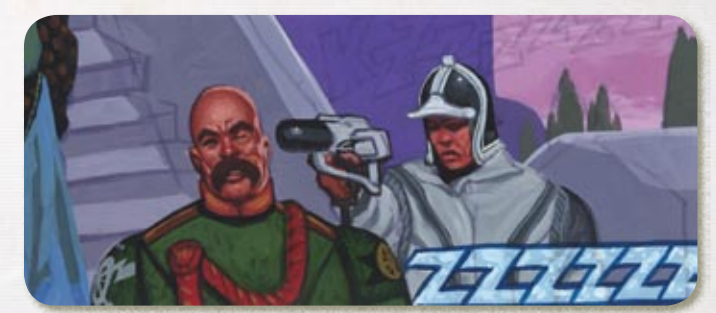
Nah, bro, it's totally cool to get aimed at the head, see. That is actually a "Calvaria Integrity Scanner", that checks your head for Vaylen field hulls. Not so good with the other two types of hulling.
Technology is described by a number of technological traits that represent what they do in game. To begin, determine whether you're making a weapon , protection , vehicle , security system or device. The first four have general templates for you to begin, and then you start adding traits to further customize the piece of gear. Devices can be tools and workshops (demanded by the use of certain skills - can't manufacture things without a manufactory and so on), provide advantage (extra dice), impede another character in some form with an obstacle (extra Ob for their rolls), have skills or stats of their own ( Technological Skill or Stat ) or be enhancements that allow the human body to do things that otherwise it would not be able to do. The trait costs here vary a lot depending on what the device helps or hinders, and the GM may also add or reduce to the points cost depending on the circumstances of use for the piece of tech, whether the GM likes it or thinks it's a pain in the ass, and so on. Technology can include limitations that make the gear perform worse than usual and reduce the trait cost, whether by design (the player or GM adds them beforehand) or happenstance (typically as the result of a failed Resources roll). You get +1D to the Resources test if you name the piece of tech, its origin and builder. After that, it's just a Resources test with the total points cost of the item to acquire it, which is why really big pieces of gear like space cruisers are better bought off module by module rather than in one go. You may also fabricate technology if you have the Fabrication skill, in which case you can split the obstacle cost between your Fabrication and your Resources rolls, with a minimum of 1 Ob for the latter. There's a handy list of items so that you don't have to muck around with tech rules if you don't want to, without names so you can get the +1D for naming them. Oh, and remember that you can buy tech in chargen, in which case 1 resource point equals 2-5 trait points depending on the world's tech index.
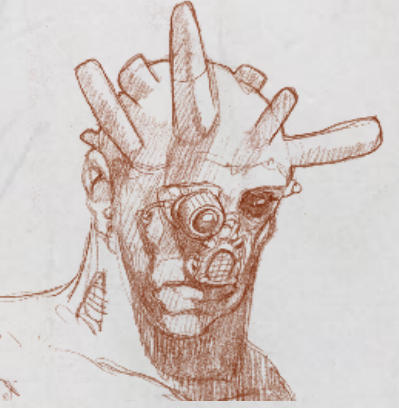
"GM, this totally gives me +3D to Seduction. Pass the dice, come on."
Next: finally, battle!
In order to save the world, the PCs had to burn it
Original SA post Burning EmpiresIn order to save the world, the PCs had to burn it
Enough with all that bookkeeping stuff, on to business! I lie, it never ends.

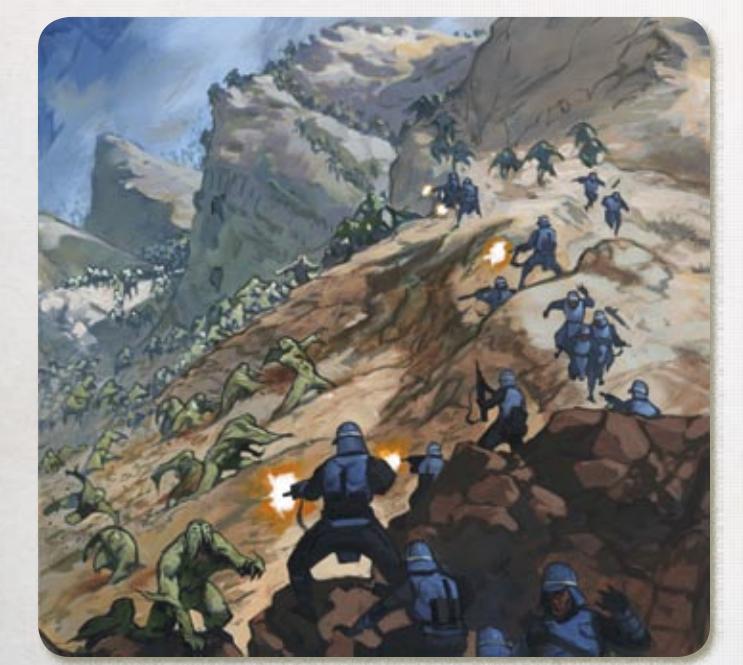
While the PCs are busy getting drunk and wasting Resources rolls on dank memes, there is a war going on.
The Vaylen Infection rules are where the world lives or dies. The war is taking place in two fronts: one is the personal scale one, where players make decisions about their characters, test their Beliefs against each other and so on. Over that, there is a "big picture" level that chronicles the overall fate of the world: this is what the Infection rules are meant to model. As we know now, a BE campaign is split into three phases. It's up to the group to decide which phase they want to start in, no need to play all three of them if they don't want to. Infiltration involves smuggling, underworld deals and so on, while the Vaylen try to gain a foothold on the world. If they succeed, the planet is infected and they've figured out a way to get more of their kind into it. If the humans win, the Vaylen have been thwarted early on, and they may invade prematurely or call off their attempt altogether. Usurpation is a shadow war: people are kidnapped, spies and agents are everywhere, and the local powers are undermined. This phase involves the Vaylen capturing and infecting key individuals to secure their position on the world. The more they succeed, the more they climb up the food chain. If humans win, the Vaylen plot is uncovered and liquidated, and the worms won't have an advantage in the next phase. Invasion is all out warfare and here is where the world's ultimate fate is settled: if humans win, the Vaylen are driven off, at least for now. If they lose, the worm gains control of the planet and the culling for human hosts begins. It's kind of weird after they tell us all of this and the whole business with playing the bigshots that the group should decide whether they want to be movers and shakers or people simply swept up by forces out of their control, which leads me to one of my main gripes with the game.
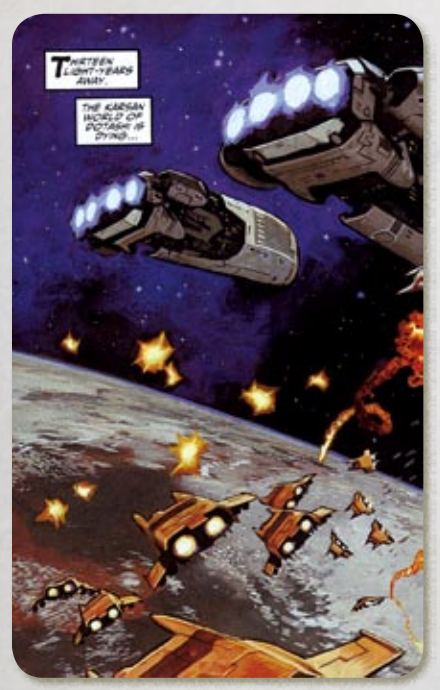
Fourteen light years away, the Karsan League world of Belleville was hosting a Galactic Little League game.
Remember those Disposition values we set up for each phase when we made the world? Disposition is essentially each side's HP in the greater struggle. Through the use of maneuvers , disposition is reduced until one side hits 0, at which point they lose the phase. Disposition also works as a sort of 'clock' for each phase: when you have high Disposition you know you have time to build up, consolidate and prepare, but when you hit single digits you know you must pull out all the stops and make for the finish line. The figures of note are basically the protagonists of each phase. They're important leaders and get Things done, or they may not be in direct control but still be representative of their side's spirit. At the start of the phase, the figure of note rolls a single skill from a list given for each phase, without any help or technology use. FoRKs are acceptable, however. Successes from this roll are added to their side's Disposition for the phase. Then, the figure of note describes a prequel : how do they prop up their side? What are they doing? What makes them special to their side? Figures of note may not change sides during their phase. Figures of note that aren't in play yet may end up helping the other side, willingly or unwillingly, and non-figure of note characters may help whatever side they like. The game tells us that if a figure of note gets turned, the betrayal must be open and known to all players even if the characters themselves don't know. A player moving to the GM's side may coordinate moves with them.
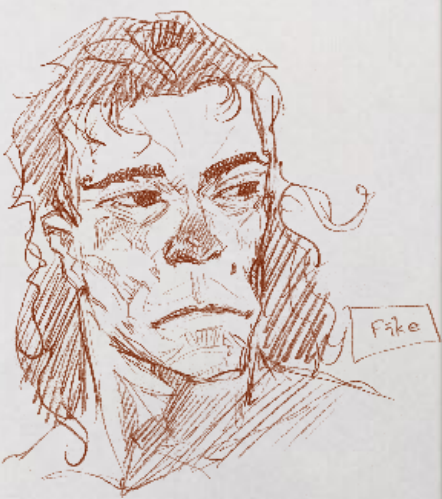
The bad guy for the first trade, Faith Conquers. Kind of shabby looking.
Each phase has an objective for each side, aside from the ones mentioned in the descriptions from before. Generally, this objective will involve changing an element from the world generation session: modifying the planetary attitude towards the Vaylen, (two steps up, so you may end up making a world with personal experience of the worm completely ignorant of it
 )
change the predominant military
of the planet,
change its dominant government
(by elevating one of the factions to rule),
change its level of quarantine
(up to two steps up or down),
change the level of regulation
(up to two steps, up or down)
change its primary export,
(one step on a list that puts unskilled labor at the bottom and military capital at the top)
forcing a faction out of play
(which can't be activated in future phases)
forcing a figure of note out of play
(who won't be able to do a prequel in their phase)
reinstate a figure of note or faction
(if a FoN or faction is forced out in Infiltration, this objective can be set on Usurpation to bring them back for the Invasion - which sounds pretty useless for figures of note unless the other side decided to whack the enemy's Invasion FoN at the start for some reason) Each side's actions must be colored: it's not enough for the Vaylen to attempt to get an advantage by pushing a military junta into power, they must be also on the lookout for remote valleys in which to set up genelabs for their armies of Shudren warriors. Then the humans can state that if they win, they catch the labs and destroy them, and become suspicious enough from errant spaceships to push an enhanced quarantine. This color must be balanced: it can't be "and then we win and you lose and the game is over for you, nyuk nyuk" but it can't be "so like, we find a spy or something
)
change the predominant military
of the planet,
change its dominant government
(by elevating one of the factions to rule),
change its level of quarantine
(up to two steps up or down),
change the level of regulation
(up to two steps, up or down)
change its primary export,
(one step on a list that puts unskilled labor at the bottom and military capital at the top)
forcing a faction out of play
(which can't be activated in future phases)
forcing a figure of note out of play
(who won't be able to do a prequel in their phase)
reinstate a figure of note or faction
(if a FoN or faction is forced out in Infiltration, this objective can be set on Usurpation to bring them back for the Invasion - which sounds pretty useless for figures of note unless the other side decided to whack the enemy's Invasion FoN at the start for some reason) Each side's actions must be colored: it's not enough for the Vaylen to attempt to get an advantage by pushing a military junta into power, they must be also on the lookout for remote valleys in which to set up genelabs for their armies of Shudren warriors. Then the humans can state that if they win, they catch the labs and destroy them, and become suspicious enough from errant spaceships to push an enhanced quarantine. This color must be balanced: it can't be "and then we win and you lose and the game is over for you, nyuk nyuk" but it can't be "so like, we find a spy or something
 " either.
" either.
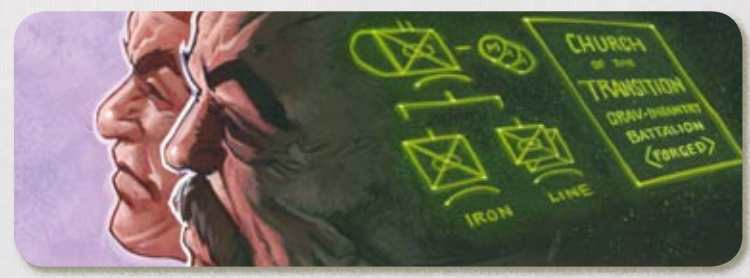
Moeller has a thing for NATO wargame symbols.
Maneuvers! First, you note down the intent of your side for that Infection round. Going on the offensive? Taking a defensive stance? After the intent is decided, the GM privately selects a maneuver and notes it down first, then the players do the same but on the open. Once a decision is made, play is on! Maneuvers must be chosen at the beginning or the middle of a session, never at its end. Once maneuvers are chosen, the game actually starts: scenes are played out, Beliefs are challenged, tests are made. After the scenes are played out or the players feel their goals have been addressed, the action stops and the maneuvers are revealed, then rolls are made. Once the maneuvers are tested, the losing side describes what they were hoping to do, and the winners state what went wrong and how they got the upper hand for that round. Each maneuver has a list of skills associated with it, of which one is chosen to be rolled depending on what actions the characters took during the phase and what phase it is. Maneuvers may be independent of each other (in which case both may succeed or fail) or versus the other side's choice (opposed roll, one winner and one loser) The actual roller for each side will be the player whose character played out the most prominent role within its scenes for their side - typically the one that begins a conflict scene, but not always so.They may only get help from other characters that have given them a help die, a linked test or a psychological connection (later!) in play, and they must also have one of the applicable skills for the maneuver. The GM may have their characters help each other in maneuvers solely by having them present at all in play, even if it's just in color or interstitial scenes. FoRKs may be used but only if they are part of the applicable skills for the maneuver or -wise type skills approved by the GM, and technology is no good.
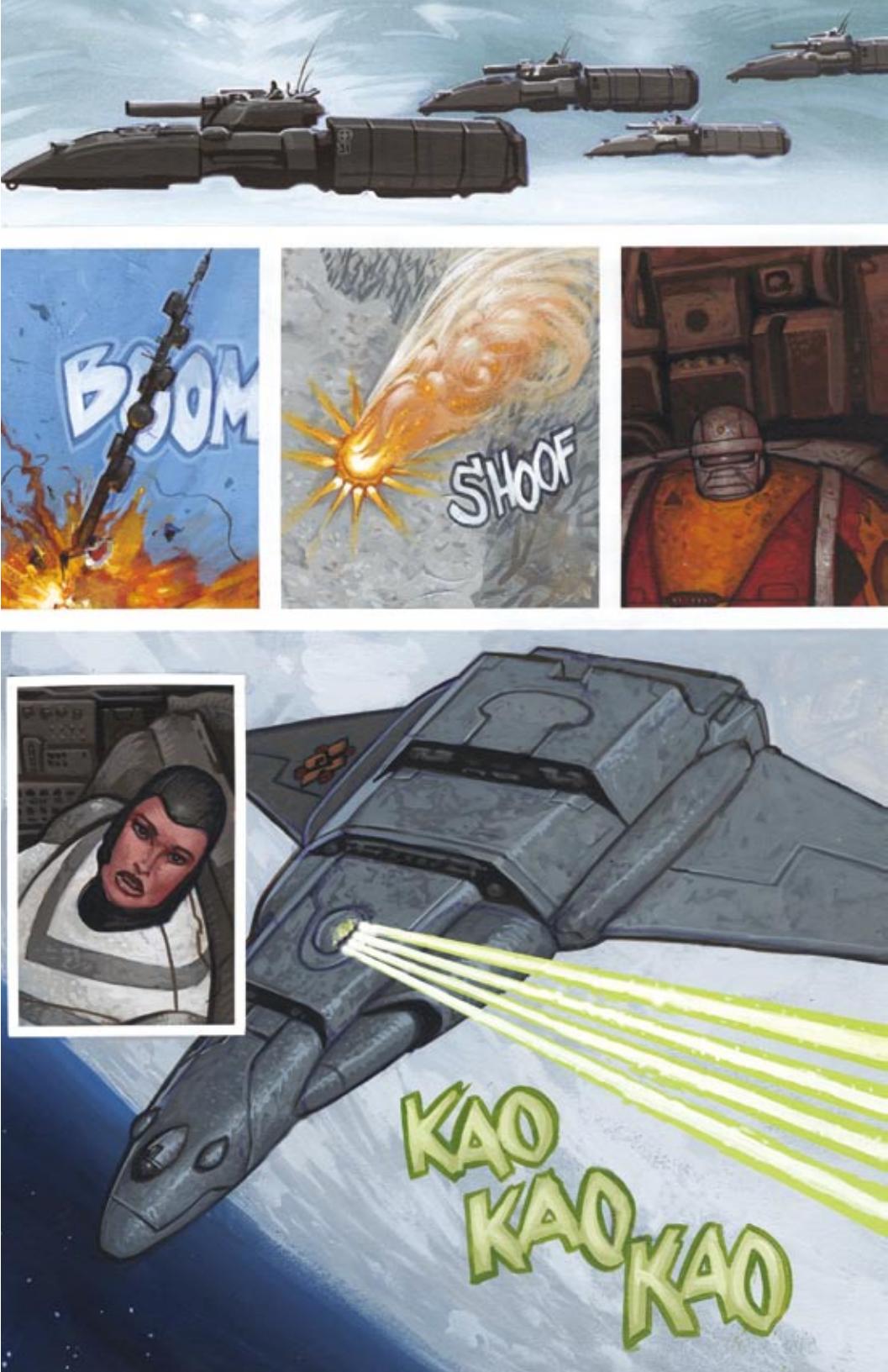
KAO KAO KAO? FFS, Moeller.
The actions are:
-
Assess.
(Infiltration:
Research, Cryptography, Accounting, Streetwise, Observation, Signals, Investigative Logic.
Usurpation:
Security, Signals, Surgery, Recon, Accounting, Investigative Logic, Psychohistory, Research.
Invasion:
Logistics, Signals, Finance, Journalism
) The side devotes their assets to case the enemy and look for signs of weakness. Can be versus or independent, the latter counts as an Obstacle 2 test. You may assess the opposition, then Take Action to remove disposition from them, or assess the factions and then Take Action to activate them, but not both on the same maneuver. A successful Assess against the enemy is necessary before a Take Action, Gambit, Inundate or Pin. An Assess against the factions only allows Taking Action on them.
-
Conserve.
(Infiltration:
Administration, Ship Management, Estate Management, Psychology, Physics, Security.
Usurpation:
Instruction, Tactics, Finance, Manufacture, Engineering, Eugenics, Cryptography, Administration.
Invasion:
Logistics, Manufacture, Shipwright, Fusion Dynamics.
) Conserve uses enemy activity to get time and room to retrench ally forces. It is strictly a defensive maneuver and does nothing against an independent maneuver like Assess, Flak, Go to Ground or another Conserve. Successes on a Conserve subtract from versus actions, and if they are reduced to zero then the enemy's action is stopped. Extra successes from Conserve are added to the ally side's disposition. Extra successes may also generate downtime.
-
Flak.
(Infiltration:
Rhetoric, Persuasion, Ugly Truth, Oratory, Falsehood, Doctrine, Philosophy.
Usurpation:
Psychology, Journalism, Doctrine, Extortion, Law.
Invasion:
Strategy, Propaganda.
) Flak is an aggressive defense. Divide the dice in attack and defense: defense successes subtract from attack maneuvers like Take Action or Inundate, while attack successes subtract from enemy disposition. If used against a Conserve or Go to Ground, roll attack dice only. If used against Pin or Assess, roll defense dice only. Flak vs Flak, match attack pools and defense pools. Flak is useless against a Gambit. There must be at least 3 dice in each pool, and the division must be made before the scenes are played out and you know what your opponent chose.
-
Gambit.
(Infiltration:
Psychology, Tactics, Smuggling, Food Services.
Usurpation:
Seduction, Psychology, Bureaucracy, Finance, Propaganda.
Invasion:
Psychohistory, Strategy, Cryptography, Logistics.
) A Gambit requires a successful Assess of the enemy disposition before it can be played. It is a special attack that burns three points of the side's own disposition, but its power lies in that it is independent of both Go to Ground and Flak. Conserve is still good, however. The side using it must also describe what they're sacrificing and how the sacrifice empowers their attack.
-
Go to Ground.
(Infiltration: Persuasion, Bureaucracy, Security Rigging. Usurpation:
Administration, Estate Management, Journalism, Propaganda, Streetwise.
Invasion:
Strategy, Tactics, Fortifications.
) The side quiets down and attempts to protect their assets. Go to Ground successes are subtracted from versus maneuvers, and if they reduce them to zero then the action does nothing. It can generate downtime.
-
Inundate.
(Infiltration:
Counterfeiting, Smuggling, Tactics, Manufacture, Eugenics.
Usurpation:
Tactics, Propaganda, Psychology, Journalism, Demonology, Extortion.
Invasion:
Strategy.
) An Inundate requires a successful Assess of the enemy disposition before it can be played. An all-out offensive, its successes are subtracted from the enemy disposition and gives +3D to its test, but the side loses their next maneuver: they may play out their scenes still, but can't defend themselves on the Infection level.
-
Pin.
(Infiltration:
Command, Administration, Estate Management, Ship Management, Law, Extortion.
Usurpation:
Propaganda, Finance, Doctrine, Bureaucracy, Extortion, Philosophy, Law.
Invasion:
Strategy, Propaganda, Logistics, Tactics.
) A Pin requires a successful Assess of the enemy disposition before it can be played. It is a tactic meant to disable the opponent temporarily. Against an independent maneuver its obstacle equals the enemy's skill exponent + number of FoRKs used. If the Pin is successful, its margin of success is subtracted from the number of dice the opponent can use in their next maneuver. If they have no dice (without counting help or FoRKs), then no action for them. Pin adds one increment of downtime.
-
Take Action.
(Infiltration:
Rhetoric, Suasion, Smuggling, Investigative Logic, Journalism, Counterfeiting, Forgery.
Usurpation:
Oratory, Psychology, Finance, Smuggling, Extortion, Command,
Tactics, Law. Invasion: Strategy, Propaganda. ) A direct attack. With a previous Assess against the enemy disposition, its net successes are subtracted from it. With an Assess against factions, it can be used to attack them or co-opt them, with an obstacle equal to the faction's disposition bonus in the current phase.
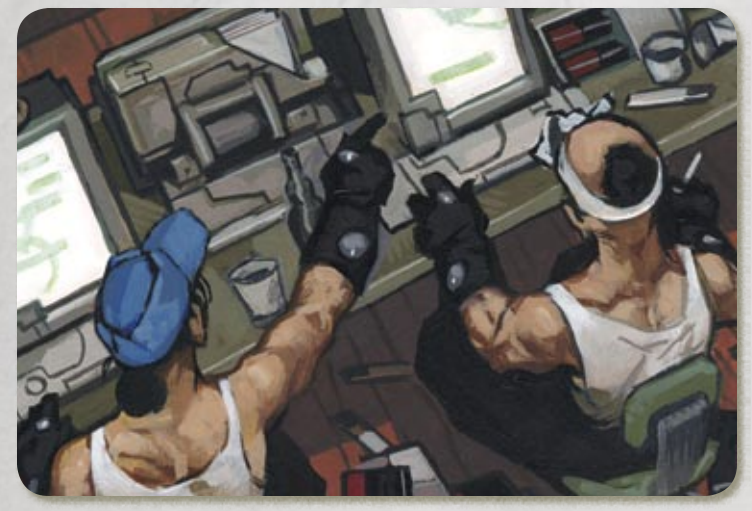
"Check it out, the Arch-cotar spanks it to My Little Vaylen." "Heretical as fuck." "...yeah, heretical."
The connection between the Infection and the character's actions is deliberately loose and flexible. It is possible for characters on a side to succeed at a personal level and blow it on the big picture because things were out of their control. Which, IMO, is kind of pants. Note that you still need to do all that stuff with scenes to get the relevant characters and skills for the maneuvers but even so, when one of the pitches of the game is that everyone's playing to win, it feels like the integration of personal and big picture actions could've been tighter. I guess it means you can play lower-level characters swept away by the big events around them, but that also goes into conflict with the earlier spiel about playing the movers and shakers. I don't know.
Scenes! They're limited. The player's side is guaranteed one conflict scene per maneuver, and an optional second one. Players decide who gets to initiate the conflict: sometimes it happens organically in play, sometimes it's part of the plan they decided on when choosing their maneuver. Each player whose character isn't in the spotlight of a conflict gets one building scene. All players also get one color and one interstitial scene each. The GM is guaranteed one conflict for their side, with a second one if time and circumstances allow and it feels like it's right to do. Any figures of note that don't initiate a conflict get a building scene per maneuver, and the GM gets one color or interstitial per figure of note. Building, color and interstitial scenes are optional for the GM. Assess, Conserve, Go to Ground and Pin maneuvers require building scenes. Flak, Gambit, Inundate and Take Action maneuvers require conflict scenes.
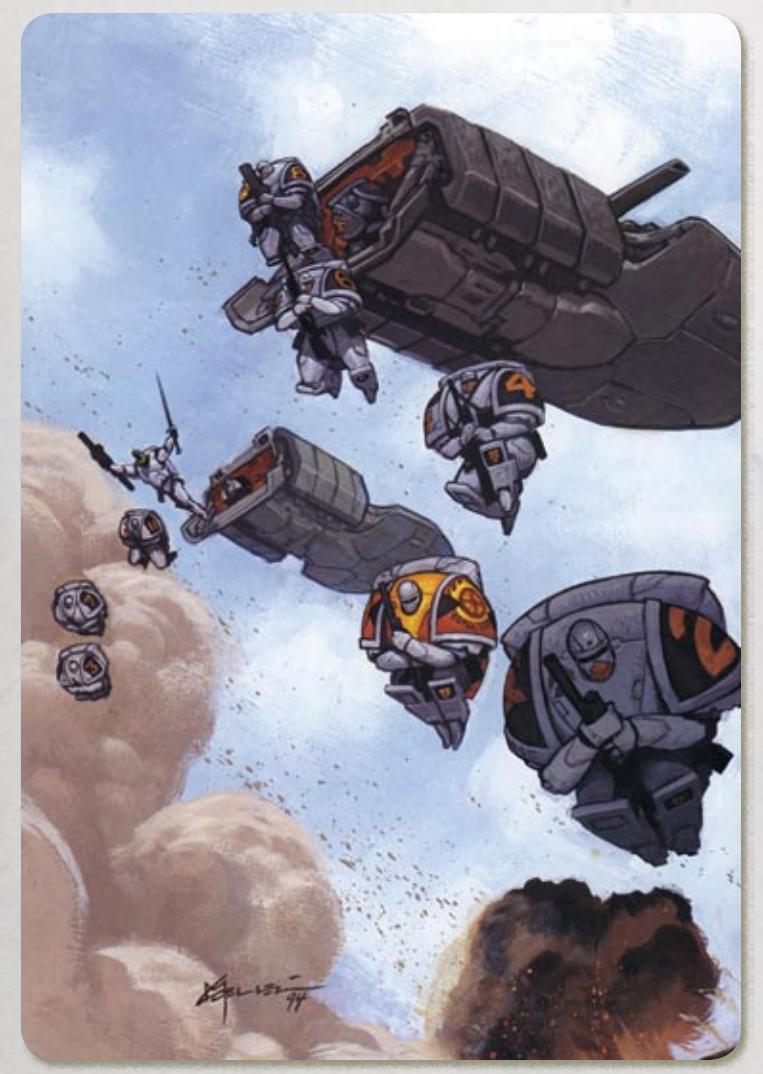
The Iron Empires' idea of a combat drop. Easter eggs of death! Note the
 Kerrn in the back - I'm so burning one later.
Kerrn in the back - I'm so burning one later.
Factions! After they are Assessed and Action is Taken on them, they are activated and their disposition is added to the side that Took Action on them for the phase. The activators may use the faction's assets to aid them, or drive them out: either way they get the disposition, but they must describe what they're doing to the faction.
Downtime! The winner on a Conserve, Go to Ground or Pin may choose (it's not mandatory) to generate downtime. It is breathing space for regrouping, replenish resources and polishing skills. Each success on a Go to Ground gives the winner three months of downtime and the loser a single month. Successes on a Conserve must be split between downtime and replenishing disposition, but it's also three months for the winner and one for the loser. A successful Pin gives three months of downtime for the winner and one month to the loser. It's not that time passes differently for each side, it's that the losers are slower to catch on and the winners can employ their time better. In downtime, characters may recover Resources, practice skills, and so on. There is downtime between each phase: the winner chooses a reasonable amount of time, and the loser gets half of that. Downtime may be part of the compromises at the end of a phase.
Speaking of the end of a phase! The winners accomplish their intent, the losers don't, but it's unlikely that the winners did so unscathed. This is compromise , concessions that the winner must make to the loser. If the winner only loses a few dice from their disposition, no concessions are in order. If their disposition was knocked down by a quarter or a third, minor concessions must be granted. If they lose half or more, the losers get a serious concession, or negotiate so that the losers get nothing but the winners only get half of what they wanted. If the winners lose all but 1-3 disposition points, a major compromise must be made: they won by the skin of their teeth. All of this negotiation is done at a player level, which might be different from what the characters themselves want. In a 0-0 tie, neither side gets their intent, but both sides get a major compromise. Or, if you're feeling fancy, both sides get both their intent and a major compromise, for full-on carnage. Once the phase is over, the winners get to play out an epilogue in which they describe how their
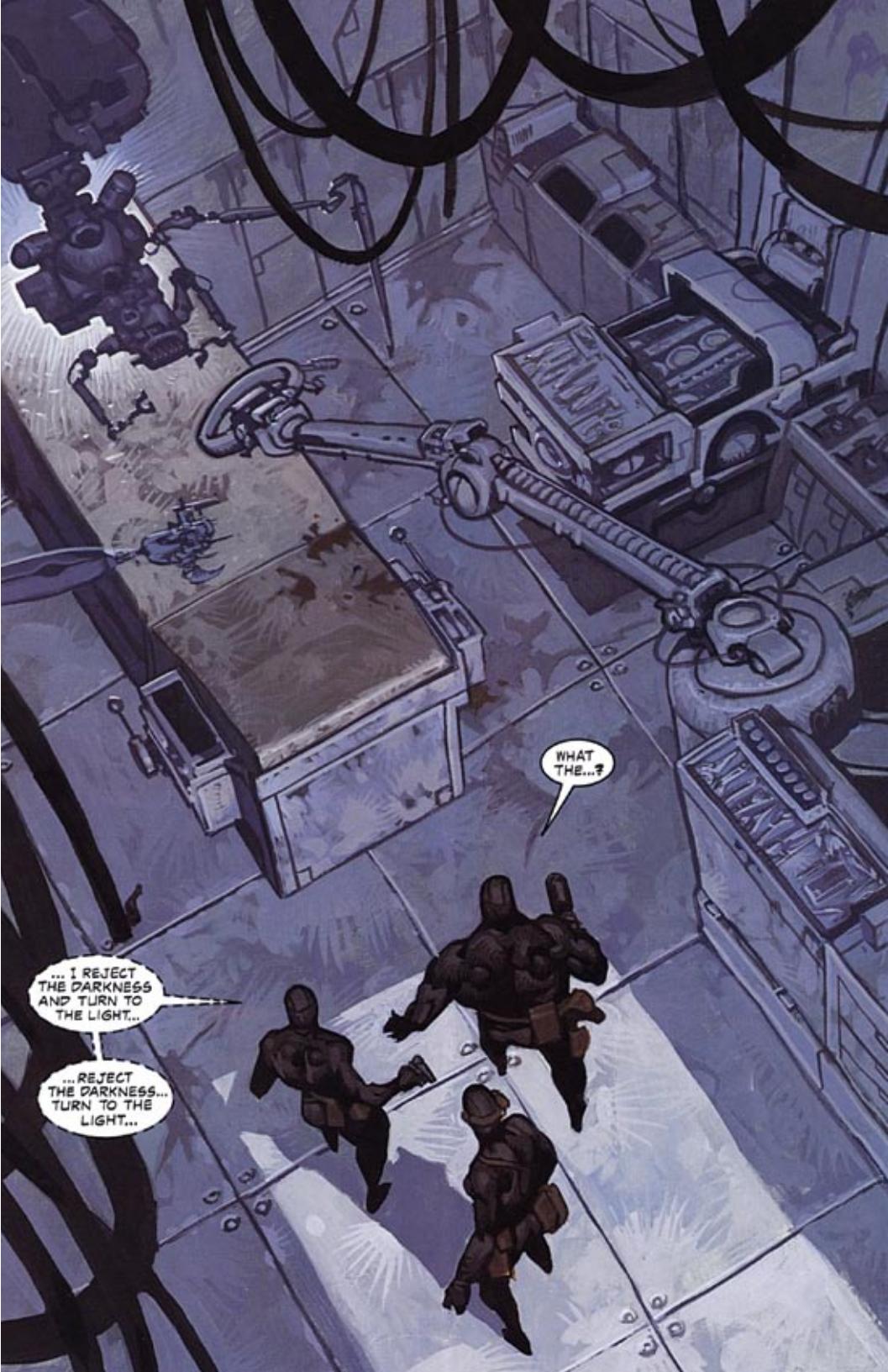
Vaylen labs aren't exactly a cozy thing to find!
Next: Game of Boners.
I say, good sir!
Original SA post Burning EmpiresI say, good sir!
A short update because the next is a woozy. Now we go into the first of the two big personal-scale conflict subsystems. Duel of Wits is basically BE's social combat system. Characters use verbal attacks and maneuvers to dismantle opposing arguments and make themselves look correct. Note that this is explicitly not mind control or anything like that: it is an argument, and while a character may change their mind after losing a Duel of Wits that is not the goal. The game compares it to a performance battle between a violin virtuoso and a crass comedian - maybe the former is objectively a better artist, but the audience ended up liking butt jokes the best. Duel of Wits can't make a character like something or change a Belief or anything like that, but it can force them to agree to something, if only for the time being.
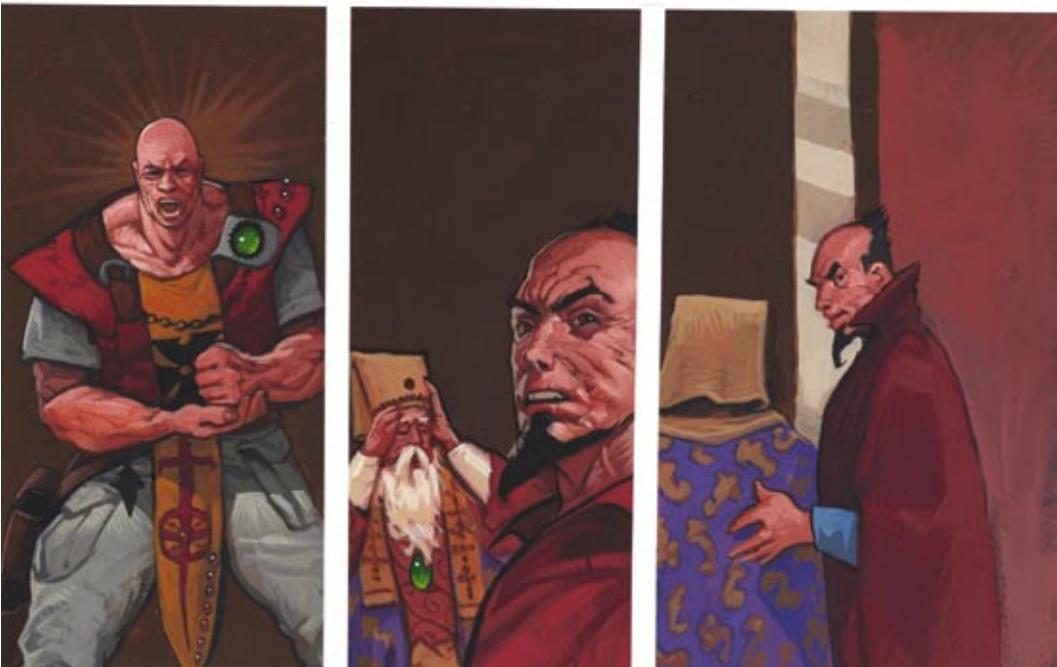
"Come now, Your Grace, don't be bothered by the angry bald man."
There must be at least two characters willing to defend disparate positions to engage in Duel of Wits. Each character must describe their position and why they're right to other players: that is the statement of purpose, the intent of their Duel. The player must state what they want from the other character. This is a metagame concern: both sides must agree to the stakes involved. "If I win, you will bring the Forged Lord to me." "If I win, you are convinced that I have no power over the Forged Lord and can't be used against her." "The Arch-cotare will purge the church of the Inquisitor's influence." "The Inquisition is a legal entity and will be allowed to handle its own affairs." And so on. Demands should be reasonable and achievable, and major, world-saving issues should be divided in smaller arguments spread across multiple duels. Once both sides agree to the stakes, they test Persuasion, Rhetoric, Oratory, Interrogation or a special skill and add the successes to the character's Will exponent: that is the body of argument , and similar to Disposition in the Infection rules, it is the "HP" of the character in the Duel. If the GM judges the debate to be very important, then the body of argument may be Will + skill exponent without rolling, and if it's a minor matter it can be just the Will exponent. Many traits affect Duel of Wits, and at the GM's decision certain character traits that are relevant (try persuading a Stubborn character) may grant +1 to the body of argument per trait. A character may never be forced into a Duel of Wits: they can always walk away , with the sanctity of their argument intact. However, if they choose to do so they can't argue the point further - they're done.
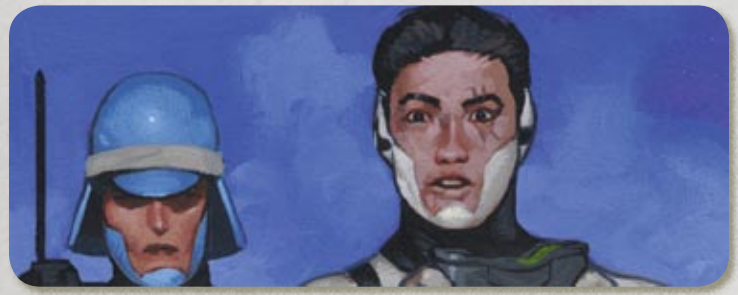
And that's when Bob realized his anvil suit did not have a poop chute.
In a Duel, each character selects in private a sequence of three actions. Each "round" of the Duel is called an exchange , divided in three volleys. In each volley, the actions of the characters are revealed, then compared. As volleys are called, the characters announce their maneuver and roleplay them out - a short thing, a couple of sentences at most, but the GM can decide to give disadvantage to a side that doesn't make the least effort to act the maneuver out. Each maneuver has its own skills (sometimes stats) to be tested, and in addition to those the skills of Etiquette, Falsehood, Ugly Truth, Seduction, Soothing Platitudes, Conspicuous and Intimidation may always be FoRKed into them as long as they're roleplayed into the action. Relevant -wises may also be used as FoRKs if the player quotes a piece of pertinent information. Certain skills have special effects: Divination, for instance, actually allows to set a Belief change as a stake, but only in the context of a priestly character using it to divine another character's future and persuading them of a certain course of action.
The actions are:
-
Avoid the Topic
(Will) The speaking player must veer off-topic. If opposed to a maneuver, subtract Avoid successes from the opponent's own successes. It does nothing against independent maneuvers.
-
Dismiss
(Oratory, Rhetoric, Intimidation, Interrogation) Well, obviously the fool knows nothing and shouldn't have to be listened to! Dismiss adds 2D to a roll to reduce the opponent's body of argument, but if the duel isn't won in that volley the dismissing character hesitates for the next volley.
-
Feint
(Interrogation, Seduction, Oratory, Rhetoric, Suasion, Persuasion) A verbal trap where the character leads the opponent into thinking they're talking about one thing before revealing a hidden barb. Subtract margin of success from the opponent's successes for their action. If the enemy action is independent, Feint does nothing. If the enemy action is a Rebuttal, Feint automatically succeeds and grants the character a free Point against the opponent.
-
Incite
(Interrogation, Seduction, Ugly Truth, Intimidation, Falsehood, Command) Insults, distractions and threats. Test the skill against an obstacle equal to the victim's Will: if successful, they must test Steel to keep from hesitating on their next volley. Opposed actions subtract net successes from Incite, but if enough successes to match the opponent's Will remain it goes through.
-
Obfuscate
(Seduction, Begging, Soothing Platitudes, Oratory, Rhetoric, Falsehood, Ugly Truth) The character must present a non-sequitur or bizarre, unrelated point. Test the skill against whatever the opponent is using, even another Obfuscate: if the roll is won, the opponent loses their current action, and if the obstacle is exceeded the opponent gets +1 Ob to their next action. +2D against Dismiss.
-
Point
(Interrogation, Oratory, Rhetoric, Suasion, Begging, and Persuasion) The basic verbal attack. Point successes reduce the opponent's body of argument, but are reduced by opponent's successes in versus maneuvers.
-
Rebuttal
(Interrogation, Seduction, Oratory, Rhetoric, Suasion and Persuasion) The character lets their opponent make a Point or Dismiss first, then counters it. The dice pool is divided in attack and defense, with a minimum 1D in each: defense successes subtract from a Point or Dismiss and act as obstacle for an Obfuscate, while attack dice act as a Point.
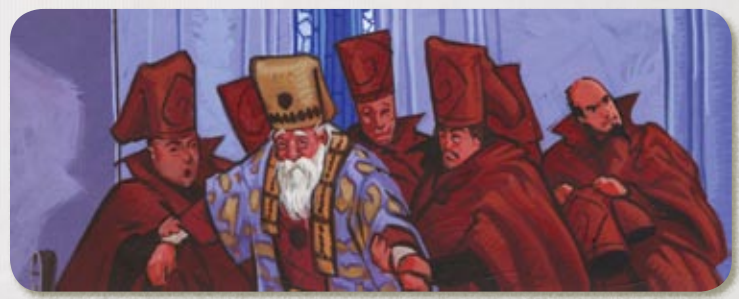
"N-no, My Little Vaylen is a good show... I need to rest a moment."
Once a body of argument hits zero, the winner gets their stakes and the loser has to abide by them. Like in Infection, odds are that the winning argument won't come up unscathed, and so the loser may negotiate a compromise depending on how many points they manage to knock off the winner's argument. It is possible to escalate an argument to violence: the loser forgoes their compromise, and starts a conflict scene (in a firefight) or a building scene (a fist-fight) Baiting Beliefs, Instincts and traits is encouraged, as well as playing along with the bait - free Fate points! If the Duel had an audience, they're now convinced that the winner is right. The stakes are binding: if you were convinced that your lover is a Vaylen when she's not, better get ready to deal with her! Hey, you didn't have to stay for the Duel in the first place. In group duels with two defined sides, one character on each acts as the primary speaker and the rest can speak up to add help dice to their side (or the other!), with the consent of the primary speaker - in the Help rules there's an example where one player attempts to help by using Ugly Truth to denounce the military junta's evil, and the speaker refuses because they're trying to convince the junta to join them in the first place
 It is possible to have multiple bodies of argument in a Duel of Wits, though not encouraged. In this case, Avoid and Obfuscate protect against all attacks in that volley, while Rebuttal, Point, Dismiss, Feint and Incite may only have one target each volley. The level of compromise for each character is measured depending on the remaining body of argument of the side that knocked them out of the Duel at the time they did, not the final total.
It is possible to have multiple bodies of argument in a Duel of Wits, though not encouraged. In this case, Avoid and Obfuscate protect against all attacks in that volley, while Rebuttal, Point, Dismiss, Feint and Incite may only have one target each volley. The level of compromise for each character is measured depending on the remaining body of argument of the side that knocked them out of the Duel at the time they did, not the final total.
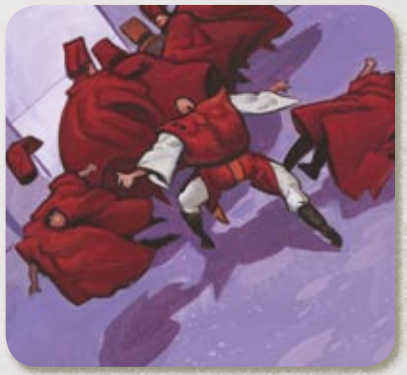
RAAAAAGH FUUUUUUCK YOUUUUUUUU
Bonus: the Kerrn poet is here.
code:
Shogun
32 year old Kerrn. Homeworld: Parker's World. Index: Zero.
Lifepaths: Born Kaklakesh > (setting transfer) > Mezz > (setting transfer) > Solzjah > Sayeret > Shayatet > Surge > Eltee
Beliefs:
My poetry is the best. If you think different, show me your work!
The Arch-Cotare saved my soul. I must guard his.
The enemy is cowardly. Better off slaying them at night.
Instincts:
Always ask people's opinion of my poetry.
When in a new place, note the position of guards and security.
Never let someone else touch my sword.
Traits:
Bioengineered Organism, Kerrn Accent (goddammit I'm not dealing with this), Massive Stature, Not Easy Being Green,
Super-Mutated IgE, Unbridled Hatred, Cold-Blooded, Sharp-Eyed, Gruff, Krav Magah Trained, Quiet, I, Solzjah, A Bit Mad, Cryptic
Stats: Will 4, Perception 5, Agility 4, Speed 4, Power 6, Forte 5
Resources 5, Circles 2, Mortal Wound H11, Steel 5, Hesitation 6
Skills: Command 5, Tactics 4, Explosives 3, Recon 4, Soldiering 2, Cooking 2, Zero-G 2, Close Combat 5,
Supply-wise 2, Assault Weapons 3, Observation 4, Physical Training 2,
Security Rigging 2, Solzjah-wise 2, Intimidation 2, Infiltration 3
Affiliations and Reputations:
I, Solzjah - 1D with other Sozljahs
1D affiliation with the Black Gate, church's enforcers
1D reputation as the spooky head-honcho of the Black Gate
Relationships: The Arch-Cotare Solvalou, who brought him along when he was a lonely cook on a mercator with nowhere else to go
Sergeant Hansa Belvedere of the Black Gate, hardass but loyal second in command
Technology:
Stet-gun (think needlegun)
Kerrn Sword (powered, costs extra due to it being Low Index)
 Kerrn lifepaths are very lacking in general points to be used in stuff outside of their lifepaths. Kerrn settings are always native to them excepting Diazspherah, which is non-native by default unless made native in the world burning session.
Kerrn lifepaths are very lacking in general points to be used in stuff outside of their lifepaths. Kerrn settings are always native to them excepting Diazspherah, which is non-native by default unless made native in the world burning session.
Next: there was a FIREFIGHT!
FIREFIGHT!
Original SA post Burning EmpiresTraveller posted:
Next: there was a FIREFIGHT!
Ho-boy. This chapter deals with the game's combat system, appropriately named Firefight. Its fantasy counterpart, Burning Wheel, has two combat systems: Range and Cover for ranged combat, and Fight! for close-in work. BE is a lot more reasonable in that the same system is used for both things. Firefight is used when characters wish to undertake a conflict scene involving military action. It scales from squad level combat all the way to entire wings of hammer slogging it out in high orbit. Similar to the other two subsystems we've seen so far, in Firefight each side plays out a number of maneuvers and attempts to reduce the enemy's disposition to zero in order to achieve their objective.
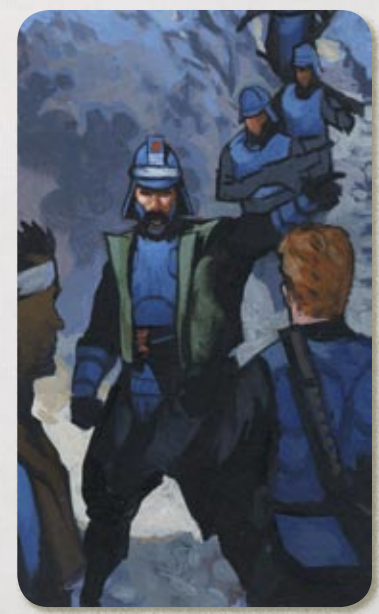
You, test your Cooking skill. I need a sammich.
Each side in a Firefight is represented by one or more units or teams. An unit has an officer or leader and an objective . They can be as small as a single soldier or as large as a whole fleet of warships. The simplest form of Firefight involves two units, one on each side, and while it is possible to have more units in play it is recommended to start small until people get used to the system, so a side's unit should include all of their characters and allies involved, even if hundreds of soldiers are involved. Even if two groups aren't geographically (or ideologically) coherent, they should be part of the same unit if they share the same objective. Depending on their abilities, PCs may be unit leaders or line members. The number of units must be the same for both sides, and if one side can't or won't break down their forces into more units then the other must consolidate theirs until they match.
First, the battle space is defined. The GM describes roughly the environment in which the Firefight will take place. Drawing a map helps, but it's not necessary to get too specific with distances and such, only enough so that everyone has a good idea in their heads of the field. Before the battle begins, each unit declares their objective. This is their intent in the Firefight. Note that "killing the enemy" is explicitly not an acceptable objective, because it is always assumed that units are trying their best to neutralize their enemies. You must want something else: occupy the temple grounds, seize the bridge of the space station, raid for prisoners, knock down the tower, defend the granary, take the refugees to safety, etc. Each goal should be small and manageable, and hopefully set up grounds for a new conflict in the future. Once objectives are set and agreed on, the sides make contact : they perform their initial maneuvers, positioning and sighting. Even if the sides know where the enemy is, they must make contact. It is an Observation, Signals or Sensors versus roll, with bonus dice from technology or help as appropriate. The winner of this roll may gain the contact advantage for their disposition, or they may occupy a position at the start of the Firefight. They may also make a case for range superiority. More on these, later.
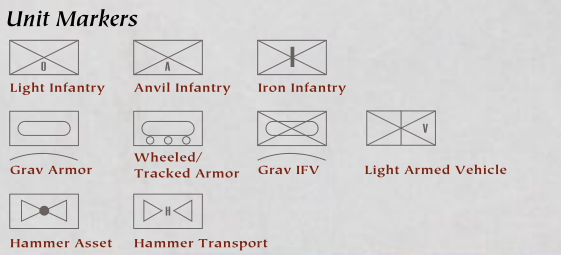
You neeeeeeeeeeeerds
Each unit has a disposition , which as we've seen before is their HP for the conflict. The leader of each unit tests Tactics or Command, and successes translate directly into disposition points. Command can only be used if there are soldiers to command, mind you. If the leader doesn't have either skill, test Perception or Will and count half the successes rounded down. After the roll is made, there are a number of bonuses to disposition: did the unit's side win the contact roll? Do they have a superior position? Do they outnumber the opposition? Is there a psychologist connected with the troops? Do they have superior communications? Is their training better? Is their weaponry superior (depending on the battlefield, short-ranged shotguns and pistols beat high-index railguns and plasma cannons if they're fighting in a cramped space station)? Do they have better infiltration? Do they have the right tool for the job (a tracking device to capture a VIP, for instance)? Do they have iron? In case of vehicle warfare, do they have a heavier chassis, or greater mobility? All of these grant +1 or +2 points depending on circumstances. If the unit's leader blows their roll or doesn't have the skill and none of these bonuses apply, the unit has a minimum disposition of 1.
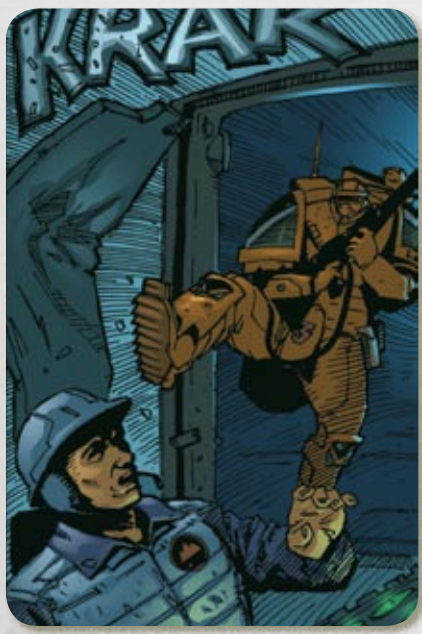
Surprise, motherfucker!
In the battlefield, there are a number of positions that can offer units tactical advantages. Higher ground, bunkers, cloud cover, ravines, asteroids, gravity wells and so on. Positions are rated from 1P to 5P, depending on their value in the engagement. They do not necessarily provide cover. When starting a fight, the GM notes all of the likely positions in the battlefield, marking them at a rating of 1 to start. The winner of the contact test may then add another two 1P positions to the battlefield, or increase two already existing 1P positions to 2P or one 1P to 3P. If the winner did not take the contact disposition bonus, they may choose to occupy one of these positions to start. The loser of the contact test can add one 1P position or increase an existing position by 1. After this, the GM may modify an existing position, raising it to a maximum of 5P. They may do this to an occupied position or a neutral one. A position is not an objective: they're won and lost much more easily, since achieving an objective means reducing the enemy's disposition to zero. After positions are marked, the GM determines which of them provide cover . Cover is rated from 1C to 3C, and raise the obstacles for shot opportunities in combat. If the entire battlespace is crowded or cramped, the GM may set a general cover rating for the whole field. Occupying a position requires a successful Advance maneuver, and doing so temporarily adds its rating to the unit's disposition. This value is lost if the unit abandons the position, or if its disposition is reduced by the position's value. To engage an unit in Close Combat, the attackers must advance into their position or be defending from an enemy closing in: either both sides benefit from cover or none do in this case. An unit that Withdraws, Flanks or fails to Advance is considered to be in 'no man's land' and may be engaged in Close Combat by any unit that has no intervening positions between them. However, as long as the unit continues Advancing into the position, the successes are saved until the maneuver is successful: this is useful when a position is far away, which is represented by giving it a large position value. Distances are pretty abstract. Still, an unit must move from position to position, no leap frogging all over the field to occupy a place on the other side.
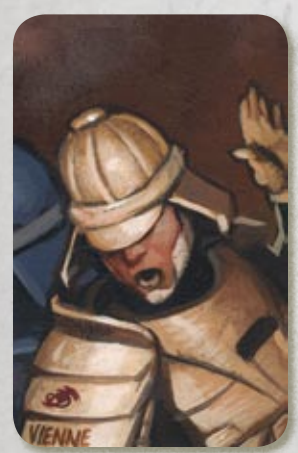
Vaylen please.
Range is abstract as well. We're given some numbers, but mostly to keep the action right in our heads. Close combat happens at 20m or less, most infantry engagements are fought at 200-1000 meters, vehicular Firefights range up to 50 kilometers, and space Firefights happen across thousands of kilometers. Weapons are divided in five categories, from longer to shorter range: Artillery, Vehicular Weapons, Squad Support Weapons, Assault Weapons and Close Combat Weapons. A side that wins contact and has weaponry in a longer range category than the loser, they may declare Range Superiority : +1D to Direct Fire and Suppressive Fire for each rank of range they have on the opposition. A successful Advance or Flank denies this advantage, however.
Once the battlefield is set, each unit's leader privately notes their actions. Like in the Duel of Wits, FIrefight plays across three-volley exchanges. As an optional rule, the side that finishes noting their actions first gains +1D to their first volley, but the GM should not use this rule to punish inexperienced players. Each maneuver can have special requirements, unit action (what is actually rolled for the maneuver to succeed), success allocation and individual action (what individual members of the unit may do on a success, not all maneuvers have individual action) Help for unit actions may only come from members of the same unit.
The actions are:
-
Advance
(Command, with help from the vehicle's pilot if applicable): This is used to close ground with the enemy or take up a new position. Against versus actions, the leader must win by the value of the position they try to occupy. Against independent actions the obstacle is 1 plus the value of the position. After occupying a position, extra successes may degrade the enemy disposition in a 2-1 ratio. If the action is a tie, an individual member may test a tiebreaker skill (something to do with movement, like Physical Training, Zero G or Drive) against the opponent's individual action test or their unit action's skill at its root stat. The winner counts as winning the unit action by the margin of success.
-
Close Combat
(Tactics or Command): This is used to bring pistols, grenades, claws, fists and so on to bear. It requires that the unit gets into the same position as the enemy, have the enemy attempt an Advance on them or be caught out in no man's land. If the Close Combat plays out and these conditions are not met, the unit hesitates for the volley. Against independent actions, its obstacle is 2. Generally both sides lose disposition in Close Combat: divide the margin of success from the unit action. If unequal or 1, the greater amount is assigned to the loser of the unit action, otherwise they're split evenly. Each unit loses that much disposition. All characters in each unit may then choose a Close Combat individual action in private.
-
Direct Fire
(Tactics or Command) Pew pew. In order to use this action, the unit must have Observed the target unit in a previous volley. If the Direct Fire triggers without a successful Observe, the unit hesitates. The obstacle for independent tests is 2. In versus tests, each extra success buys one
shot opportunity
or
specialist action
. In independent tests, meeting the obstacle earns one shot opportunity, then extra successes can be spent. Once all members of the unit have been given a shot opportunity, extra successes may be used to grant them +1D advantage each for shooting. Also, the unit's leader may not shoot until everyone else has. The team targeted by Direct Fire may choose which characters take the hits. A character with a shot opportunity may then fire on the target with an obstacle of 2 + cover. If the shooter meets the obstacle, they hit. Alternatively, they may use a specialist action. Incapacitating a member of an unit degrades their disposition in 1 per casualty, and if the member was the source of a disposition bonus (the radioman that gives Superior Comms, for instance) they lose that too.
-
Flank
(Tactics, with help from the vehicle's pilot if applicable) The unit maneuvers to hit the enemy from a side. All positions are abandoned once a Flank is played. Against Take Cover, it is obstacle 1. Against Direct Fire, Ob 2. Against Rally, Ob 3. The margin of success is subtracted from the enemy unit's disposition. Alternatively, the player may spend up to three successes to gain +1D each for a subsequent Direct Fire or Suppressive Fire. They may also buy specialist actions. On a tie, an individual member may attempt to break the tie as in Advance.
-
Observe
(Observation, Psychology, Signals, Sensors, Hunting) The unit spots enemies on the move before they complete their maneuver and locates firing units as they fire. Ob 2 against independent actions. If successful, the unit may Direct Fire at the target.
-
Rally and Regroup
(Command, Psychology) The leader rallies brings a character that failed their Steel test into the fight. Ob 2 if the character failed a Steel test due to Suppressive Fire, Ob 3 if the character failed due to an Injury, Ob 4 if the character was Maimed. The leader must rally troops individually. They may attempt to rally as many troops as they want, but each cowering soldier can only be rallied once per Firefight. If successful, disposition points lost due to hesitating characters are restored.
-
Suppressive Fire
(Tactics) Lay down lead downrange and keep their heads down. Suppressive Fire successes are subtracted from the enemy action's successes in a versus test. If it's independent, the obstacle is 1. Squad Support Weapons, Vehicular Weapons and Artillery give +1D to Suppressive Fire. Grenades can be used if appropriate for +1D, and allow the use of Explosives or Close Combat in a shot opportunity. Extra successes can be used to force Steel tests on the enemy unit (1 success, suppressing unit chooses who has to make the test in the target unit), degrade enemy disposition by one point (2 successes), reduce enemy cover in one step (2 successes), increase the obstacle of the next enemy action by 1 (2 successes), purchase shot opportunities (3 successes, no advantage dice) and purchase specialist actions (1 success) as in Direct Fire.
-
Take Cover
(Command, Infiltration, Helm, Pilot, Driving) The unit gets out of harm's way. Its successes subtract from versus actions. If played as an independent maneuver, it is an Ob 1 test. If more successes than needed are generated, the unit may dig in, adding them to their position's cover rating, or they can be spent on specialist actions.
-
Withdraw
(Tactics, Command, with help from the vehicle's pilot if applicable) The unit withdraws and attempts to draw the enemy out of their position. Against another Withdraw, it is Ob 1. Against Take Cover, Ob 2. Against Rally, Ob 3. Against Direct Fire, Ob 4. If the unit had been Observed by the enemy, they lose their Observe and must perform it again to fire. If the enemy has longer ranged weapons, they gain range superiority. The Withdrawing unit loses any position it had and ends in no man's land. Withdraw subtracts its margin of success from the enemy disposition but also from the withdrawing unit's disposition on a versus roll. On an independent roll, the withdrawing unit loses two disposition and makes the target unit lose up to margin of success. Ties may be broken as in Advance.
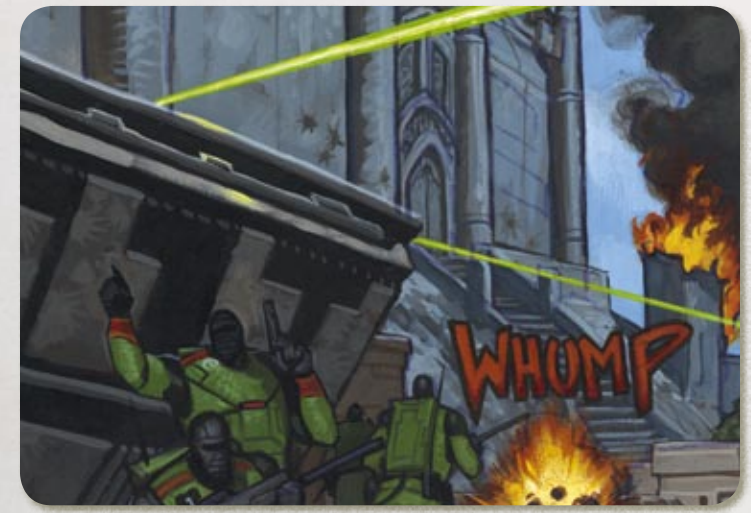
WHUMP is never an acceptable SFX for an explosion.
In Close Combat, each character in the involved units must select one of four intents:
-
Hand to Hand Combat
: the character dives in. Versus Close Combat test or against Ob 3 if they take an independent action. If it meets the obstacle or wins the versus, it's a hit. If the opponent is incapacitated or killed, their unit loses 1 disposition. This does not stop Weapons Fire, it happens at the same time.
-
Weapons Fire
: The character opens fire. Versus Close Combat test or against Ob 2. Non-Close Combat weapons suffer obstacles, from an extra 3 obstacle for Assault Weapons and only growing as the weapons become bulkier and more unwieldy. If the Weapons Fire succeeds, it counts as if the character hit their enemy with a shot opportunity in a Direct Fire. As above, killing or incapacitating the target reduces the enemy disposition in 1.
-
Grenades and Bombs
: the character uses explosives. If the character wins their versus test, they throw the grenade before the enemy can react. Ob 3 Close Combat roll if both use grenades.
-
Overbear
: the character attempts to knock down and disarm an opponent with minimal harm. Versus Close Combat test, Power test to break off ties. In an independent test, its obstacle is the target's Close Combat skil exponent. Margin of success is applied to the loser's next Close Combat action, but if the Overbearing character adds an obstacle to their own roll equal to the target's Speed or Power (whichever's lower) then they pin and capture the target.
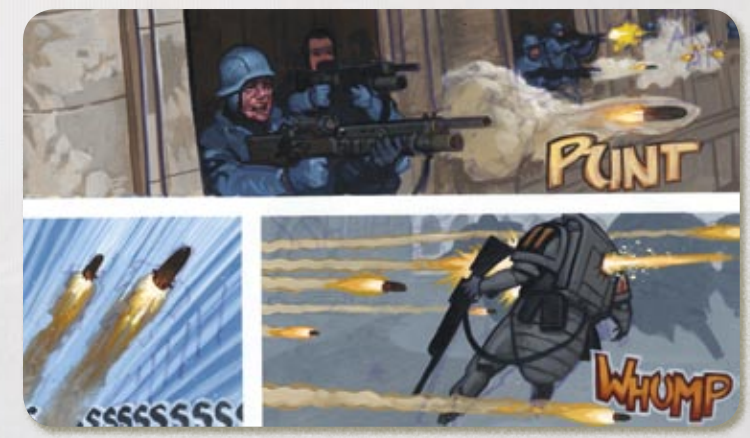
PUNT is... I guess it's alright for an underslung rocket grenade launcher?
Isn't this too much of an overkill system? Sometimes you just want to punch a guy. Some times you just want to Corner Him And Stab Him In The Face. For violent conflict that doesn't require a Firefight, usually because both characters are in each other's faces, you use these rules. I Corner Him And Stab Him In The Face comes in two flavors: the first one is a simple Close Combat action, one roll only. Intent is stated, the roll is made, and that's it. The fight is over. This counts as a building scene, and requires some sort of lead-in in the form of a previous test in which the attacker corners the target, or similar. If the fight requires something more than a single roll, I Corner Him And Stab Him In The Face can be run as a mini-Firefight. This counts as a regular conflict scene. An objective, a map and a few positions and cover are set. No contact roll, officers use Close Combat instead of Command for actions, and the only possible actions are Advance, Withdraw and Close Combat. I Corner Him And Stab Him In The Face can be chosen as a full concession in a Duel of Wits that was lost - the losing side can demand to get close enough to take a shot at the opposition.
We've mentioned specialist actions before. A character taking one can't do anything else during that volley. Multiple specialist actions can be bought for an unit's members, but only one of each type may be played each volley. They are:
-
Medic!
: roll Surgery or Field Dressing to patch up a fallen comrade.
-
Signals Warfare
: the character must have the Signals skill and signals tech capable of a degree of automation. Make a versus test against the enemy's Signals operator, or at Ob 2 if they don't have one. If you win by 1 success, the Superior Comms disposition bonus is lost for both sides. If you win by two, the enemy loses Superior Comms and you get it. If you win by three, in addition to the bonus you jam the enemy communications, which means characters in the target unit can't help each other unless they're physically next to each other. On a tie or loss, the Superior Comms bonus remains where it is. Higher index tech gives bonuses to this roll.
-
Demolitions
: roll Explosives to destroy a position occupied by the unit. The obstacle is twice the value of the place. If successful, it is gone and has no further value. It is also possible to mine the location (Ob 3). Extra successes increase the obstacle of an Advance to take the position, and if that Advance fails the unit gets hit by explosives. The target unit may choose which of its characters gets hit.
-
Sensor Sweep
: roll Sensors + target profile to detect vehicles and iron. Iron counts as having a profile of 0. The opposing side tests Signals plus any relevant help, or Helm/Pilot/Drive plus relevant help if they're trying to take evasive action. On a win, the sweeping unit gets +1D to their next Observe, Suppressive Fire or Direct Fire.
-
Psychology
: the psychologist may use their Boost power, offer a connection or Lock a connection. They may not engage in a psychic duel. More on these on the Psychology rules.
-
Security Warfare
: when fighting in installations or vehicles with Security systems, a successful Ob 3 Security test allows the Security skill to be used as Observation for the rest of the Firefight. Or it may be used to hack the security network (Ob is the security system's advantage dice, or 1 if it has none) in which case it can no longer be used to Observe.
-
Damage Report
: roll Fire Control or Jury-Rigging to patch up a damaged vehicle or ship. Repair must be used after a Firefight, during a building scene.
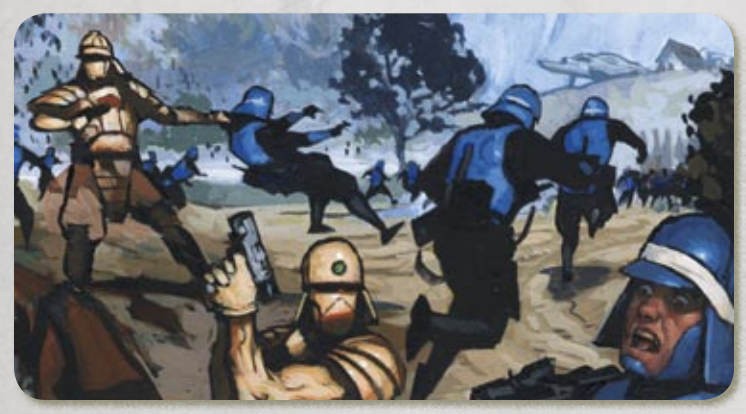
Haha fuck no guy you stay here and fight the murderbears
A few tidbits: a character forced to take a Steel test (due to getting hit, taking suppressive fire, etc.) and losing it by less than half of their hesitation can't act on their next volley, and their contribution to their disposition is set to zero for one volley. If this reduces the unit's disposition to zero, they're out of combat. If they fail for more than half of their hesitation, they won't return to fight until they're successfully Rallied. If it's the unit's commander, the second in command may assume control, or the unit's members will have to pick a new leader on the spot. When shooting at an unit, all shots must be divided across their members: all of them must take at least one shot before the target unit's controller may double up. This must be done before rolling for damage. Any unit may surrender at any time before the volley's actions are revealed, in which case they're at the mercy of their opponents. Any trickery on their part has to wait until after the Firefight is done. The captors may, of course, choose to execute everyone on the spot - roll a die for each character, and on a natural 1 they are Maimed, but survive without their captors' knowledge. Similar to Duel of Wits, a side can't be forced into a Firefight: they may always cut and run before the battle is joined, in which case the other side may elect to chase them (treat as a building scene), and if they win then the escapees are forced into the Firefight. But you just said you can't be forced into one! Oh well. If a side cuts and runs from an objective they're defending, they give it up without a fight. But once objectives are declared and initial rolls are made, cutting and running are treated as surrender. Oh, and ambushes are treated as an Infiltration vs Observation or Signals test as a building roll prior to the fight: if this roll is won, the ambushers get Superior Position, and if it and the initial contact roll are won then their unit gets a free Direct Fire on the enemy.
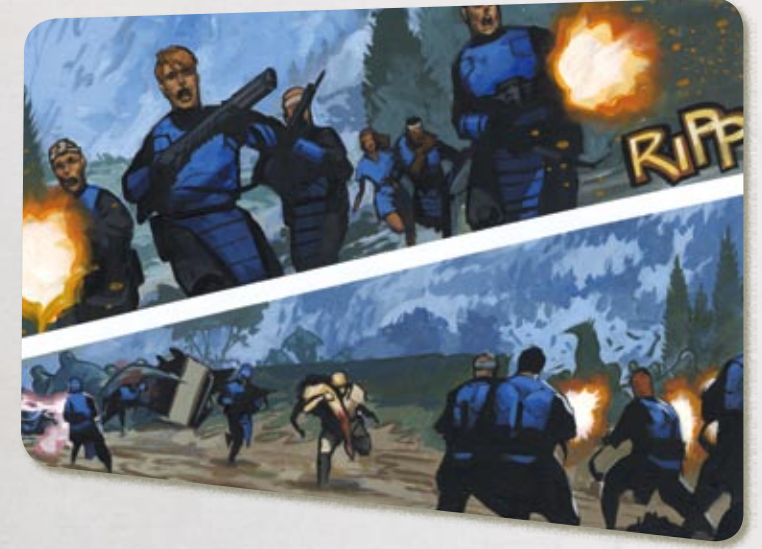
SQUAD MORALE RESTORED
As mentioned before, it's possible for units to involve lots of members, hundreds or even thousands of soldiers. The commander is always the focal point of the action, the one making the unit action, Steel and ammo check tests. The individual or specialist tests are made by the soldiers under their command. Generally, in a moderately sized battle, an NPC soldier that takes an Injury is down and out of the unit's disposition, but in really massive battles it only takes any form of hit to do them in, no damage or Steel rolls necessary. The basic scale of the Direct Fire action is for units of five people/guns/ships, and as more members are involved so does the scale grow. This is just for color, it doesn't affect the underlying mechanics, but it does mean that one 'shot' in a big fuckfest can actually be five well-placed rounds on enemy heads. Still, numbers do count: units with the Outnumber or Outnumber by Vast Margin bonus deal more damage to enemy disposition. And then there's a page that says that if you're confused and feel the Firefight is a messy fuckfest, then that's the entire point of the rules. Fog of war, the chaos of battle, it all conspires to keep people from having full information. Sure, okay.
Some notes on multiple units per side in combat: everyone reveals their actions at the same time. Targets are chosen after the actions are announced. If two units use versus actions against another one, then they must negotiate which unit actually takes the action: the other one will help them with it. If you have one unit Advancing on the enemy position and another laying Suppressive Fire, then it may happen that the Advance is actually rolled for while the other unit helps by keeping the bad guys' heads down. Same if they're using two independent actions against the same team. They may act independently if they have actions against separate targets.
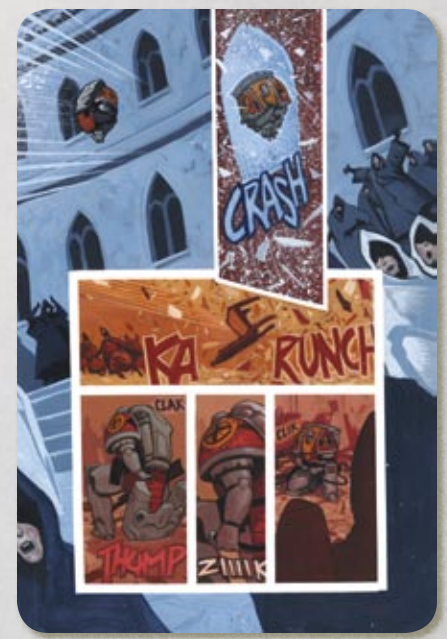

Weapons! I think I would've liked this chapter in the Technology Burner instead of the Firefight section. As far as BE is concerned, a weapon is a piece of tech that has the Weapon trait. This gives it a classification and an ammunition type, as well as a number of weapons-only technological traits. The classifications are Close Combat, Assault, Squad Support, Vehicular, Artillery and Explosives. Each weapon has a particular damage potential, divided in Incidental , Mark and Superb ratings. For instance, our Inquisitor's handgun deals H4/H7/H10, while our poet's blade deals H5-H10-H15. When hitting with a weapon, roll a die (the Die of Fate ), and compare with a small table to see how much they hurt the victim. Damage can be on the human scale, the vehicular scale and the superstructural scale: we'll talk about this when we get to injuries. Successes over the obstacle raise the Die of Fate roll: the better you hit, the more damage you deal. One extra success gives +1 to the DoF, doubling the obstacle gives +2, and tripling the obstacle gives +3. Weapons have funky names like CEBW ('chebu', Coherent-Energy Beam Weapon) and SCrEW (Sub-Critical Energy Weapon) The ammunition capacities, from smaller to larger are single-shot , capacitor , magazine , case , power pack and engine. After an exchange of Firefight where the Direct Fire, Suppressive Fire or Close Combat Weapons Fire or Grenades action were used, every character makes a skill roll depending on the weapon they're using. This is an ammo check. The obstacle starts at 1 and is increased depending on the number of orders executed, how many shot opportunities they had, etc. This obstacle doesn't reset across exchanges until the character fails, so it gets harder and harder to conserve ammunition. Weapons with a larger ammo capacity give +1D to this check per rank of difference. When the ammo check is failed, the character may not use the weapon on the next volley's Direct Fire, Suppressive Fire or Close Combat Weapons Fire. If no such order takes place, they may just reload the weapon with no further penalty. If for some gods-forsaken reason you're tracking individual magazines, then it means one is burned off. A specialist action can be used to reload, or the character may switch to a secondary weapon to keep shooting. Weapons that overheat, like lasers with power packs, can be pushed : forced to fire after an ammo check, but if a second ammo check is lost the character takes an H7 wound and the weapon is rendered useless. After a particularly intense volley in which both sides have discharged their weapons, any character may call for an ammo check then and there by spending one fate point. Generally, ammo checks are made by individuals, but people can potentially help each other when dealing with squad support weaponry and other big guns. Close combat weapons have a fixed IMS like all others, but the damage is affected by Power: at Power 3 or less, the DoF gets -1. At Power 6 or 7, it gets +1, and at Power 8 it gets +2. An unarmed attack has an IMS of half the Power rounded up/Power/Power times 1.5, which means that a Power 8 Mukhadish is in fact better off laying down the law barehanded than armed with a sword or rock.
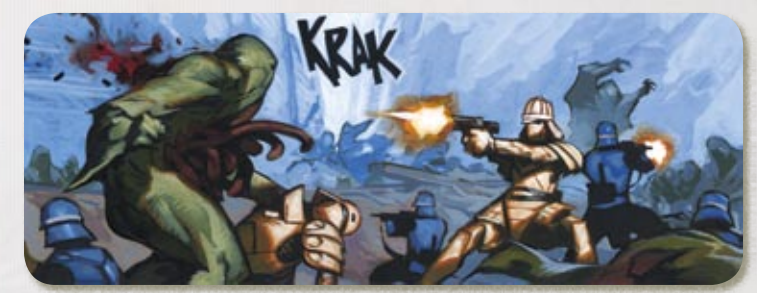
Fucking murderbears, seriously. Mooks should never be this disturbing. READ SHEVA'S WAR.
Injury! Each character has a Physical Tolerances Scale . There are three scales of tolerance, like damage: Human , Vehicular and Superstructural. Characters only have human tolerances. Some objects are also only as tough as a person. Damage from a vehicular-scale weapon will destroy anything with human tolerances, and damage from a superstructural weapon will destroy anything with human or vehicular tolerances. A character's tolerance scale is divided in four sections. Superficially Wounded , Injured , Maimed and Mortal Wound. Once a hit is taken and the DoF is rolled, mark the damage on the character's sheet. Each new wound is its own entity, they aren't added together. Wounds impose wound penalties that may last a single scene, all the way to the whole phase or even further. Superficial wounds are small things that cause eye-watering pain but quickly fade. A single Superficial does nothing, two count as an Injury and deal -1D. They disappear at the end of a scene if they aren't compounded into an Injury. Injuries are bad burns, fractures, broken noses and such. -1D. Maimed results are shattered bones, internal bleeding, third degree burns, the works. -3D. Mortal Wounds are that, mortal - the character is down. Wounds that are less than Superficial don't count for anything, and wounds on or over the Mortal Wound are fatal.
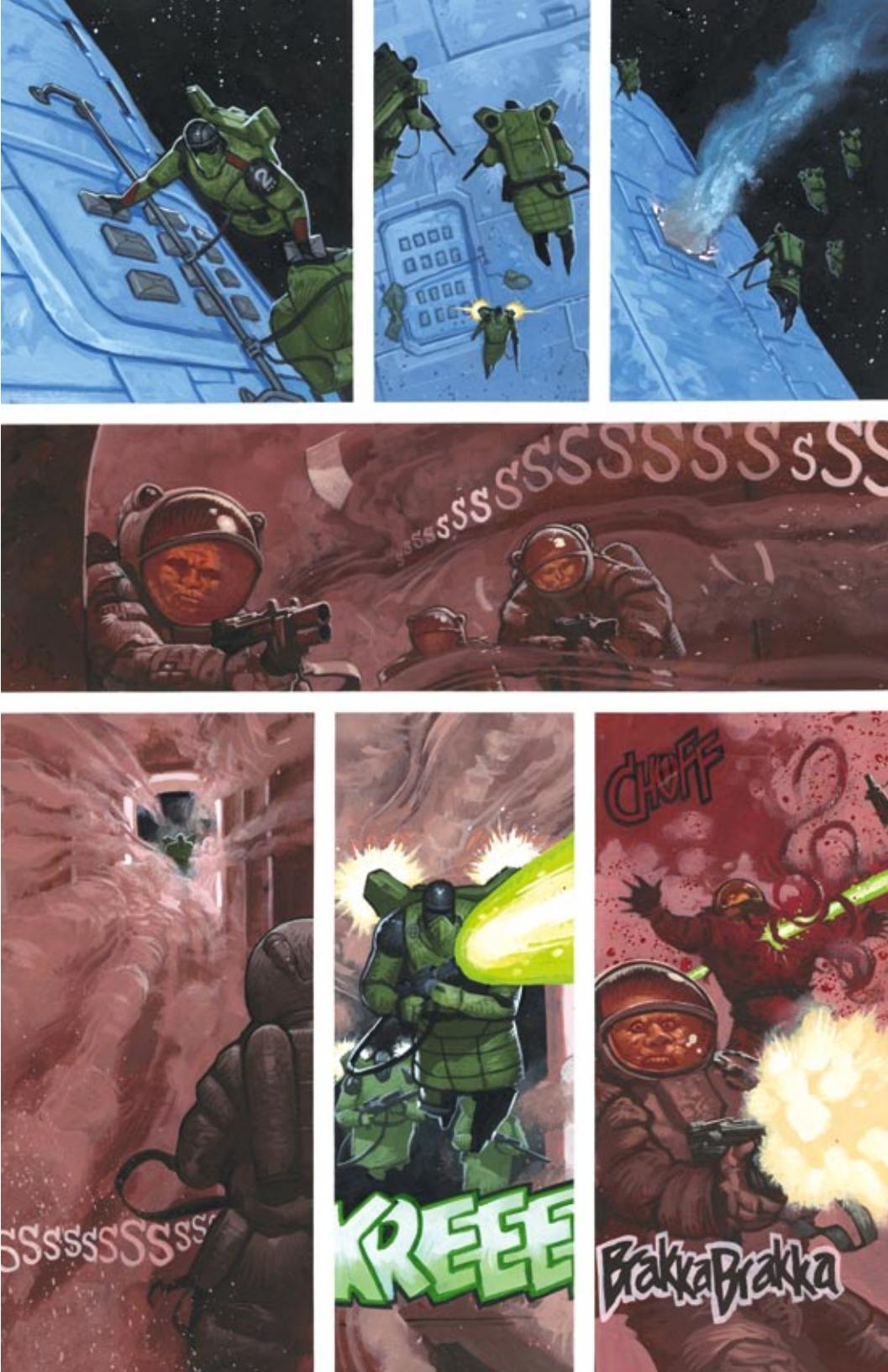
CHOOF? Moeller, come on, that's--- okay I'm not gonna front, this art is fucking gorgeous.
Wounded dice are subtracted from stats, Skills and Steel. A skill reduced to zero by wound penalties can't be used by the character: it can't be rolled, used to help or FoRKed. A stat reduced to zero means that the character is incapacitated or unconscious. Any time a character takes -1D or more of wounds, test Steel (with the penalty thrown in before the roll), and on a fail the character hesitates. When a character takes a Mortal Wound, they go down instantly, and then they either die on the spot or, by spending one persona point, they hold on to life and have a minimal chance of recovery. Three Injuries cause a Maimed result. A Maimed result that isn't treated in the next building scene progresses to a Mortal Wound. A Mortal Wound must be treated on the spot, or else. To treat a wound, test Field Dressing or Surgery (the latter skill has easier obstacles, but it's harder to get). Successful Treatment stops the bleeding to begin with. Extra successes can be added as advantage dice to recovery. If a player believes their character isn't competent enough, they may try to staunch the blood flow (-1 to Obstacle), which gives the wounded character another scene before they start bleeding out. Recovery is a Forte test after treatment. Superficial wounds don't require recovery. An Injury is an Ob 2 test, or Ob 3 for two Injuries. If successful, the wounded dice are restored. If failed, the character gets a new trait that reduces 1D of a skill permanently, increases hesitation in 1 or future obstacles in 1. The player may choose the skill, but no -wises. The trait can be something like Old War Wound, Missing Finger, Jumpy, etc. A Maimed wound is an Ob 4 test to recover. On a failure, the character gets the Maimed trait, and lose 3D: at least 1D from a stat, then the other two from non-wise skills. The maximum cap of the damaged stat is also reduced in one. Maimed damage takes two maneuvers or downtime to heal completely.
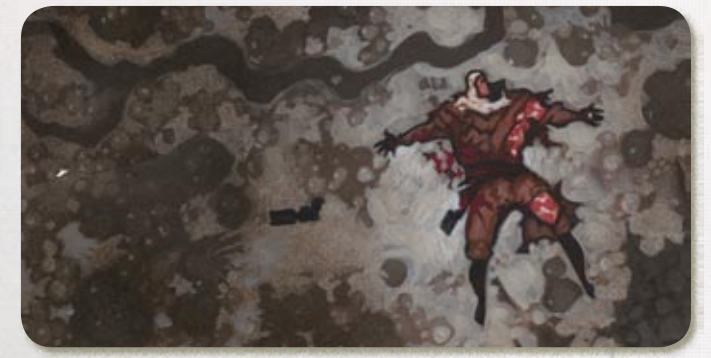
It's just a Superficial!
On a Mortal Wound, the Forte obstacle is 6. Then: if treatment and recovery succeeded, the wound heals as a Maimed wound. If treatment succeeds and recovery fails, the character gets a "Nearly Died At X" trait where X is where they took the hit, and the margin of failure is subtracted from their stats. If treatment fails but recovery is successful, they gain the "They Never Put Me Back Together Right" trait and lose 1D from a stat and two from skills of the player's choosing, and also see their Mortal Wound tolerance reduced in one. They may come back after two maneuvers or downtime. If both treatment and recovery fail, the character dies for good.
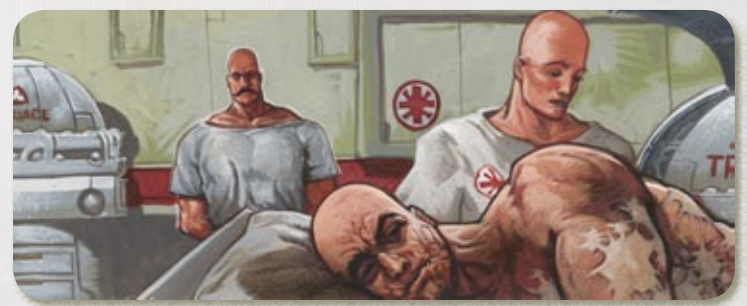
"Did the boss blew himself up with his own plasma pistol?" "Yeah, he did." "Again?" "Yeah, again."
Next: still 100 pages left yo
Get in the power armor, Shinji
Original SA post Burning EmpiresGet in the power armor, Shinji
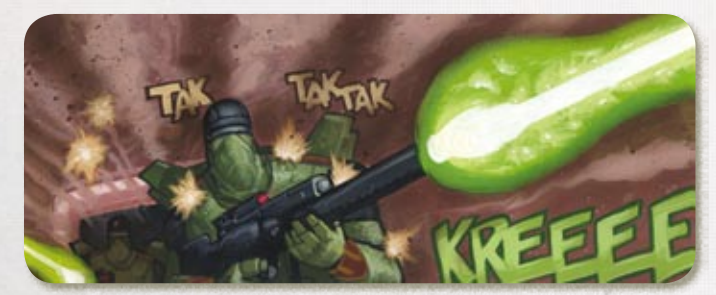
Is SKRULL a good sound effect?
Assorted bits this time. First, let's talk about armor . As far as the Empires are concerned, there's iron, and then there's everything else. Armor is rated by its armor tolerance (AT) , which is straight up added to the character's physical tolerances when worn. So a suit of anvil armor (AT 3) worn by a H10 Mortal Wound character pushes it to H13, and in turn raises their Superficial, Injured and Maimed scores. Armor is not location specific, it's assumed that the more severe the damage the character takes the more vital the area they were hit in. There is ballistic body armor in simple vest and helmet (AT 1) or full body armor (AT 2) flavor as the cheap low-cost alternative, "seen primarily among backwater planetary armed forces, planetary law enforcement and civilian military enthusiasts", which I guess means this is the equivalent of LARPer gear in the grim darkness of the wormy future. Anvil armor (AT 3) is heavy body armor used by military and poor nobility in low index worlds and is the baseline protection for most soldiers in the Iron Empires. Anvil armor is EVA-capable, has vision enhancement technology and internal comms, but it's cumbersome to wear unless the character is Anvil-trained.
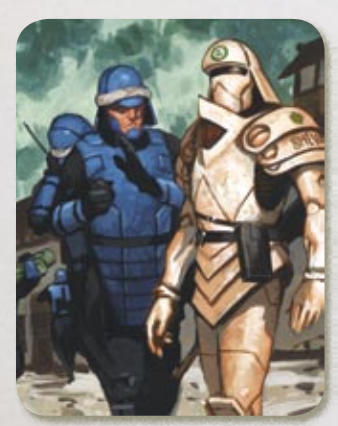
Left: ballistic body armor. Right: anvil armor. Not pictured: the horde of Vaylen mutants about to jump them.
Iron (AT 4) is the easter egg of doom, the platonic ideal of the pauldron, and what the Iron Empires name themselves after. It's hard to use (needs both Iron-Trained and Corvus and Crucis traits) and terribly expensive, but it comes with a myriad perks, notably among them the ability to reduce all incoming vehicular scale damage to the human scale (so a V7 hit from a cannon becomes H7, tough shit but survivable). It also comes with a reservoir of medical 'foam' that patches up wounds, an 'avatar' detection suite with its own Signals and Sensors skills, a fusion pack to power the suit and its weapons, extra strength, shielded communications, and so on. Iron comes in Index 4 and Index 5 flavors: Index 5 is slightly better. On the other hand, aside from the heavy training required to use it, iron is completely unable to be concealed and makes the user slightly clumsier. Both iron and anvil armor penalize the user's Perception, Observation and Recon skills slightly, but they can remove their helmets to negate that penalty (AT is reduced in one). Armor may be damaged by weapons with armor-destroying qualities - fusors, fusion guns, armor-piercing grenades.
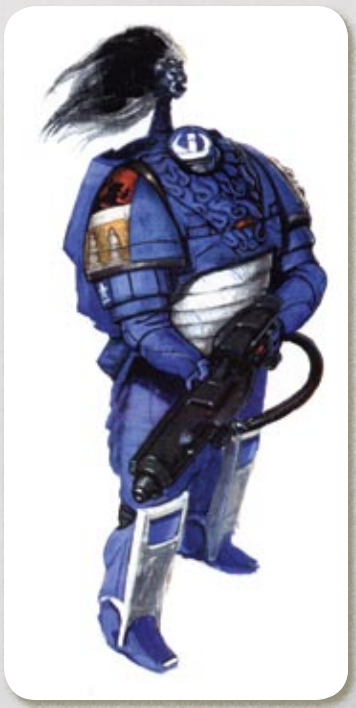
It's kind of
 to me.
to me.
Vehicles! When dealing with vehicles, first we have to figure out what the vehicle actually means for the game. If it's just part of the description of the scene, then it's just color and needs no mechanical base. Sometimes the vehicle is a carrier for another piece of technology - weapons, cargo, sensors and so on. In this case it's the piece of technology that needs rolls and stats, not the vehicle. And sometimes the vehicle itself is what matters. Generally, if the vehicle is only useful for the journey, then only its pilot's skill matters. If the ride itself matters (for instance, if a specific type of vehicle is necessary and none other will do), then a Resources test to acquire the vehicle, a Circles test to find a pilot or a -wise to find just the right thing will do, and you don't bother with the actual piloting - skip straight to the action.
When vehicles need actual mechanical weight, they get a statline. A vehicle's stats are type , which tells us what the vehicle is and what skills to use. It has a Tech Resources obstacle and a Tech Index. It has a Capacity for people. It has Profile , the overall bulk and energy output of the vehicle and is added as advantage dice to someone using Sensors to track the vehicle. It has Integrity , which is the vehicle's Forte stat and that is reduced by damage. It has Control , which tells how hard or easy to handle the vehicle is; it's either an obstacle or a number of advantage dice. It has Ordnance , which indicates what weapons the vehicle carries, if at all. It has a Vehicular Speed that represents how fast the vehicle can travel and is graded in three ranks: Surface Speed, Atmospheric Speed and Space Speed. It has Signals to represent the vehicle's comms and electronic warfare suite, Sensors as its instrumentation and detection gear, and Security to indicate if it has intrusion-prevention devices and internal security for the crew. And finally it has Structural Tolerances , like physical tolerances for people, rated similarly as Surface, Breached, Damaged and Destroyed. We then get a number of generic vehicles, from cars and ground buggies all the way to heavy hammer ships.
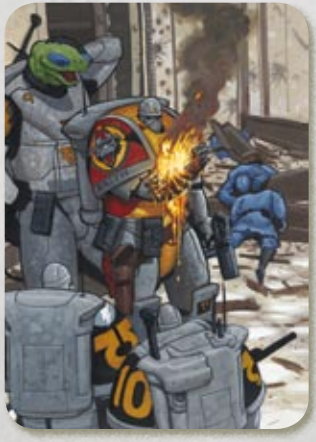
Oh bother, my arm is on fire.
Chases and pursuits are important. If two vehicles are racing and have the same speed then it's just a versus test of each pilot's respective skill. If one has a different Speed category, then Speed is tested with a double obstacle penalty for the lesser speed. In an escape or pursuit, the fleeing vehicle and the pursuer may use its pilot's skill or Vehicular speed. Sensors vs Signals may act as a linked test. Firefight works mostly as is, since it can encompass tank battles and orbital bombardments as well as squad-based action. Positions and cover are set, initial rolls are made and so on. In a set-piece battle involving wings of hammer cruisers in space, Tactics may be replaced by Strategy, but only there. In close combat, vehicles use their own set of actions:
-
Ramming
: (Helm/Pilot/Driving) Ramming speed, Lieutenant. Ob 3 against Weapons Fire, Ob 2 against Torch. Damage is 5/9/13 with an artillery DoF, at a scale equal to the ramming vehicle's Destroyed tolerance. The target takes the DoF hit, while the ramming vehicle takes it one step down - so if it dealt a Superb hit then it merely takes a Mark. Only one Ramming action per Close Combat per unit - the vehicle must Withdraw and script another Close Combat to get enough speed.
-
Weapons Fire
: (relevant weapon) The vehicle must use secondary weapon systems. If it doesn't have them, it can't shoot in Close Combat. Ob 1 against Ramming and Torch, Ob 2 against another Weapons Fire.
-
Under the Guns
: (Helm/Pilot/Driving) the vehicle attempts to move out of the target's field of fire. If it has a higher Integrity than the target, the difference is applied as an obstacle penalty. If successful or tied, the vehicle can't be shot, rammed or torched.
-
Torch
: (Helm/Pilot/Driving) This one is weird, as it mentions all three piloting skills but can only be used by intrasystem, interstellar and intergalactic ships. Basically, the pilot angles the ship so that its thrusters damage the enemy. Ob 4 plus Speed difference if the target is faster against independent actions. A successful Torch deals damage equal to the vehicle's Destroyed result to one system of the player's choice. If failed, the next Firefight action of the vehicle takes an obstacle penalty equal to its margin of failure.

GUDDA GUDDA GUDDA
Vehicles may launch a subsidiary vehicle as a specialist action. If one side wishes to board another, then that's their objective for the Firefight. The boarding action itself can be played as a follow-up Firefight if need be.
Damage! A shot opportunity's successes on a vehicle can be spent to improve the DoF roll as normal, or used to target specific systems. There is the hull of the vehicle, the default location. Wound dice are subtracted from its Integrity. For two successes, the shooter may aim at the vehicle's Control systems. Each die of damage done subtracts from the ship's Control rating, or gives it obstacle penalties if it has no Control bonus. It costs three successes to deliberately aim at the pilot or crew of a vehicle, and the hit must cause at least a Breach result. The crew is hit with damage one rank lower than the initial hit on the vehicle. Up to three character may be hit on a Damaged result. For one success, the Engine may be targeted, and on a Breach or Damaged result the dice are subtracted from the vehicle's Speed. If it hits zero, it can no longer move. With three successes, the target may be the vehicle's Signals rig, reducing its rating by the damage dice. With three successes, its Sensors may be targeted, and it only takes 1D of damage to knock them out. Two successes allow targeting a weapons system - 1D for a non-Mounted weapon, two for a Mounted one. If any subsystem takes a Destroyed system, it's gone but the vehicle itself is not. Once a vehicle loses all of its Integrity dice or is hit with a Destroyed result, it's out of commission. Ob 6 Driving/Helm/Piloting test to prevent from crashing if the vehicle was in motion on the surface or in atmosphere. If this test fails, the vehicle is Wrecked , and each character has to roll a d6 - on a 1 they survive without harm, on a 2-5 they're Maimed, and on a 6 they take a Mortal Wound. A wrecked space vehicle decompresses and opens to the void, and anyone not in an EVA suit or similar takes an H16 wound.
Travel! Generally, travel within a city or a planetary region is pretty much color and shouldn't be a problem except on the most backwater sub-index worlds or the most paranoid, quarantined and regulated outworlds. Intercontinental travel on sub and zero-index worlds needs to be part of a maneuver's color to happen, even if it is not its primary goal. Travel to and from orbital stations isn't usually harder than travelling to another city. Travel between planets and stars is accomplished through distortion drive technology. It generates a field that warps the value of time within it, allowing for faster than light speed. Travel within planets in a system is more laborious than intercontinental travel and is best described as part of a Go to Ground, Conserve, Gambit or even Take Action maneuver. Travel to other systems takes a significant amount of time: it can only be made using Conserve and Go to Ground maneuvers, and it must be the intent of the maneuver.
Security systems! Sub-index Security can detect characters using the Infiltration skill. Zero index tech can detect Infiltration and Falsehood if the target is under direct, restrained scrutiny. Low index tech can detect and record Signals, Falsehood, Sleight of Hand and Infiltration. High index tech can detect and record Psychology, Signals, Security, Falsehood, Inconspicuous, Infiltration and Sleight of Hand. When a character wishes to get past a security checkpoint, they must test one of those skills against the system - either against its operator or the system itself if it's automated. If the security system wins, the character is detected as having used the skill. It's an Ob 2 test to detect contraband of the same tech index and +1 Ob for each index level lower, so it seems that it's harder for a supercool high index system to detect a box cutter than a plasma pistol. Vaylen did 9/11! Though each index level higher than the security system adds a +2 Ob so I guess it's harder to detect that plasma pistol with a pat down check. A security systen may also have the Obstacle trait to represent things like locked doors and vaults: Security, Security Rigging or Explosives to bypass them. It says here that "a failed test indicates that the system is alerted and reports an unauthorized entry", so by RAW Explosives don't set off alarms. Well, if there's no alarm left in the first place, I guess this is right.
 Most systems record information about their operation, and it's an Ob 6 - advantage dice or exponent of the security system to extract useful data from it. Detecting Vaylen on the fly requires at least low index tech: Ob 3 for a field hull, Ob 6 for a spinal hull and Ob 7 for an optic nerve hull. Any sub index brain scan will show the presence of a Naiven in the brain, but good luck getting a Vaylen to submit willingly.
Most systems record information about their operation, and it's an Ob 6 - advantage dice or exponent of the security system to extract useful data from it. Detecting Vaylen on the fly requires at least low index tech: Ob 3 for a field hull, Ob 6 for a spinal hull and Ob 7 for an optic nerve hull. Any sub index brain scan will show the presence of a Naiven in the brain, but good luck getting a Vaylen to submit willingly.
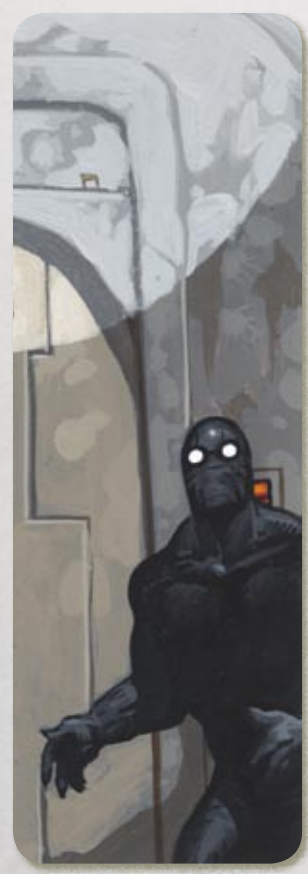
We Mike Mignola now.
Signals technology includes all sorts of broadcast and detection equipment: radio traffic, communications jamming, satellite imagery and so on. It comes in the forms of tools, advantage dice and technological skill. Ob 2 check to monitor open comm traffic and other communications. Versus Signals tests if one wants to send transmissions in bursts. When scanning for emissions, +1D advantage for each index of tech higher than the target signal being broadcast, +1 Ob for each index lower. In a versus, the more advanced gear gets +1D for each index. As we saw in the Firefight rules, Signals can be used to fuck with enemy communications in Firefight. In a building scene, it can be used to jam a transmission (versus Signals test), or flood the airwaves with noise: all "dumb" communications equipment ceases to work and other Signals gears operates with an added obstacle equal to the margin of success in a versus test.
Sensors are designed to detect heat, radioactivity, EM emissions, atmospheric displacement and distortions in spacetime. In sub or zero index worls, sensor arrays are large and elaborate, only installed in vehicles and instalations and even then they just count as tools. Low and high index worlds have sensor arrays that can be mounted on armor or in handheld devices. Sensors can be used for Sensor Sweeps in Firefight. Cover reduces a vehicle's Profile in 1 less than the cover's value, so Cover 2 reduces Profile in 1D. Sensors can be pushed into double-duty as Security or Signals by recalibrating them, but they operate at a double obstacle penalty.
Next: "when assaulted, fry their brains."
Shank the shrink
Original SA post Burning EmpiresShank the shrink
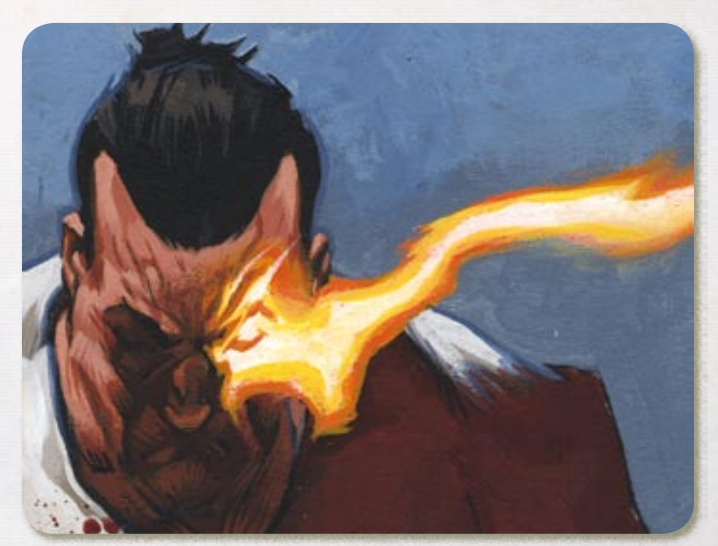
Spooky! Eventually due to use the Bright Mark ends up scarring the psychologist permanently, even glowing when their powers are not in use.
Psychologists have the ability to influence and shape the thoughts of others. It is born from the psycholgist's inner energies and sharpened by intense training. To use Psychology as it's meant to, a character must have the Bright Mark or Mule traits. Neither of these is available for trait vote - they must be bought at chargen. The only difference is that while Bright Mark makes a shiny brand appear on the character's face when they're using their skill, Mule means the character has no outward signs of being a psychologist, Foundation-style. Of course, Mule is much rarer in lifepaths and expensive in trait points. By itself, the Psychology skill lets the character read, predict and manipulate human behavior: Alone, it lets a character figure out (among other things) a target's mood, traits, past lifepaths, Naiven (at Ob 3, natch), intents, connections, reputations, affiliations and even Beliefs. But when a character has one of the two magical traits, then Psychology can bring out its true potential.
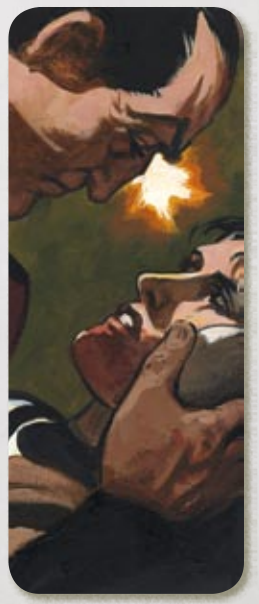
Bad Psychological Touch.
To tap into many of these higher level abilities, a psychologist must forge a connection between them and the target. This represents the psychologist finding an easy 'in' in the target's mind. To do so, the player (at the table!) must physically offer a die to the target and ask if they want to forge a connection with them. If accepted, this die may be used as an advantage die for most social skills - unless the target of the connection is another psychologist, in which case no such bonus happens.. The target may also broadcast their thoughts to the psychologist and accept their transmitted thoughts in return, from any distance. The psychologist has a psychology pool equivalent to their Will to hand out connection dice. The remainder of the pool is known as the barrier , which protects the character from psychic assault (+1 Ob to attempts to read the character); a psychologist that opens up too many connections is leaving themself open to attack. The psychologist may send and receive thoughts to the target, hear what they're physically saying, and read their surface thoughts - which normally is barely useful, just as a way to obtain a jumbled sense of physical presence. A psychologist has +1D to read a connected target, as per the Psychology skill, and can do so no matter the distance. A fellow psychologist gets to add their current barrier as an obstacle to be read. It's possible to have more than one connection in a single mind from different psychologists, but the target only gains +1D no matter how many they are. Psychologists can roll their skill against a target's current barrier to boot them out of someone else's head.
Now, letting go of the connection is tricky. The psychologist's player must ask for their die back at the table: the target may agree, or say that "complications" have happened and keep the die. It remains with the target until it rolls a natural 1. If another psychologist is the target, then their Psychology FoRK stands in for the connection die: if they're using it in a test not related to their connection and it rolls a 1, the connection is lost. The GM must give connection dice back if asked when the connection is with a minor NPC. Connections must be broken at the beginning or the end of a scene, never during. It is perfectly agreeable to set conditions for accepting and relinquishing connections out of character.
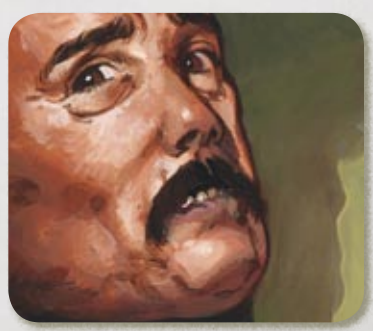
Poor guy. Mindwiping worms in one side, mindfucking humans in the other.
A psychologist may transfer a skill to a connected character. The character temporarily gets a skill the psychologist has at its exponent or the psychologist's pool, whichever is lower. If a social skill is transfered, the connection die may not be used. The target chooses whether to use the psychologist's skill or their own, if they have it. It counts as a normal test. A psychologist may not force the target to use a skill at a lower exponent. To trip up a connection, the psychologist may use hindrance : It costs 2D of the psychologist's pool to give +1 Ob to any one of the connection's skills during a scene. This must be done before the character's intent is announced, and the hindrance must stay at the same level during the whole scene. This does mean that the psychologist's barrier is reduced by hindrance, making them vulnerable when they're fucking with someone' head. It can be used as part of the psychologist's conflict scene for a maneuver, or as a building scene if used in someone else's conflict scene or in a scene in which the psychologist is not present. The psychologist may also lock the connection: Psychology + 1D test against the enemy's Will as an obstacle (plus the barrier if the connection is another psychologist) If the psychologist wins the target must pass a Steel test or be paralyzed. The lock ends at the end of the scene or when the psychologist wishes it to be so, and it costs 1D from the psychologist's pool to maintain the lock. If a player is locked out of a scene they initiated, it does not count against their limits for the maneuver, but neither can they use the same intent when they get to act again. There's a big warning here as the lock is potentially very abusive.
quote:
Don’t ruin anyone else’s fun for the sake of the tired old canard, “That’s what my character would do.”
But my competitive game where everyone is out to win! Anyway. All of these abilities need the target character to accept the connection first. When a character won't accept that connection or the psychologist wants to rewire the target fundamentally, it's time to break out the Psychic Duel rules. The Psychic Duel works about the same as the Duel of Wits mechanically, except that characters are dueling with ideas and thoughts instead of words. Remember how the Duel of Wits was explicitly written as not being mind control and having the possibility of walking away at any time? Fuck that: this is mind control. The psychologist may have as a statement of intent the addition of a character trait or the modification of one of the target's Beliefs. The target may pervert this statement of purpose or demand a connection or breaking of a connection as part of their goals (but the psychologist may not demand a connection, oddly enough) They may not add traits or modify Beliefs back unless they too are a psychologist. The psychologist does not need to have a connection to the victim to initiate a duel, but if they do have one they may do so from anywhere. The Psychic Duel uses Psychology for all actions, while Intimidation and Ugly Truth can also be used in the Incite action. Characters without Psychology test Will at double penalty. The body of argument is generated just like in a regular Duel of Wits, but for unskilled victims it is always a big deal and therefore they get to double their Will for their body of argument. A psychologist's barrier is also added as body of argument points. It's kosher to have as a statement of purpose "you'll never tamper with me or mine again" or "you'll never show yourself before me on pain of death" and so on. The Psychic Duel may not be used in a Firefight, unless I Corner Him And Stab Him In The Face comes into play and the psychologist wins the Tactics/Close Combat test or has as Instinct something like "when assaulted, fry their brains."
A psychologist may sense other minds around them (Psychology counts as Observation against Infiltration, Inconspicuous and Sleight of Hand) and they may use the Psychologist's Touch to share senses and memories with a connected individual (Psychology vs Perception, if the psychologist wins the target remembers nothing of the touch, if the target wins they remember one detail per success, either side can get a linked test for a follow-up Duel of Wits). The psychologist may also tamper with their own body chemistry. They may boost themselves by removing internal failsafes and rewiring themselves, gaining dice to Perception, Agility, Speed, Power or Forte with a Psychology test equal to the stat's current exponent (margin of success is added). This bonus only lasts for one test, and after that the character is reduced by the same number of dice as it was increased. Forte test with an obstacle equal to the bonus dice granted: if it succeeds, the fatigue goes away at the end of the scene. If it fails, it stays until the end of the maneuver. Finally, as a last-ditch measure against Naiven infiltration, the psychologist may use Psychological Toxicology to turn their body chemicals into poison and attempt to kill the worm. Psychology against Ob 4: both the psychologist and the worm take a H4/H7/H10 assault weapon hit. Margin of failure is added to the DoF roll. The Naiven has a Mortal Wound of H7, and it is possible to kill both the psychologist and the worm with Toxicology.
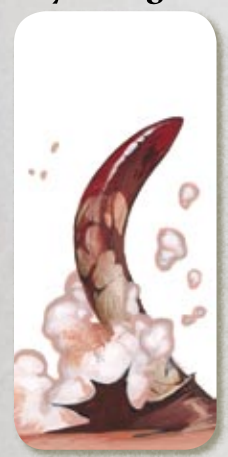
Worms are gross yo
Next: murderbears of your nightmares
The final stretch, now with more custom-made gribblies
Original SA post Burning EmpiresThe final stretch, now with more custom-made gribblies
imgur is being a butt for images, I'll try uploading them later. Or not, maybe.
Now we get to see the Alien Life Form Burner rules. There are many lifeforms through space, but there are no sentient creatures other than humans and what the Vaylen have created. These rules allow the creation of all sorts of creatures from random rats all the way up to "Space Kraken" (Fading Suns much?). The rules are meant for the GM, and as such have no real balancing mechanism: it's up to the GM to make things properly. Which, again, kind of conflicts with the idea that the GM wants to win the game. Part of these rules are also used by the Vaylen side to create host bodies and eugenetic creatures, though, so not everything is eyeballed.
To create a life-form (such as those that must exist if the Indigenous Life-Forms faction is chosen), first come up with a concept. Top predator? Hunter? Peaceful megafauna? Some alien purpose? Then we get a list of stat exponents to choose from. Each has a description: for instance, Will 3 is "A little gullible, like most of us." Generally, exponent 4 stats is the human baseline. The Vaylen can't create creatures with Will or Perception higher than 6. Creatures start by default with human-scale Mortal Wound and Speed, but they may get the Mammoth or Leviathan traits to raise their Mortal Wound to vehicular or superstructural scale. Their Superficial tolerance is their Forte exponent in the next lowest damage scale. Injured is Superficial + Forte, moving on to the next scale if it goes beyond 16. Maimed is Mortal Wound - Forte. Incidentally, Superstructural 16 is the highest damage tolerance in the game. In the same manner, a fast ground creature has Ground Speed, a flyer has Atmospheric Speed, and a spaceborn creature gets Space Speed.
Next, we look at the creature's skills, and for that we have to figure out its occupation. An occupation is a suggested list of skills for a creature, not a hard limit or anything. For instance, a slave or domesticated beast can have Back-Breaking Labor, Begging and Inconspicuous, while a parasite can have Observation, Host-wise, Host Anatomy, and Infiltration. Care must be taken here to reduce the skill list to the bare minimum: a Vaylen mutant meant to capture humans for later hulling needs little more than Infiltration and Close Combat. We then get a cheat sheet to figure out how many skill points they should get. Again, care should be taken as a skill point buys more or less depending on the skill's root stat. 11-15 skill points gets a creature with average stats a smattering of exponent 4 and 5 skills. Now, alien traits. First the color traits must be determined, those that make the creature alien while having no actual effect in play. Body type, fur, etcetera.
Then it's up to the traits with mechanical effect, and for that we jump to the Trait Burner. This is similar to the Technology Burner rules, even including a points cost for each trait. For GM-made creatures, this cost is solely used to eyeball their mechanical weight. A trait can give Inhuman Ability : they allow a test where the creature should not get one (breathe underwater), or forgo a test that it should make (a Steel test for getting hit). Superhuman Speed and Stature are also traits with trait point costs. Traits can also give Natural Advantage , giving advantage dice to a skill, or Natural Obstacle , giving other characters and creatures obstacles to specific tests. A creature may also have a Natural Disadvantage , getting raised obstacles or straight up losing dice, and note that this still costs trait points. Traits can give Natural Armor (i.e., AT) and Natural Weapons that are pretty much reskinned weapons from the Firefight chapter, so a spine thrower may be a stet gun or assault gun in play. Each weapon gets a points cost, and larger creatures can mount vehicular weapons or even artillery. Inhuman Skill makes a creature's skill dice open-ended, rerolling natural 6s, or they can get Reduced Hesitation. Finally, a trait can Tweak a creature, either by changing how dice are rounded to factor stats (i.e. making them round up instead of down for Mortal Wound) or straight up cheating (my super hunting creature can use Hunting instead of Tactics in a Firefight!) After that, total stats, don't bother with reputation or Circles unless you have a very good reason, and total the trait points. Done!
The Vaylen can design creatures of their own. This is called Vaylen Eugenics, and can be done before the game starts or during play. A Vaylen character with a Shudren, Vaishyen or Ksatriyen body gets a number of trait points to buy from the Trait Burner. Ksatriyen can get up to 5 points from Natural Disadvantage, Natural Weapons, Natural Armor, Reduce Hesitation and Inhuman Ability. Shudren can get up to 8 points from any category except Natural Advantage. Vaishyen can get 6 trait points from Natural Disadvantage, Inhuman Skill, Inhuman Ability, Natural Advantage and Tweak. Vaylen characters can also use lifepath trait points to buy alien life form traits. The GM may also create a brand-new host body for a Vaylen, or a Vaylen may decide to create a new host in play. First, determine if the host is sentient and sapient or animal. A Naiven in an animal body loses access to all social skills it may have had except Begging and Intimidation, as well as all academic and tool-using skills. Relevant wises to the creature's occupation may be kept. In play, the Vaylen may only create bodies in a Conserve or Inundate maneuver that uses Eugenics as their skill. The Vaylen does not necessarily have to win the maneuver, however. The Eugenics process is much more regulated than GM creation of creatures: the body's highest stat is the obstacle for stats, compounded by each skill the eugeneticist wants the new body to have (it's much easier to punt in a Naiven with some Shudren experience than force-grow skills into a body) and each alien trait. All Eugenics projects get a Naiven Tube for free unless the eugeneticist removes it, at no cost. After that, it's an Eugenics test to get the body, and half of the obstacle can be taken for a Resources test as the Vaylen buy up bodyparts and whatnot. The sample monster in the GM section has 57 trait points, which is just
 to roll even if you're Tentacle Mengele - and that's kind of weird, since the sample monster is the ganasch, the murderbear mook from Sheva's War and a signature example of Vaylen creating monsters to fight their battles for them.
to roll even if you're Tentacle Mengele - and that's kind of weird, since the sample monster is the ganasch, the murderbear mook from Sheva's War and a signature example of Vaylen creating monsters to fight their battles for them.
And then we get into the final stretch. There's a Playing the Game chapter with practical considerations for the game. Getting a comfortable place to play, snacks, everyone on time and so on. BE can be very competitive but at the end no one is really trying to fuck each other. Everyone wants to have fun and make the others have fun, right? This isn't a Wickgame. Really. Then we get a baseline for a campaign - setting the first session apart for world and character generation, getting everything that needs done now ready. The GM must have the important NPCs like Figures of Note made, no vague concepts. When play actually begins in the second session, then game can begin. The GM has the option to fire off the first situation, but the first maneuver must be agreed on before continuing. After that, get in, get shit done, challenge Beliefs, progress towards goals. After the maneuver plays out and things come to an end, reward artha, review Beliefs and Instincts, make a bathroom check if necessary, play the second maneuver if you want to. And remember not to choose a maneuver at the end of the session! The rest of the sessions play out much the same, with the GM recapping the action of the previous session before beginning. Once a side hits 10 disposition or less, all stops should be pulled out: go for broke, show no mercy, take the enemy down with you if you're losing. Then it's the epilogue, the group talks about how everything ended and if they want to play on to the next phase. The group can use a Planetary Web to lay out the situation of the world and check at a glance the priorities of the players and the GM's characters. Then there's a list of sample hooks for the GM to challenge the players, divided by each phase. In Infiltration: bribe officials, infiltrate the black market, become a member of an opposing or vulnerable faction, establish a base of operations - either in a remote location or right under their noses. In Usurpation: kidnap a rival's children, extort information from corrupt officials, convince a person to spy for your side, manufacture "anti-Vaylen" gear and then hull everyone in sight. In Invasion: order an attack from the front, destroy the enemy's property, assassinate an enemy general, round up civilians, hull them and send them to the opposing side as "refugees," bombard something from orbit just because it is possible. I like these a lot as plot seeds, really: they show what the GM's characters should be striving for. Everyone should be building up towards the big conflict. You want allies, you want resources, you want to make sure they're not going to the other side. Use color, interstitials and building scenes to gather up all that you can use, use small conflicts to clear the way, make those compromises hurt and then bring all the help you can to bear for when shit goes really down around the fifth or sixth session or so. Talk about the big-picture stuff and how it interacts (or fails to interact!) with the ground-level scenes.
So what about the GM? The GM's characters, points and such only have one purpose: to provide conflict for the players. The GM may not disregard rules as they deem fit and players are right to call them out on it. The GM does not create the story, it emerges from the challenges they present to the players and how they go on about achieving their goals. The GM doesn't have to play God, they must just try their best to win, within the framework of the rules. This explicitly doesn't mean "rocks fall, everyone dies" because that's dumb. You want those rocks to fall? Get them in orbit, make a Gambit, Inundate or Take Action maneuver. Even if the GM does defeat the players in a phase, victory is not total: only the phase objective is achieved, everything else is talked out in the epilogue. The GM gets a few perks (setting obstacles, those little Infection mechanics tidbits and so on) but again, they're trying to win, not to fuck the players over. The players, on their side, have the responsibility to know the rules and use them. They have to use them to their advantage. They must push their characters into conflict, they must introduce color to embellish conflict. And above all, everyone should have fun.
Then there's a list of sample minor NPCs for Circling up and if you need mooks for a Firefight, an index (with a separate lifepaths index!), the character sheet, and BE is done.
I like the idea of BE a lot, to be honest. The actual gameplay, well... I really feel like trying it, I do. I do have some qualms with the rules, particularly the way Resources obstacles mount up and wondering how PCs buy anything of importance outside of chargen, or the mandatory lifepath traits meaning that for instance every single signals tech in the Iron Empires is a twitchy mess - but hell, I'd give it a shot and see how it plays out. I wish that bit about the GM not going full viking hat was up front, really, because BE has this reputation of "super complex game where the GM has to fuck you over because everyone wants to win" and as we can see, while the game has a competitive element, it's not an us versus them thing. We all want to have fun even if our characters are murdering each other, right?
Anyway, that's it. Hope you liked it.